Chaweewan chuchuay Stock Photos and Images
 Nepal: Hashish-smoking sadhu, Pashupatinath, Kathmandu. They are known, variously, as sadhus (saints, or 'good ones'), yogis (ascetic practitioners), fakirs (ascetic seeker after the Truth) and sannyasins (wandering mendicants and ascetics). They are the ascetic – and often eccentric – practitioners of an austere form of Hinduism. Sworn to cast off earthly desires, some choose to live as anchorites in the wilderness. Others are of a less retiring disposition, especially in the towns and temples of Nepal's Kathmandu Valley. Stock Photohttps://www.alamy.com/image-license-details/?v=1https://www.alamy.com/nepal-hashish-smoking-sadhu-pashupatinath-kathmandu-they-are-known-variously-as-sadhus-saints-or-good-ones-yogis-ascetic-practitioners-fakirs-ascetic-seeker-after-the-truth-and-sannyasins-wandering-mendicants-and-ascetics-they-are-the-ascetic-and-often-eccentric-practitioners-of-an-austere-form-of-hinduism-sworn-to-cast-off-earthly-desires-some-choose-to-live-as-anchorites-in-the-wilderness-others-are-of-a-less-retiring-disposition-especially-in-the-towns-and-temples-of-nepals-kathmandu-valley-image344237531.html
Nepal: Hashish-smoking sadhu, Pashupatinath, Kathmandu. They are known, variously, as sadhus (saints, or 'good ones'), yogis (ascetic practitioners), fakirs (ascetic seeker after the Truth) and sannyasins (wandering mendicants and ascetics). They are the ascetic – and often eccentric – practitioners of an austere form of Hinduism. Sworn to cast off earthly desires, some choose to live as anchorites in the wilderness. Others are of a less retiring disposition, especially in the towns and temples of Nepal's Kathmandu Valley. Stock Photohttps://www.alamy.com/image-license-details/?v=1https://www.alamy.com/nepal-hashish-smoking-sadhu-pashupatinath-kathmandu-they-are-known-variously-as-sadhus-saints-or-good-ones-yogis-ascetic-practitioners-fakirs-ascetic-seeker-after-the-truth-and-sannyasins-wandering-mendicants-and-ascetics-they-are-the-ascetic-and-often-eccentric-practitioners-of-an-austere-form-of-hinduism-sworn-to-cast-off-earthly-desires-some-choose-to-live-as-anchorites-in-the-wilderness-others-are-of-a-less-retiring-disposition-especially-in-the-towns-and-temples-of-nepals-kathmandu-valley-image344237531.htmlRM2B01ADF–Nepal: Hashish-smoking sadhu, Pashupatinath, Kathmandu. They are known, variously, as sadhus (saints, or 'good ones'), yogis (ascetic practitioners), fakirs (ascetic seeker after the Truth) and sannyasins (wandering mendicants and ascetics). They are the ascetic – and often eccentric – practitioners of an austere form of Hinduism. Sworn to cast off earthly desires, some choose to live as anchorites in the wilderness. Others are of a less retiring disposition, especially in the towns and temples of Nepal's Kathmandu Valley.
 Nepal: Sadhu, Pashupatinath, Kathmandu. They are known, variously, as sadhus (saints, or 'good ones'), yogis (ascetic practitioners), fakirs (ascetic seeker after the Truth) and sannyasins (wandering mendicants and ascetics). They are the ascetic – and often eccentric – practitioners of an austere form of Hinduism. Sworn to cast off earthly desires, some choose to live as anchorites in the wilderness. Others are of a less retiring disposition, especially in the towns and temples of Nepal's Kathmandu Valley. Stock Photohttps://www.alamy.com/image-license-details/?v=1https://www.alamy.com/nepal-sadhu-pashupatinath-kathmandu-they-are-known-variously-as-sadhus-saints-or-good-ones-yogis-ascetic-practitioners-fakirs-ascetic-seeker-after-the-truth-and-sannyasins-wandering-mendicants-and-ascetics-they-are-the-ascetic-and-often-eccentric-practitioners-of-an-austere-form-of-hinduism-sworn-to-cast-off-earthly-desires-some-choose-to-live-as-anchorites-in-the-wilderness-others-are-of-a-less-retiring-disposition-especially-in-the-towns-and-temples-of-nepals-kathmandu-valley-image344236996.html
Nepal: Sadhu, Pashupatinath, Kathmandu. They are known, variously, as sadhus (saints, or 'good ones'), yogis (ascetic practitioners), fakirs (ascetic seeker after the Truth) and sannyasins (wandering mendicants and ascetics). They are the ascetic – and often eccentric – practitioners of an austere form of Hinduism. Sworn to cast off earthly desires, some choose to live as anchorites in the wilderness. Others are of a less retiring disposition, especially in the towns and temples of Nepal's Kathmandu Valley. Stock Photohttps://www.alamy.com/image-license-details/?v=1https://www.alamy.com/nepal-sadhu-pashupatinath-kathmandu-they-are-known-variously-as-sadhus-saints-or-good-ones-yogis-ascetic-practitioners-fakirs-ascetic-seeker-after-the-truth-and-sannyasins-wandering-mendicants-and-ascetics-they-are-the-ascetic-and-often-eccentric-practitioners-of-an-austere-form-of-hinduism-sworn-to-cast-off-earthly-desires-some-choose-to-live-as-anchorites-in-the-wilderness-others-are-of-a-less-retiring-disposition-especially-in-the-towns-and-temples-of-nepals-kathmandu-valley-image344236996.htmlRM2B019PC–Nepal: Sadhu, Pashupatinath, Kathmandu. They are known, variously, as sadhus (saints, or 'good ones'), yogis (ascetic practitioners), fakirs (ascetic seeker after the Truth) and sannyasins (wandering mendicants and ascetics). They are the ascetic – and often eccentric – practitioners of an austere form of Hinduism. Sworn to cast off earthly desires, some choose to live as anchorites in the wilderness. Others are of a less retiring disposition, especially in the towns and temples of Nepal's Kathmandu Valley.
 Nepal: An Aghori Baba (a heterodox Hindu sect), Pashupatinath, Kathmandu. They are known, variously, as sadhus (saints, or 'good ones'), yogis (ascetic practitioners), fakirs (ascetic seeker after the Truth) and sannyasins (wandering mendicants and ascetics). They are the ascetic – and often eccentric – practitioners of an austere form of Hinduism. Sworn to cast off earthly desires, some choose to live as anchorites in the wilderness. Others are of a less retiring disposition, especially in the towns and temples of Nepal's Kathmandu Valley. Stock Photohttps://www.alamy.com/image-license-details/?v=1https://www.alamy.com/nepal-an-aghori-baba-a-heterodox-hindu-sect-pashupatinath-kathmandu-they-are-known-variously-as-sadhus-saints-or-good-ones-yogis-ascetic-practitioners-fakirs-ascetic-seeker-after-the-truth-and-sannyasins-wandering-mendicants-and-ascetics-they-are-the-ascetic-and-often-eccentric-practitioners-of-an-austere-form-of-hinduism-sworn-to-cast-off-earthly-desires-some-choose-to-live-as-anchorites-in-the-wilderness-others-are-of-a-less-retiring-disposition-especially-in-the-towns-and-temples-of-nepals-kathmandu-valley-image344236994.html
Nepal: An Aghori Baba (a heterodox Hindu sect), Pashupatinath, Kathmandu. They are known, variously, as sadhus (saints, or 'good ones'), yogis (ascetic practitioners), fakirs (ascetic seeker after the Truth) and sannyasins (wandering mendicants and ascetics). They are the ascetic – and often eccentric – practitioners of an austere form of Hinduism. Sworn to cast off earthly desires, some choose to live as anchorites in the wilderness. Others are of a less retiring disposition, especially in the towns and temples of Nepal's Kathmandu Valley. Stock Photohttps://www.alamy.com/image-license-details/?v=1https://www.alamy.com/nepal-an-aghori-baba-a-heterodox-hindu-sect-pashupatinath-kathmandu-they-are-known-variously-as-sadhus-saints-or-good-ones-yogis-ascetic-practitioners-fakirs-ascetic-seeker-after-the-truth-and-sannyasins-wandering-mendicants-and-ascetics-they-are-the-ascetic-and-often-eccentric-practitioners-of-an-austere-form-of-hinduism-sworn-to-cast-off-earthly-desires-some-choose-to-live-as-anchorites-in-the-wilderness-others-are-of-a-less-retiring-disposition-especially-in-the-towns-and-temples-of-nepals-kathmandu-valley-image344236994.htmlRM2B019PA–Nepal: An Aghori Baba (a heterodox Hindu sect), Pashupatinath, Kathmandu. They are known, variously, as sadhus (saints, or 'good ones'), yogis (ascetic practitioners), fakirs (ascetic seeker after the Truth) and sannyasins (wandering mendicants and ascetics). They are the ascetic – and often eccentric – practitioners of an austere form of Hinduism. Sworn to cast off earthly desires, some choose to live as anchorites in the wilderness. Others are of a less retiring disposition, especially in the towns and temples of Nepal's Kathmandu Valley.
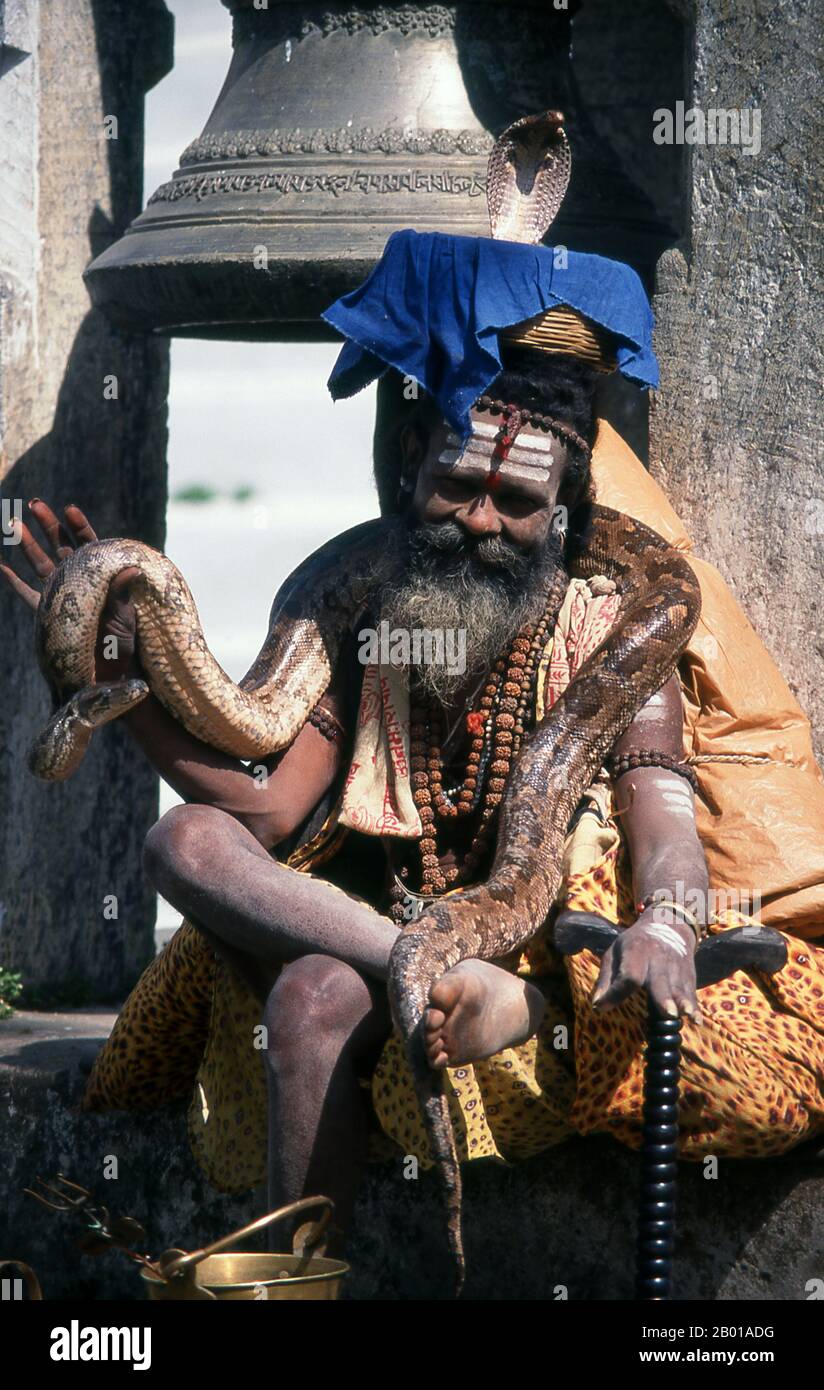 Nepal: Sadhu with his python and cobra, Pashupatinath, Kathmandu. They are known, variously, as sadhus (saints, or 'good ones'), yogis (ascetic practitioners), fakirs (ascetic seeker after the Truth) and sannyasins (wandering mendicants and ascetics). They are the ascetic – and often eccentric – practitioners of an austere form of Hinduism. Sworn to cast off earthly desires, some choose to live as anchorites in the wilderness. Others are of a less retiring disposition, especially in the towns and temples of Nepal's Kathmandu Valley. Stock Photohttps://www.alamy.com/image-license-details/?v=1https://www.alamy.com/nepal-sadhu-with-his-python-and-cobra-pashupatinath-kathmandu-they-are-known-variously-as-sadhus-saints-or-good-ones-yogis-ascetic-practitioners-fakirs-ascetic-seeker-after-the-truth-and-sannyasins-wandering-mendicants-and-ascetics-they-are-the-ascetic-and-often-eccentric-practitioners-of-an-austere-form-of-hinduism-sworn-to-cast-off-earthly-desires-some-choose-to-live-as-anchorites-in-the-wilderness-others-are-of-a-less-retiring-disposition-especially-in-the-towns-and-temples-of-nepals-kathmandu-valley-image344237532.html
Nepal: Sadhu with his python and cobra, Pashupatinath, Kathmandu. They are known, variously, as sadhus (saints, or 'good ones'), yogis (ascetic practitioners), fakirs (ascetic seeker after the Truth) and sannyasins (wandering mendicants and ascetics). They are the ascetic – and often eccentric – practitioners of an austere form of Hinduism. Sworn to cast off earthly desires, some choose to live as anchorites in the wilderness. Others are of a less retiring disposition, especially in the towns and temples of Nepal's Kathmandu Valley. Stock Photohttps://www.alamy.com/image-license-details/?v=1https://www.alamy.com/nepal-sadhu-with-his-python-and-cobra-pashupatinath-kathmandu-they-are-known-variously-as-sadhus-saints-or-good-ones-yogis-ascetic-practitioners-fakirs-ascetic-seeker-after-the-truth-and-sannyasins-wandering-mendicants-and-ascetics-they-are-the-ascetic-and-often-eccentric-practitioners-of-an-austere-form-of-hinduism-sworn-to-cast-off-earthly-desires-some-choose-to-live-as-anchorites-in-the-wilderness-others-are-of-a-less-retiring-disposition-especially-in-the-towns-and-temples-of-nepals-kathmandu-valley-image344237532.htmlRM2B01ADG–Nepal: Sadhu with his python and cobra, Pashupatinath, Kathmandu. They are known, variously, as sadhus (saints, or 'good ones'), yogis (ascetic practitioners), fakirs (ascetic seeker after the Truth) and sannyasins (wandering mendicants and ascetics). They are the ascetic – and often eccentric – practitioners of an austere form of Hinduism. Sworn to cast off earthly desires, some choose to live as anchorites in the wilderness. Others are of a less retiring disposition, especially in the towns and temples of Nepal's Kathmandu Valley.
 Sri Lanka: Return of the Tooth, depicted in a mural in the Temple of the Tooth, Kandy. Sri Dalada Maligawa or The Temple of the Sacred Tooth Relic is located in the royal palace complex and houses the Relic of the tooth of Buddha. Since ancient times, the relic has played an important role in local politics because it is believed that whoever holds the relic holds the governance of the country. Stock Photohttps://www.alamy.com/image-license-details/?v=1https://www.alamy.com/sri-lanka-return-of-the-tooth-depicted-in-a-mural-in-the-temple-of-the-tooth-kandy-sri-dalada-maligawa-or-the-temple-of-the-sacred-tooth-relic-is-located-in-the-royal-palace-complex-and-houses-the-relic-of-the-tooth-of-buddha-since-ancient-times-the-relic-has-played-an-important-role-in-local-politics-because-it-is-believed-that-whoever-holds-the-relic-holds-the-governance-of-the-country-image344229806.html
Sri Lanka: Return of the Tooth, depicted in a mural in the Temple of the Tooth, Kandy. Sri Dalada Maligawa or The Temple of the Sacred Tooth Relic is located in the royal palace complex and houses the Relic of the tooth of Buddha. Since ancient times, the relic has played an important role in local politics because it is believed that whoever holds the relic holds the governance of the country. Stock Photohttps://www.alamy.com/image-license-details/?v=1https://www.alamy.com/sri-lanka-return-of-the-tooth-depicted-in-a-mural-in-the-temple-of-the-tooth-kandy-sri-dalada-maligawa-or-the-temple-of-the-sacred-tooth-relic-is-located-in-the-royal-palace-complex-and-houses-the-relic-of-the-tooth-of-buddha-since-ancient-times-the-relic-has-played-an-important-role-in-local-politics-because-it-is-believed-that-whoever-holds-the-relic-holds-the-governance-of-the-country-image344229806.htmlRM2B010HJ–Sri Lanka: Return of the Tooth, depicted in a mural in the Temple of the Tooth, Kandy. Sri Dalada Maligawa or The Temple of the Sacred Tooth Relic is located in the royal palace complex and houses the Relic of the tooth of Buddha. Since ancient times, the relic has played an important role in local politics because it is believed that whoever holds the relic holds the governance of the country.
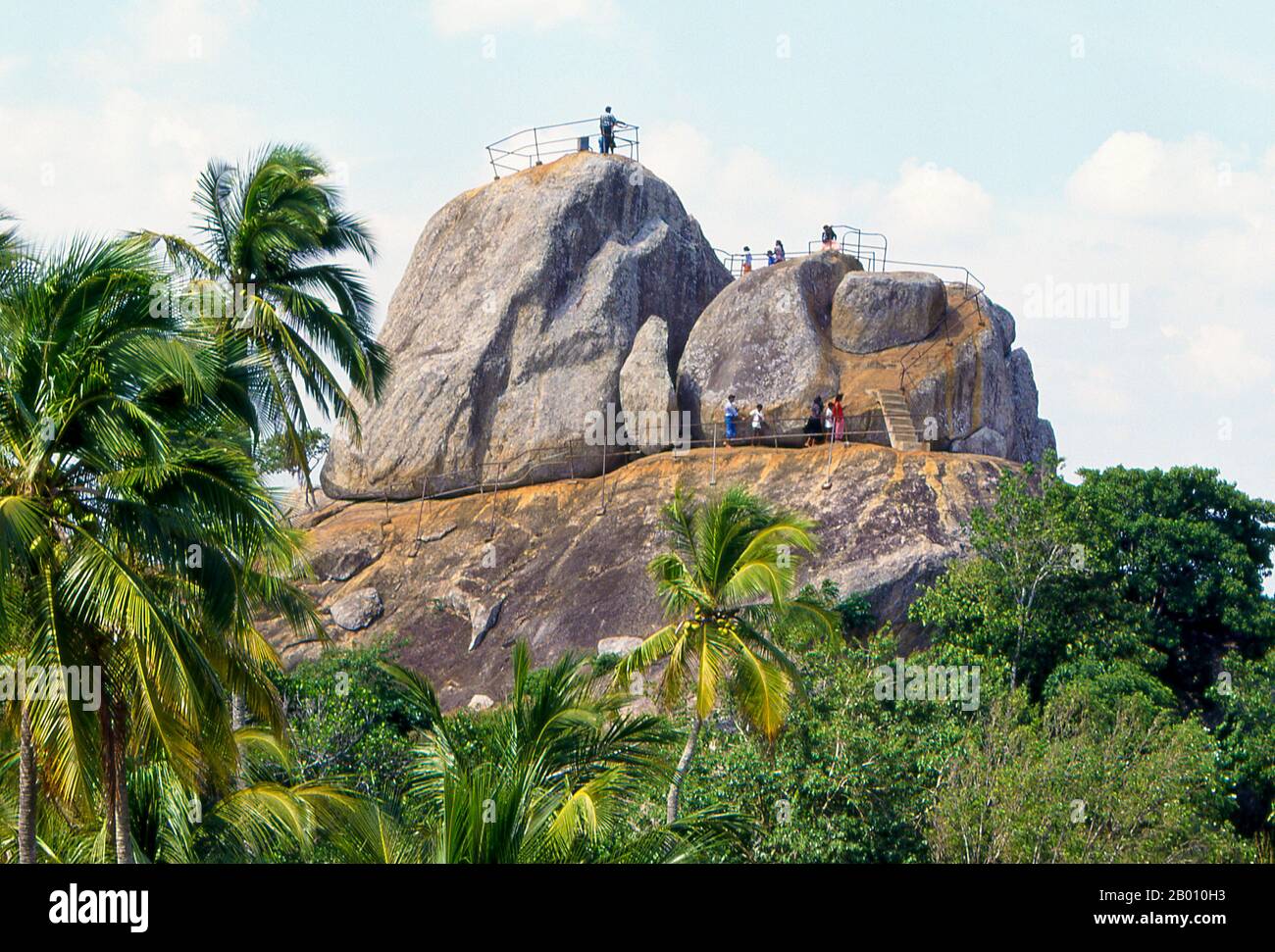 Sri Lanka: Visitors atop Aradhana Gala (Meditation Rock), Mihintale. Mihintale is a mountain peak near Anuradhapura that is believed by Sri Lankans to be the site of a meeting between the Buddhist monk Mahinda and King Devanampiyatissa which inaugurated the presence of Buddhism in Sri Lanka. It is now a pilgrimage site, and the site of several religious monuments and abandoned structures. Stock Photohttps://www.alamy.com/image-license-details/?v=1https://www.alamy.com/sri-lanka-visitors-atop-aradhana-gala-meditation-rock-mihintale-mihintale-is-a-mountain-peak-near-anuradhapura-that-is-believed-by-sri-lankans-to-be-the-site-of-a-meeting-between-the-buddhist-monk-mahinda-and-king-devanampiyatissa-which-inaugurated-the-presence-of-buddhism-in-sri-lanka-it-is-now-a-pilgrimage-site-and-the-site-of-several-religious-monuments-and-abandoned-structures-image344229791.html
Sri Lanka: Visitors atop Aradhana Gala (Meditation Rock), Mihintale. Mihintale is a mountain peak near Anuradhapura that is believed by Sri Lankans to be the site of a meeting between the Buddhist monk Mahinda and King Devanampiyatissa which inaugurated the presence of Buddhism in Sri Lanka. It is now a pilgrimage site, and the site of several religious monuments and abandoned structures. Stock Photohttps://www.alamy.com/image-license-details/?v=1https://www.alamy.com/sri-lanka-visitors-atop-aradhana-gala-meditation-rock-mihintale-mihintale-is-a-mountain-peak-near-anuradhapura-that-is-believed-by-sri-lankans-to-be-the-site-of-a-meeting-between-the-buddhist-monk-mahinda-and-king-devanampiyatissa-which-inaugurated-the-presence-of-buddhism-in-sri-lanka-it-is-now-a-pilgrimage-site-and-the-site-of-several-religious-monuments-and-abandoned-structures-image344229791.htmlRM2B010H3–Sri Lanka: Visitors atop Aradhana Gala (Meditation Rock), Mihintale. Mihintale is a mountain peak near Anuradhapura that is believed by Sri Lankans to be the site of a meeting between the Buddhist monk Mahinda and King Devanampiyatissa which inaugurated the presence of Buddhism in Sri Lanka. It is now a pilgrimage site, and the site of several religious monuments and abandoned structures.
 Sri Lanka: Return of the Tooth, depicted in a mural in the Temple of the Tooth, Kandy. Sri Dalada Maligawa or The Temple of the Sacred Tooth Relic is located in the royal palace complex and houses the Relic of the tooth of Buddha. Since ancient times, the relic has played an important role in local politics because it is believed that whoever holds the relic holds the governance of the country. Stock Photohttps://www.alamy.com/image-license-details/?v=1https://www.alamy.com/sri-lanka-return-of-the-tooth-depicted-in-a-mural-in-the-temple-of-the-tooth-kandy-sri-dalada-maligawa-or-the-temple-of-the-sacred-tooth-relic-is-located-in-the-royal-palace-complex-and-houses-the-relic-of-the-tooth-of-buddha-since-ancient-times-the-relic-has-played-an-important-role-in-local-politics-because-it-is-believed-that-whoever-holds-the-relic-holds-the-governance-of-the-country-image344229800.html
Sri Lanka: Return of the Tooth, depicted in a mural in the Temple of the Tooth, Kandy. Sri Dalada Maligawa or The Temple of the Sacred Tooth Relic is located in the royal palace complex and houses the Relic of the tooth of Buddha. Since ancient times, the relic has played an important role in local politics because it is believed that whoever holds the relic holds the governance of the country. Stock Photohttps://www.alamy.com/image-license-details/?v=1https://www.alamy.com/sri-lanka-return-of-the-tooth-depicted-in-a-mural-in-the-temple-of-the-tooth-kandy-sri-dalada-maligawa-or-the-temple-of-the-sacred-tooth-relic-is-located-in-the-royal-palace-complex-and-houses-the-relic-of-the-tooth-of-buddha-since-ancient-times-the-relic-has-played-an-important-role-in-local-politics-because-it-is-believed-that-whoever-holds-the-relic-holds-the-governance-of-the-country-image344229800.htmlRM2B010HC–Sri Lanka: Return of the Tooth, depicted in a mural in the Temple of the Tooth, Kandy. Sri Dalada Maligawa or The Temple of the Sacred Tooth Relic is located in the royal palace complex and houses the Relic of the tooth of Buddha. Since ancient times, the relic has played an important role in local politics because it is believed that whoever holds the relic holds the governance of the country.
 Sri Lanka: A visitor poses in the Hatadage, Polonnaruwa. Hatadage, an ancient relic shrine was built by King Vijayabahu I (r. 1055 - 1110), and was once used to keep the Relic of the tooth of the Buddha. Polonnaruwa, the second most ancient of Sri Lanka's kingdoms, was first declared the capital city by King Vijayabahu I, who defeated the Chola invaders in 1070 CE to reunite the country under a national leader. Stock Photohttps://www.alamy.com/image-license-details/?v=1https://www.alamy.com/sri-lanka-a-visitor-poses-in-the-hatadage-polonnaruwa-hatadage-an-ancient-relic-shrine-was-built-by-king-vijayabahu-i-r-1055-1110-and-was-once-used-to-keep-the-relic-of-the-tooth-of-the-buddha-polonnaruwa-the-second-most-ancient-of-sri-lankas-kingdoms-was-first-declared-the-capital-city-by-king-vijayabahu-i-who-defeated-the-chola-invaders-in-1070-ce-to-reunite-the-country-under-a-national-leader-image344229893.html
Sri Lanka: A visitor poses in the Hatadage, Polonnaruwa. Hatadage, an ancient relic shrine was built by King Vijayabahu I (r. 1055 - 1110), and was once used to keep the Relic of the tooth of the Buddha. Polonnaruwa, the second most ancient of Sri Lanka's kingdoms, was first declared the capital city by King Vijayabahu I, who defeated the Chola invaders in 1070 CE to reunite the country under a national leader. Stock Photohttps://www.alamy.com/image-license-details/?v=1https://www.alamy.com/sri-lanka-a-visitor-poses-in-the-hatadage-polonnaruwa-hatadage-an-ancient-relic-shrine-was-built-by-king-vijayabahu-i-r-1055-1110-and-was-once-used-to-keep-the-relic-of-the-tooth-of-the-buddha-polonnaruwa-the-second-most-ancient-of-sri-lankas-kingdoms-was-first-declared-the-capital-city-by-king-vijayabahu-i-who-defeated-the-chola-invaders-in-1070-ce-to-reunite-the-country-under-a-national-leader-image344229893.htmlRM2B010MN–Sri Lanka: A visitor poses in the Hatadage, Polonnaruwa. Hatadage, an ancient relic shrine was built by King Vijayabahu I (r. 1055 - 1110), and was once used to keep the Relic of the tooth of the Buddha. Polonnaruwa, the second most ancient of Sri Lanka's kingdoms, was first declared the capital city by King Vijayabahu I, who defeated the Chola invaders in 1070 CE to reunite the country under a national leader.
 Sri Lanka: Return of the Tooth, depicted in a mural in the Temple of the Tooth, Kandy. Sri Dalada Maligawa or The Temple of the Sacred Tooth Relic is located in the royal palace complex and houses the Relic of the tooth of Buddha. Since ancient times, the relic has played an important role in local politics because it is believed that whoever holds the relic holds the governance of the country. Stock Photohttps://www.alamy.com/image-license-details/?v=1https://www.alamy.com/sri-lanka-return-of-the-tooth-depicted-in-a-mural-in-the-temple-of-the-tooth-kandy-sri-dalada-maligawa-or-the-temple-of-the-sacred-tooth-relic-is-located-in-the-royal-palace-complex-and-houses-the-relic-of-the-tooth-of-buddha-since-ancient-times-the-relic-has-played-an-important-role-in-local-politics-because-it-is-believed-that-whoever-holds-the-relic-holds-the-governance-of-the-country-image344229805.html
Sri Lanka: Return of the Tooth, depicted in a mural in the Temple of the Tooth, Kandy. Sri Dalada Maligawa or The Temple of the Sacred Tooth Relic is located in the royal palace complex and houses the Relic of the tooth of Buddha. Since ancient times, the relic has played an important role in local politics because it is believed that whoever holds the relic holds the governance of the country. Stock Photohttps://www.alamy.com/image-license-details/?v=1https://www.alamy.com/sri-lanka-return-of-the-tooth-depicted-in-a-mural-in-the-temple-of-the-tooth-kandy-sri-dalada-maligawa-or-the-temple-of-the-sacred-tooth-relic-is-located-in-the-royal-palace-complex-and-houses-the-relic-of-the-tooth-of-buddha-since-ancient-times-the-relic-has-played-an-important-role-in-local-politics-because-it-is-believed-that-whoever-holds-the-relic-holds-the-governance-of-the-country-image344229805.htmlRM2B010HH–Sri Lanka: Return of the Tooth, depicted in a mural in the Temple of the Tooth, Kandy. Sri Dalada Maligawa or The Temple of the Sacred Tooth Relic is located in the royal palace complex and houses the Relic of the tooth of Buddha. Since ancient times, the relic has played an important role in local politics because it is believed that whoever holds the relic holds the governance of the country.
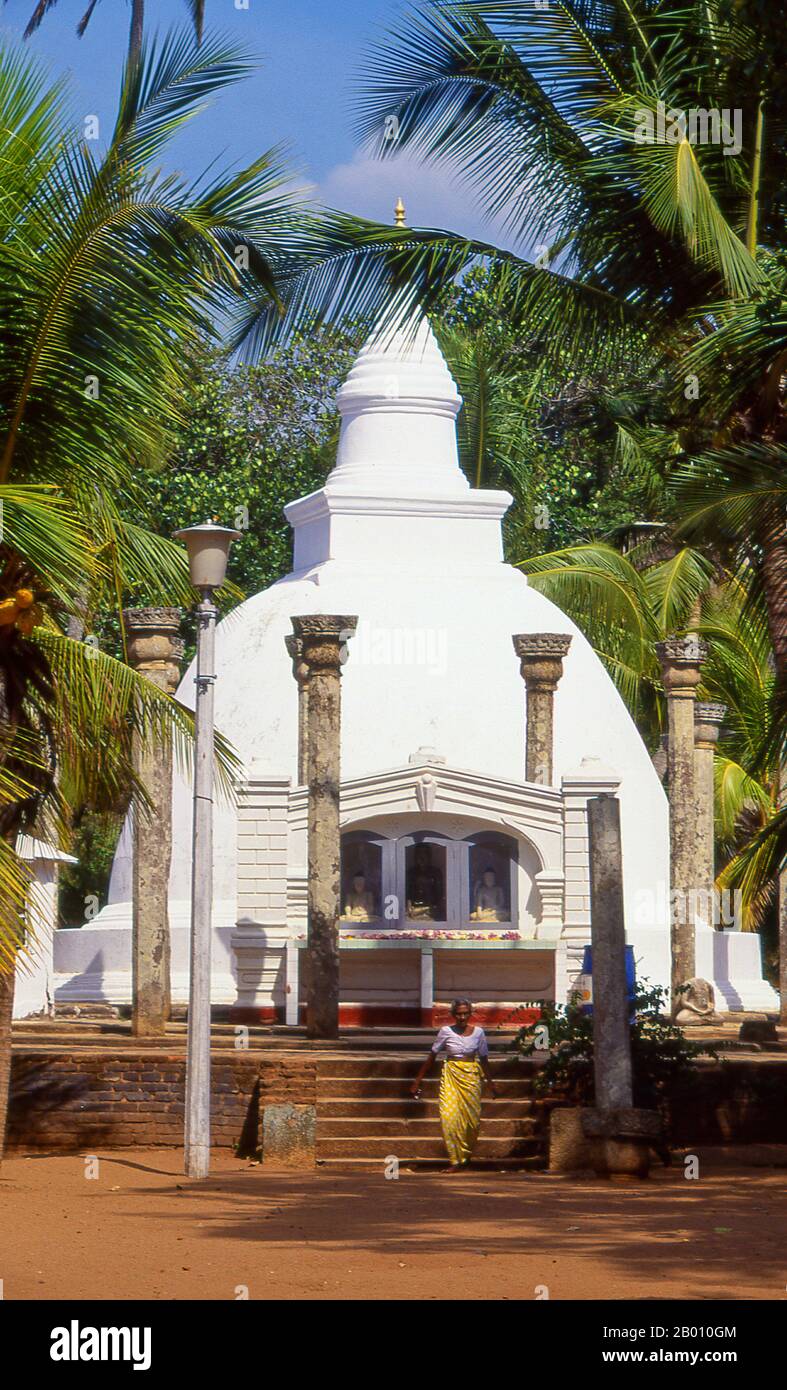 Sri Lanka: Ambasthala (Mango tree) Dagoba, Mihintale. Mihintale is a mountain peak near Anuradhapura that is believed by Sri Lankans to be the site of a meeting between the Buddhist monk Mahinda and King Devanampiyatissa which inaugurated the presence of Buddhism in Sri Lanka. It is now a pilgrimage site, and the site of several religious monuments and abandoned structures. Stock Photohttps://www.alamy.com/image-license-details/?v=1https://www.alamy.com/sri-lanka-ambasthala-mango-tree-dagoba-mihintale-mihintale-is-a-mountain-peak-near-anuradhapura-that-is-believed-by-sri-lankans-to-be-the-site-of-a-meeting-between-the-buddhist-monk-mahinda-and-king-devanampiyatissa-which-inaugurated-the-presence-of-buddhism-in-sri-lanka-it-is-now-a-pilgrimage-site-and-the-site-of-several-religious-monuments-and-abandoned-structures-image344229780.html
Sri Lanka: Ambasthala (Mango tree) Dagoba, Mihintale. Mihintale is a mountain peak near Anuradhapura that is believed by Sri Lankans to be the site of a meeting between the Buddhist monk Mahinda and King Devanampiyatissa which inaugurated the presence of Buddhism in Sri Lanka. It is now a pilgrimage site, and the site of several religious monuments and abandoned structures. Stock Photohttps://www.alamy.com/image-license-details/?v=1https://www.alamy.com/sri-lanka-ambasthala-mango-tree-dagoba-mihintale-mihintale-is-a-mountain-peak-near-anuradhapura-that-is-believed-by-sri-lankans-to-be-the-site-of-a-meeting-between-the-buddhist-monk-mahinda-and-king-devanampiyatissa-which-inaugurated-the-presence-of-buddhism-in-sri-lanka-it-is-now-a-pilgrimage-site-and-the-site-of-several-religious-monuments-and-abandoned-structures-image344229780.htmlRM2B010GM–Sri Lanka: Ambasthala (Mango tree) Dagoba, Mihintale. Mihintale is a mountain peak near Anuradhapura that is believed by Sri Lankans to be the site of a meeting between the Buddhist monk Mahinda and King Devanampiyatissa which inaugurated the presence of Buddhism in Sri Lanka. It is now a pilgrimage site, and the site of several religious monuments and abandoned structures.
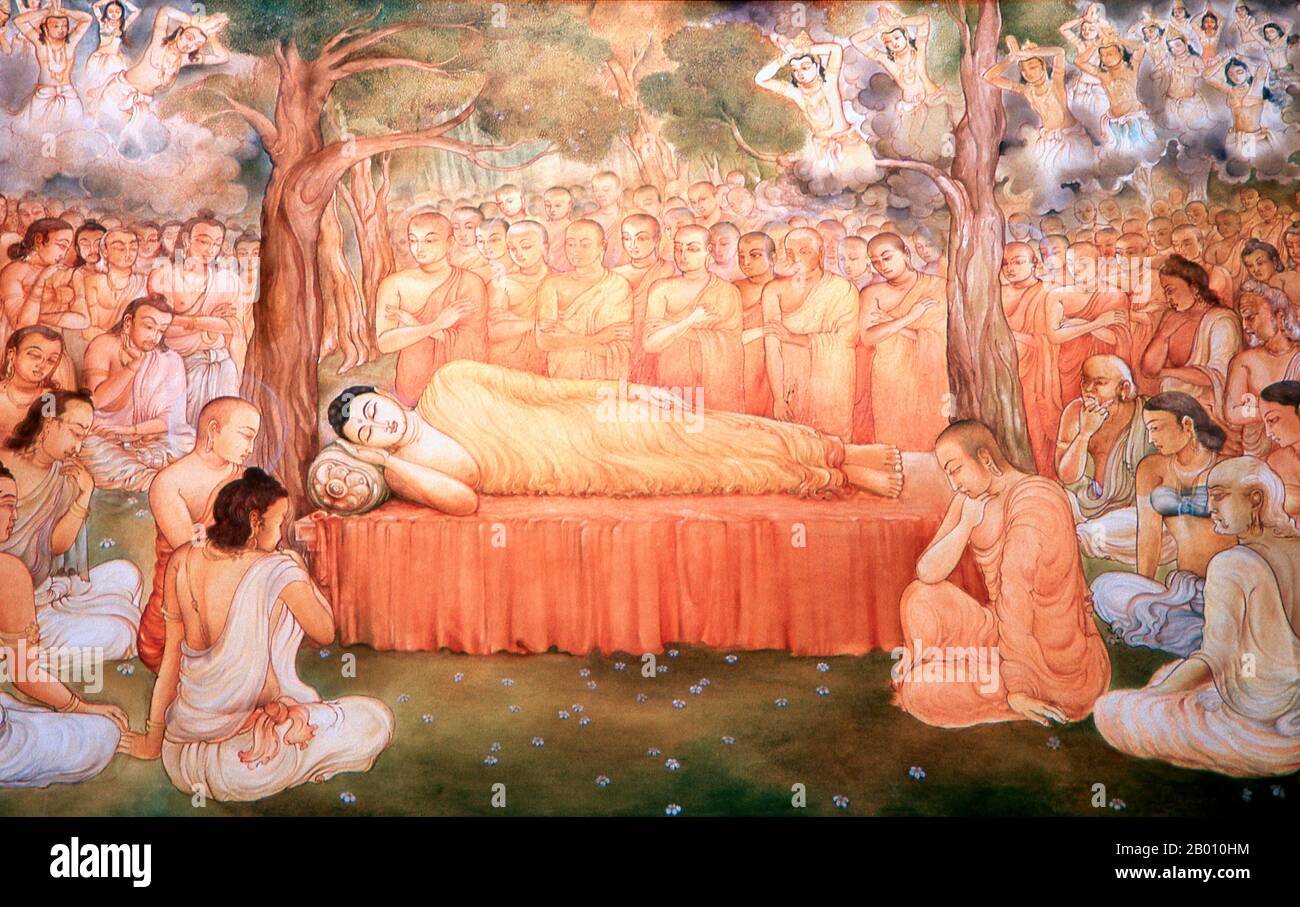 Sri Lanka: Buddha in death, depicted in a mural in the Temple of the Tooth, Kandy. Sri Dalada Maligawa or The Temple of the Sacred Tooth Relic is located in the royal palace complex and houses the Relic of the tooth of Buddha. Since ancient times, the relic has played an important role in local politics because it is believed that whoever holds the relic holds the governance of the country. Stock Photohttps://www.alamy.com/image-license-details/?v=1https://www.alamy.com/sri-lanka-buddha-in-death-depicted-in-a-mural-in-the-temple-of-the-tooth-kandy-sri-dalada-maligawa-or-the-temple-of-the-sacred-tooth-relic-is-located-in-the-royal-palace-complex-and-houses-the-relic-of-the-tooth-of-buddha-since-ancient-times-the-relic-has-played-an-important-role-in-local-politics-because-it-is-believed-that-whoever-holds-the-relic-holds-the-governance-of-the-country-image344229808.html
Sri Lanka: Buddha in death, depicted in a mural in the Temple of the Tooth, Kandy. Sri Dalada Maligawa or The Temple of the Sacred Tooth Relic is located in the royal palace complex and houses the Relic of the tooth of Buddha. Since ancient times, the relic has played an important role in local politics because it is believed that whoever holds the relic holds the governance of the country. Stock Photohttps://www.alamy.com/image-license-details/?v=1https://www.alamy.com/sri-lanka-buddha-in-death-depicted-in-a-mural-in-the-temple-of-the-tooth-kandy-sri-dalada-maligawa-or-the-temple-of-the-sacred-tooth-relic-is-located-in-the-royal-palace-complex-and-houses-the-relic-of-the-tooth-of-buddha-since-ancient-times-the-relic-has-played-an-important-role-in-local-politics-because-it-is-believed-that-whoever-holds-the-relic-holds-the-governance-of-the-country-image344229808.htmlRM2B010HM–Sri Lanka: Buddha in death, depicted in a mural in the Temple of the Tooth, Kandy. Sri Dalada Maligawa or The Temple of the Sacred Tooth Relic is located in the royal palace complex and houses the Relic of the tooth of Buddha. Since ancient times, the relic has played an important role in local politics because it is believed that whoever holds the relic holds the governance of the country.
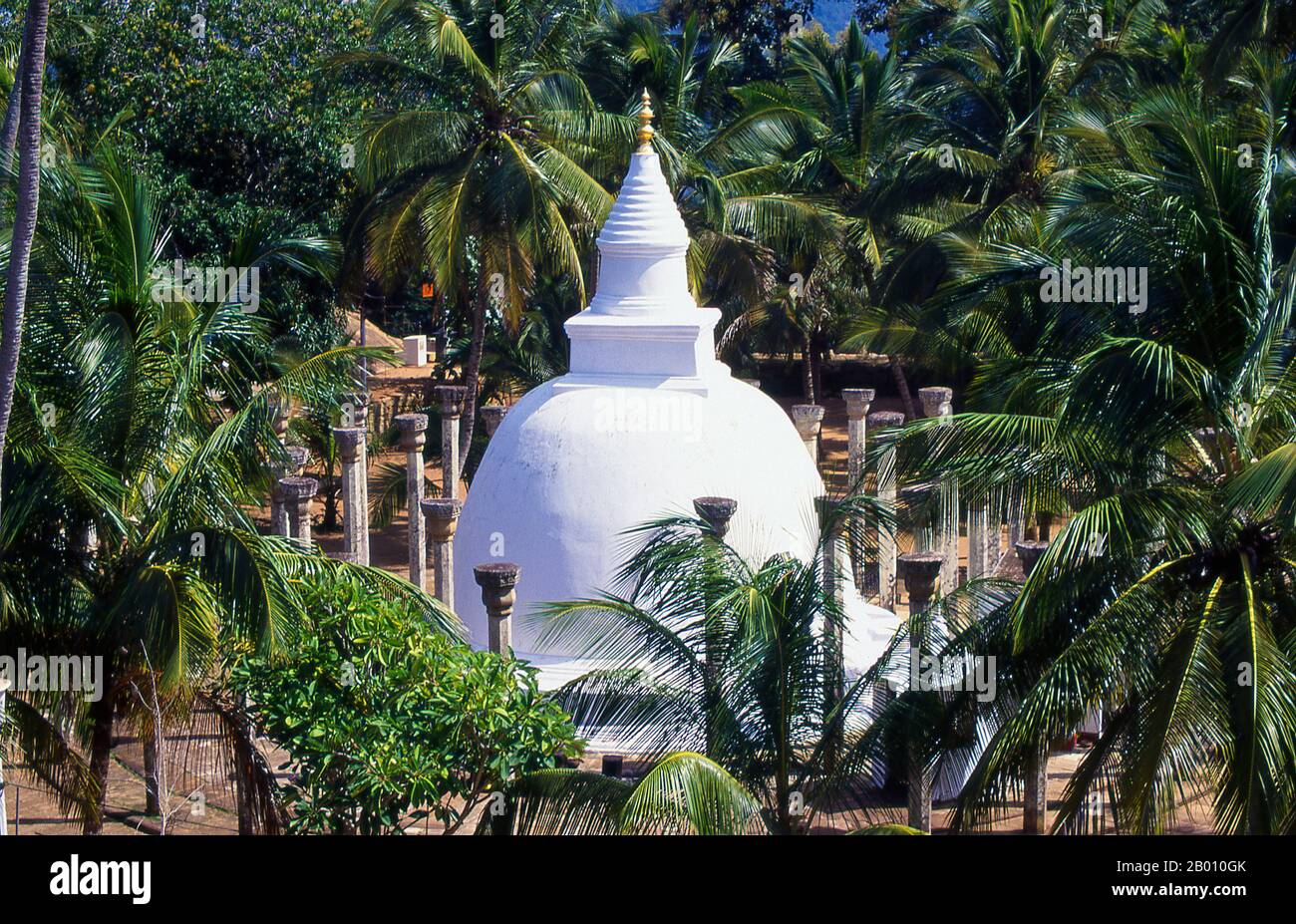 Sri Lanka: Ambasthala (Mango tree) Dagoba, Mihintale. Mihintale is a mountain peak near Anuradhapura that is believed by Sri Lankans to be the site of a meeting between the Buddhist monk Mahinda and King Devanampiyatissa which inaugurated the presence of Buddhism in Sri Lanka. It is now a pilgrimage site, and the site of several religious monuments and abandoned structures. Stock Photohttps://www.alamy.com/image-license-details/?v=1https://www.alamy.com/sri-lanka-ambasthala-mango-tree-dagoba-mihintale-mihintale-is-a-mountain-peak-near-anuradhapura-that-is-believed-by-sri-lankans-to-be-the-site-of-a-meeting-between-the-buddhist-monk-mahinda-and-king-devanampiyatissa-which-inaugurated-the-presence-of-buddhism-in-sri-lanka-it-is-now-a-pilgrimage-site-and-the-site-of-several-religious-monuments-and-abandoned-structures-image344229779.html
Sri Lanka: Ambasthala (Mango tree) Dagoba, Mihintale. Mihintale is a mountain peak near Anuradhapura that is believed by Sri Lankans to be the site of a meeting between the Buddhist monk Mahinda and King Devanampiyatissa which inaugurated the presence of Buddhism in Sri Lanka. It is now a pilgrimage site, and the site of several religious monuments and abandoned structures. Stock Photohttps://www.alamy.com/image-license-details/?v=1https://www.alamy.com/sri-lanka-ambasthala-mango-tree-dagoba-mihintale-mihintale-is-a-mountain-peak-near-anuradhapura-that-is-believed-by-sri-lankans-to-be-the-site-of-a-meeting-between-the-buddhist-monk-mahinda-and-king-devanampiyatissa-which-inaugurated-the-presence-of-buddhism-in-sri-lanka-it-is-now-a-pilgrimage-site-and-the-site-of-several-religious-monuments-and-abandoned-structures-image344229779.htmlRM2B010GK–Sri Lanka: Ambasthala (Mango tree) Dagoba, Mihintale. Mihintale is a mountain peak near Anuradhapura that is believed by Sri Lankans to be the site of a meeting between the Buddhist monk Mahinda and King Devanampiyatissa which inaugurated the presence of Buddhism in Sri Lanka. It is now a pilgrimage site, and the site of several religious monuments and abandoned structures.
 Sri Lanka: A monk stands in front of a mural in the Temple of the Tooth, Kandy. Sri Dalada Maligawa or The Temple of the Sacred Tooth Relic is located in the royal palace complex and houses the Relic of the tooth of Buddha. Since ancient times, the relic has played an important role in local politics because it is believed that whoever holds the relic holds the governance of the country. Stock Photohttps://www.alamy.com/image-license-details/?v=1https://www.alamy.com/sri-lanka-a-monk-stands-in-front-of-a-mural-in-the-temple-of-the-tooth-kandy-sri-dalada-maligawa-or-the-temple-of-the-sacred-tooth-relic-is-located-in-the-royal-palace-complex-and-houses-the-relic-of-the-tooth-of-buddha-since-ancient-times-the-relic-has-played-an-important-role-in-local-politics-because-it-is-believed-that-whoever-holds-the-relic-holds-the-governance-of-the-country-image344229796.html
Sri Lanka: A monk stands in front of a mural in the Temple of the Tooth, Kandy. Sri Dalada Maligawa or The Temple of the Sacred Tooth Relic is located in the royal palace complex and houses the Relic of the tooth of Buddha. Since ancient times, the relic has played an important role in local politics because it is believed that whoever holds the relic holds the governance of the country. Stock Photohttps://www.alamy.com/image-license-details/?v=1https://www.alamy.com/sri-lanka-a-monk-stands-in-front-of-a-mural-in-the-temple-of-the-tooth-kandy-sri-dalada-maligawa-or-the-temple-of-the-sacred-tooth-relic-is-located-in-the-royal-palace-complex-and-houses-the-relic-of-the-tooth-of-buddha-since-ancient-times-the-relic-has-played-an-important-role-in-local-politics-because-it-is-believed-that-whoever-holds-the-relic-holds-the-governance-of-the-country-image344229796.htmlRM2B010H8–Sri Lanka: A monk stands in front of a mural in the Temple of the Tooth, Kandy. Sri Dalada Maligawa or The Temple of the Sacred Tooth Relic is located in the royal palace complex and houses the Relic of the tooth of Buddha. Since ancient times, the relic has played an important role in local politics because it is believed that whoever holds the relic holds the governance of the country.
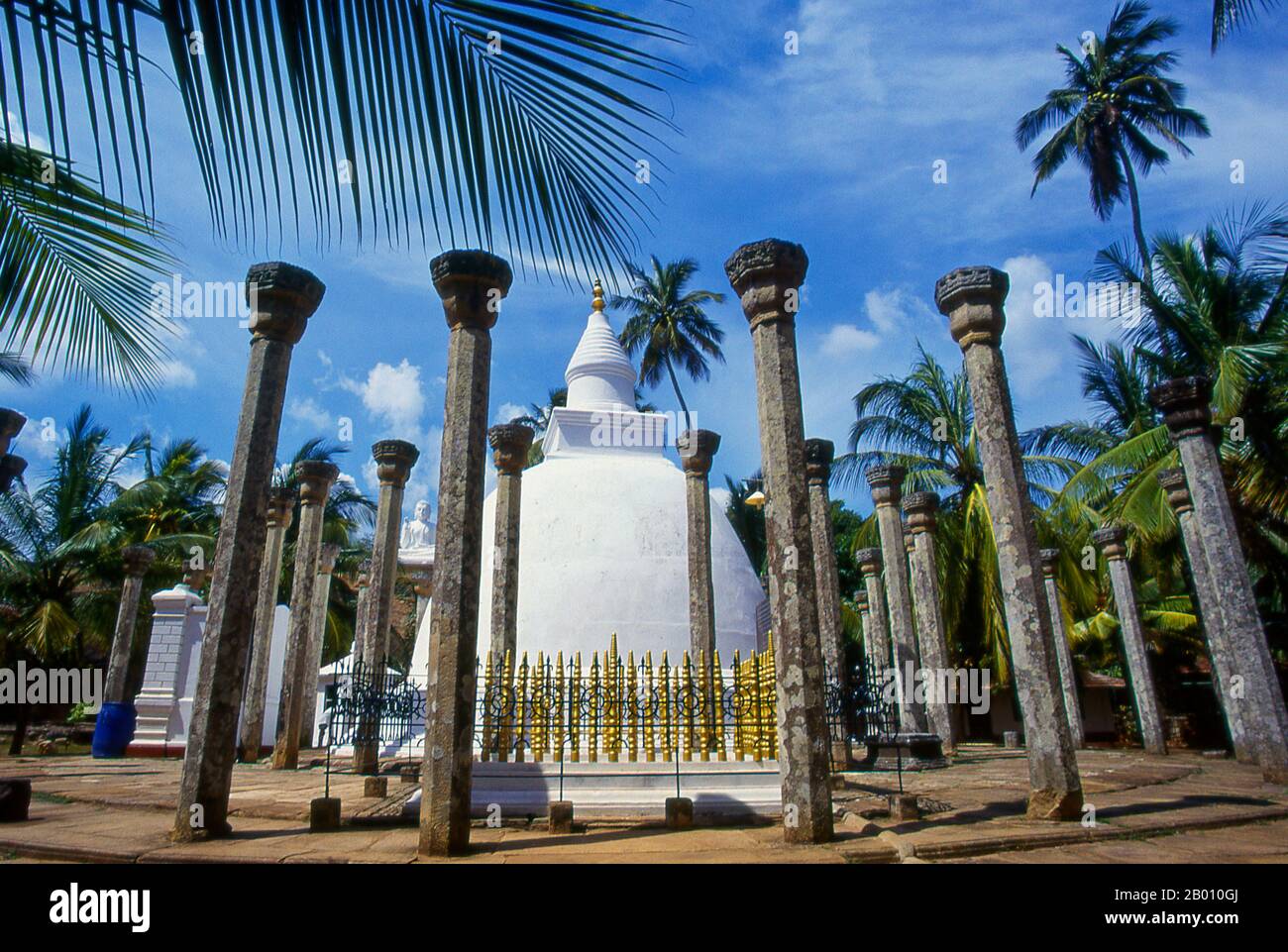 Sri Lanka: Ambasthala (Mango tree) Dagoba, Mihintale. Mihintale is a mountain peak near Anuradhapura that is believed by Sri Lankans to be the site of a meeting between the Buddhist monk Mahinda and King Devanampiyatissa which inaugurated the presence of Buddhism in Sri Lanka. It is now a pilgrimage site, and the site of several religious monuments and abandoned structures. Stock Photohttps://www.alamy.com/image-license-details/?v=1https://www.alamy.com/sri-lanka-ambasthala-mango-tree-dagoba-mihintale-mihintale-is-a-mountain-peak-near-anuradhapura-that-is-believed-by-sri-lankans-to-be-the-site-of-a-meeting-between-the-buddhist-monk-mahinda-and-king-devanampiyatissa-which-inaugurated-the-presence-of-buddhism-in-sri-lanka-it-is-now-a-pilgrimage-site-and-the-site-of-several-religious-monuments-and-abandoned-structures-image344229778.html
Sri Lanka: Ambasthala (Mango tree) Dagoba, Mihintale. Mihintale is a mountain peak near Anuradhapura that is believed by Sri Lankans to be the site of a meeting between the Buddhist monk Mahinda and King Devanampiyatissa which inaugurated the presence of Buddhism in Sri Lanka. It is now a pilgrimage site, and the site of several religious monuments and abandoned structures. Stock Photohttps://www.alamy.com/image-license-details/?v=1https://www.alamy.com/sri-lanka-ambasthala-mango-tree-dagoba-mihintale-mihintale-is-a-mountain-peak-near-anuradhapura-that-is-believed-by-sri-lankans-to-be-the-site-of-a-meeting-between-the-buddhist-monk-mahinda-and-king-devanampiyatissa-which-inaugurated-the-presence-of-buddhism-in-sri-lanka-it-is-now-a-pilgrimage-site-and-the-site-of-several-religious-monuments-and-abandoned-structures-image344229778.htmlRM2B010GJ–Sri Lanka: Ambasthala (Mango tree) Dagoba, Mihintale. Mihintale is a mountain peak near Anuradhapura that is believed by Sri Lankans to be the site of a meeting between the Buddhist monk Mahinda and King Devanampiyatissa which inaugurated the presence of Buddhism in Sri Lanka. It is now a pilgrimage site, and the site of several religious monuments and abandoned structures.
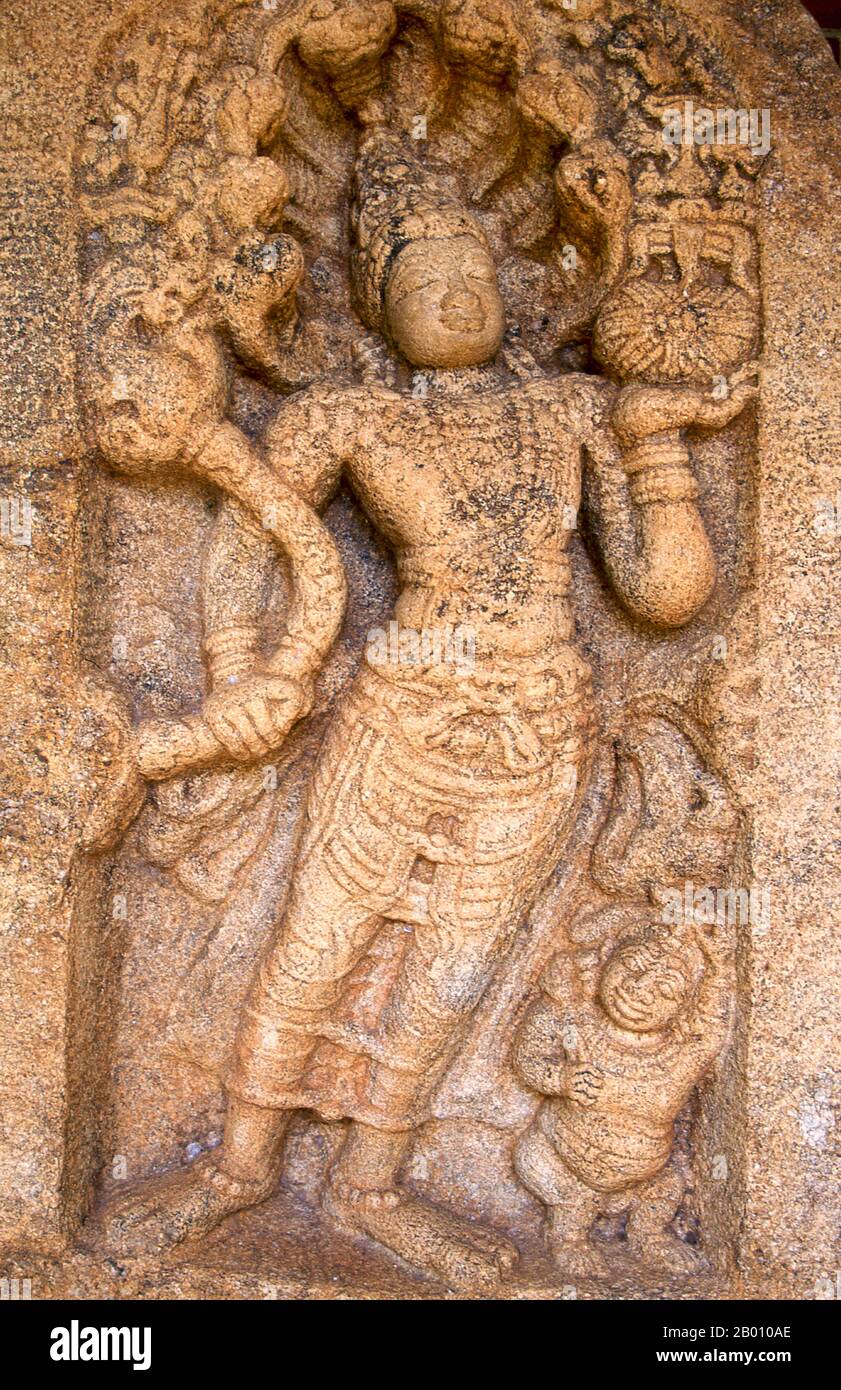 Sri Lanka: Guardstone, Anuradhapura. Anuradhapura is one of Sri Lanka's ancient capitals and famous for its well-preserved ruins. From the 4th century BCE until the beginning of the 11th century CE it was the capital. During this period it remained one of the most stable and durable centers of political power and urban life in South Asia. The ancient city, considered sacred to the Buddhist world, is today surrounded by monasteries covering an area of over sixteen square miles (40 km²). Stock Photohttps://www.alamy.com/image-license-details/?v=1https://www.alamy.com/sri-lanka-guardstone-anuradhapura-anuradhapura-is-one-of-sri-lankas-ancient-capitals-and-famous-for-its-well-preserved-ruins-from-the-4th-century-bce-until-the-beginning-of-the-11th-century-ce-it-was-the-capital-during-this-period-it-remained-one-of-the-most-stable-and-durable-centers-of-political-power-and-urban-life-in-south-asia-the-ancient-city-considered-sacred-to-the-buddhist-world-is-today-surrounded-by-monasteries-covering-an-area-of-over-sixteen-square-miles-40-km-image344229606.html
Sri Lanka: Guardstone, Anuradhapura. Anuradhapura is one of Sri Lanka's ancient capitals and famous for its well-preserved ruins. From the 4th century BCE until the beginning of the 11th century CE it was the capital. During this period it remained one of the most stable and durable centers of political power and urban life in South Asia. The ancient city, considered sacred to the Buddhist world, is today surrounded by monasteries covering an area of over sixteen square miles (40 km²). Stock Photohttps://www.alamy.com/image-license-details/?v=1https://www.alamy.com/sri-lanka-guardstone-anuradhapura-anuradhapura-is-one-of-sri-lankas-ancient-capitals-and-famous-for-its-well-preserved-ruins-from-the-4th-century-bce-until-the-beginning-of-the-11th-century-ce-it-was-the-capital-during-this-period-it-remained-one-of-the-most-stable-and-durable-centers-of-political-power-and-urban-life-in-south-asia-the-ancient-city-considered-sacred-to-the-buddhist-world-is-today-surrounded-by-monasteries-covering-an-area-of-over-sixteen-square-miles-40-km-image344229606.htmlRM2B010AE–Sri Lanka: Guardstone, Anuradhapura. Anuradhapura is one of Sri Lanka's ancient capitals and famous for its well-preserved ruins. From the 4th century BCE until the beginning of the 11th century CE it was the capital. During this period it remained one of the most stable and durable centers of political power and urban life in South Asia. The ancient city, considered sacred to the Buddhist world, is today surrounded by monasteries covering an area of over sixteen square miles (40 km²).
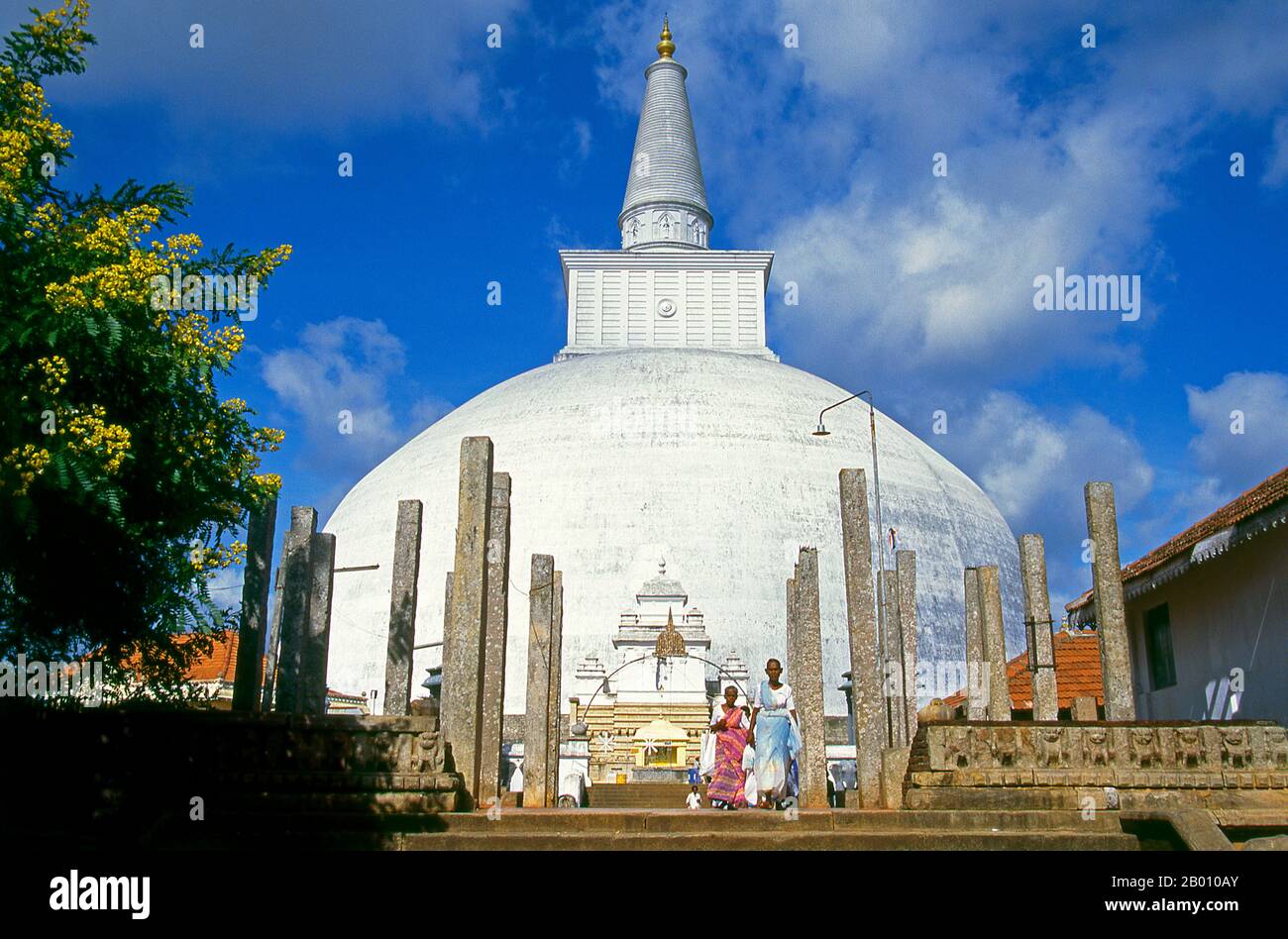 Sri Lanka: Ruvanvelisaya Dagoba, Anuradhapura. Ruvanvelisaya Dagoba was built by King Dutugemunu (r. 161 - 137 BCE). Anuradhapura is one of Sri Lanka's ancient capitals and famous for its well-preserved ruins. From the 4th century BCE until the beginning of the 11th century CE it was the capital. During this period it remained one of the most stable and durable centers of political power and urban life in South Asia. The ancient city, considered sacred to the Buddhist world, is today surrounded by monasteries covering an area of over sixteen square miles (40 km²). Stock Photohttps://www.alamy.com/image-license-details/?v=1https://www.alamy.com/sri-lanka-ruvanvelisaya-dagoba-anuradhapura-ruvanvelisaya-dagoba-was-built-by-king-dutugemunu-r-161-137-bce-anuradhapura-is-one-of-sri-lankas-ancient-capitals-and-famous-for-its-well-preserved-ruins-from-the-4th-century-bce-until-the-beginning-of-the-11th-century-ce-it-was-the-capital-during-this-period-it-remained-one-of-the-most-stable-and-durable-centers-of-political-power-and-urban-life-in-south-asia-the-ancient-city-considered-sacred-to-the-buddhist-world-is-today-surrounded-by-monasteries-covering-an-area-of-over-sixteen-square-miles-40-km-image344229619.html
Sri Lanka: Ruvanvelisaya Dagoba, Anuradhapura. Ruvanvelisaya Dagoba was built by King Dutugemunu (r. 161 - 137 BCE). Anuradhapura is one of Sri Lanka's ancient capitals and famous for its well-preserved ruins. From the 4th century BCE until the beginning of the 11th century CE it was the capital. During this period it remained one of the most stable and durable centers of political power and urban life in South Asia. The ancient city, considered sacred to the Buddhist world, is today surrounded by monasteries covering an area of over sixteen square miles (40 km²). Stock Photohttps://www.alamy.com/image-license-details/?v=1https://www.alamy.com/sri-lanka-ruvanvelisaya-dagoba-anuradhapura-ruvanvelisaya-dagoba-was-built-by-king-dutugemunu-r-161-137-bce-anuradhapura-is-one-of-sri-lankas-ancient-capitals-and-famous-for-its-well-preserved-ruins-from-the-4th-century-bce-until-the-beginning-of-the-11th-century-ce-it-was-the-capital-during-this-period-it-remained-one-of-the-most-stable-and-durable-centers-of-political-power-and-urban-life-in-south-asia-the-ancient-city-considered-sacred-to-the-buddhist-world-is-today-surrounded-by-monasteries-covering-an-area-of-over-sixteen-square-miles-40-km-image344229619.htmlRM2B010AY–Sri Lanka: Ruvanvelisaya Dagoba, Anuradhapura. Ruvanvelisaya Dagoba was built by King Dutugemunu (r. 161 - 137 BCE). Anuradhapura is one of Sri Lanka's ancient capitals and famous for its well-preserved ruins. From the 4th century BCE until the beginning of the 11th century CE it was the capital. During this period it remained one of the most stable and durable centers of political power and urban life in South Asia. The ancient city, considered sacred to the Buddhist world, is today surrounded by monasteries covering an area of over sixteen square miles (40 km²).
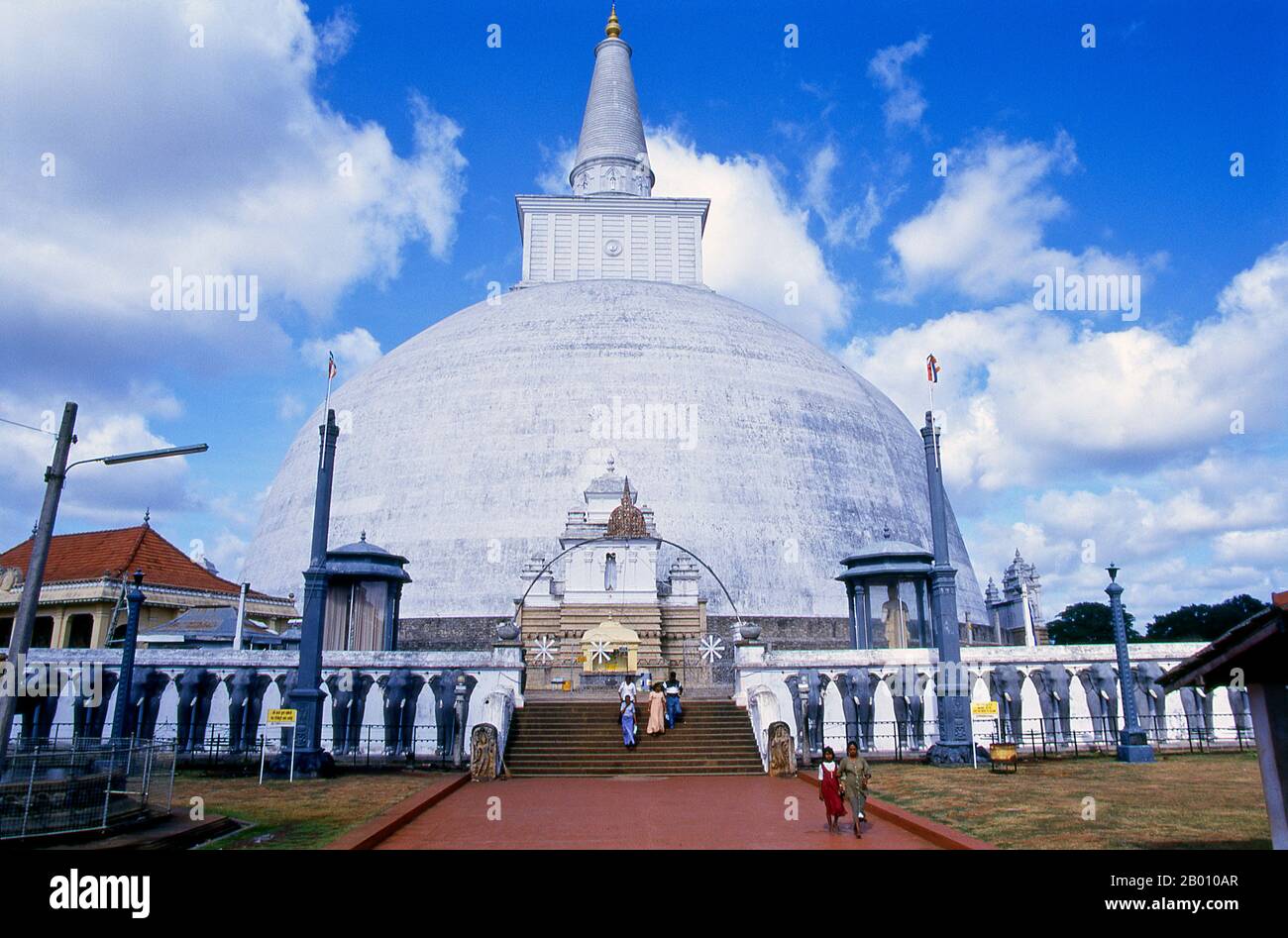 Sri Lanka: Ruvanvelisaya Dagoba, Anuradhapura. Ruvanvelisaya Dagoba was built by King Dutugemunu (r. 161 - 137 BCE). Anuradhapura is one of Sri Lanka's ancient capitals and famous for its well-preserved ruins. From the 4th century BCE until the beginning of the 11th century CE it was the capital. During this period it remained one of the most stable and durable centers of political power and urban life in South Asia. The ancient city, considered sacred to the Buddhist world, is today surrounded by monasteries covering an area of over sixteen square miles (40 km²). Stock Photohttps://www.alamy.com/image-license-details/?v=1https://www.alamy.com/sri-lanka-ruvanvelisaya-dagoba-anuradhapura-ruvanvelisaya-dagoba-was-built-by-king-dutugemunu-r-161-137-bce-anuradhapura-is-one-of-sri-lankas-ancient-capitals-and-famous-for-its-well-preserved-ruins-from-the-4th-century-bce-until-the-beginning-of-the-11th-century-ce-it-was-the-capital-during-this-period-it-remained-one-of-the-most-stable-and-durable-centers-of-political-power-and-urban-life-in-south-asia-the-ancient-city-considered-sacred-to-the-buddhist-world-is-today-surrounded-by-monasteries-covering-an-area-of-over-sixteen-square-miles-40-km-image344229615.html
Sri Lanka: Ruvanvelisaya Dagoba, Anuradhapura. Ruvanvelisaya Dagoba was built by King Dutugemunu (r. 161 - 137 BCE). Anuradhapura is one of Sri Lanka's ancient capitals and famous for its well-preserved ruins. From the 4th century BCE until the beginning of the 11th century CE it was the capital. During this period it remained one of the most stable and durable centers of political power and urban life in South Asia. The ancient city, considered sacred to the Buddhist world, is today surrounded by monasteries covering an area of over sixteen square miles (40 km²). Stock Photohttps://www.alamy.com/image-license-details/?v=1https://www.alamy.com/sri-lanka-ruvanvelisaya-dagoba-anuradhapura-ruvanvelisaya-dagoba-was-built-by-king-dutugemunu-r-161-137-bce-anuradhapura-is-one-of-sri-lankas-ancient-capitals-and-famous-for-its-well-preserved-ruins-from-the-4th-century-bce-until-the-beginning-of-the-11th-century-ce-it-was-the-capital-during-this-period-it-remained-one-of-the-most-stable-and-durable-centers-of-political-power-and-urban-life-in-south-asia-the-ancient-city-considered-sacred-to-the-buddhist-world-is-today-surrounded-by-monasteries-covering-an-area-of-over-sixteen-square-miles-40-km-image344229615.htmlRM2B010AR–Sri Lanka: Ruvanvelisaya Dagoba, Anuradhapura. Ruvanvelisaya Dagoba was built by King Dutugemunu (r. 161 - 137 BCE). Anuradhapura is one of Sri Lanka's ancient capitals and famous for its well-preserved ruins. From the 4th century BCE until the beginning of the 11th century CE it was the capital. During this period it remained one of the most stable and durable centers of political power and urban life in South Asia. The ancient city, considered sacred to the Buddhist world, is today surrounded by monasteries covering an area of over sixteen square miles (40 km²).
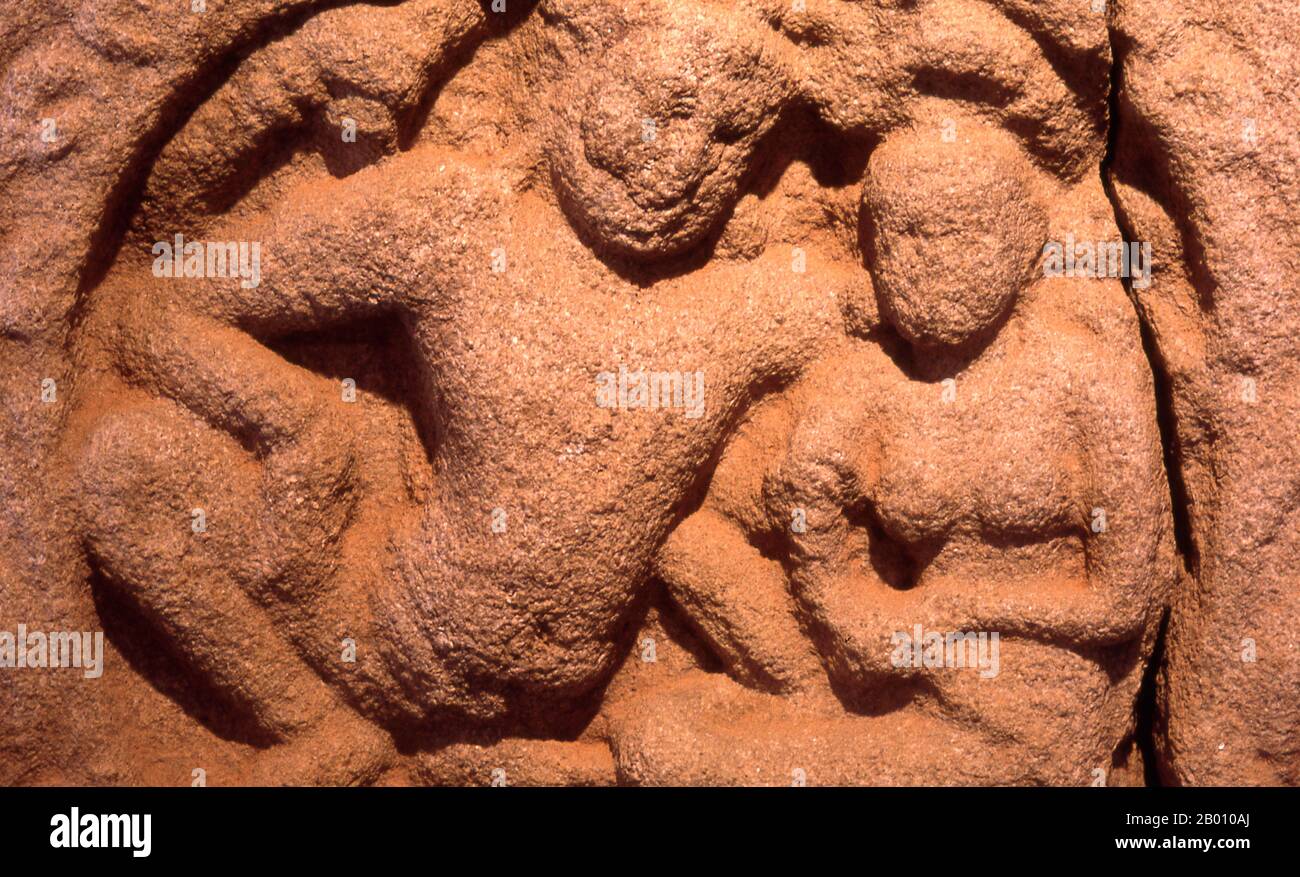 Sri Lanka: Frieze, Isurumuniya temple museum, Anuradhapura. Isurumuniya Vihara is a rock temple built during the reign of King Devanampiya Tissa (r. 307 - 267 BCE). Anuradhapura is one of Sri Lanka's ancient capitals and famous for its well-preserved ruins. From the 4th century BCE until the beginning of the 11th century CE it was the capital. During this period it remained one of the most stable and durable centers of political power and urban life in South Asia. The ancient city, considered sacred to the Buddhist world, is today surrounded by monasteries. Stock Photohttps://www.alamy.com/image-license-details/?v=1https://www.alamy.com/sri-lanka-frieze-isurumuniya-temple-museum-anuradhapura-isurumuniya-vihara-is-a-rock-temple-built-during-the-reign-of-king-devanampiya-tissa-r-307-267-bce-anuradhapura-is-one-of-sri-lankas-ancient-capitals-and-famous-for-its-well-preserved-ruins-from-the-4th-century-bce-until-the-beginning-of-the-11th-century-ce-it-was-the-capital-during-this-period-it-remained-one-of-the-most-stable-and-durable-centers-of-political-power-and-urban-life-in-south-asia-the-ancient-city-considered-sacred-to-the-buddhist-world-is-today-surrounded-by-monasteries-image344229610.html
Sri Lanka: Frieze, Isurumuniya temple museum, Anuradhapura. Isurumuniya Vihara is a rock temple built during the reign of King Devanampiya Tissa (r. 307 - 267 BCE). Anuradhapura is one of Sri Lanka's ancient capitals and famous for its well-preserved ruins. From the 4th century BCE until the beginning of the 11th century CE it was the capital. During this period it remained one of the most stable and durable centers of political power and urban life in South Asia. The ancient city, considered sacred to the Buddhist world, is today surrounded by monasteries. Stock Photohttps://www.alamy.com/image-license-details/?v=1https://www.alamy.com/sri-lanka-frieze-isurumuniya-temple-museum-anuradhapura-isurumuniya-vihara-is-a-rock-temple-built-during-the-reign-of-king-devanampiya-tissa-r-307-267-bce-anuradhapura-is-one-of-sri-lankas-ancient-capitals-and-famous-for-its-well-preserved-ruins-from-the-4th-century-bce-until-the-beginning-of-the-11th-century-ce-it-was-the-capital-during-this-period-it-remained-one-of-the-most-stable-and-durable-centers-of-political-power-and-urban-life-in-south-asia-the-ancient-city-considered-sacred-to-the-buddhist-world-is-today-surrounded-by-monasteries-image344229610.htmlRM2B010AJ–Sri Lanka: Frieze, Isurumuniya temple museum, Anuradhapura. Isurumuniya Vihara is a rock temple built during the reign of King Devanampiya Tissa (r. 307 - 267 BCE). Anuradhapura is one of Sri Lanka's ancient capitals and famous for its well-preserved ruins. From the 4th century BCE until the beginning of the 11th century CE it was the capital. During this period it remained one of the most stable and durable centers of political power and urban life in South Asia. The ancient city, considered sacred to the Buddhist world, is today surrounded by monasteries.
 Sri Lanka: Boy with dwarf relief, Anuradhapura. Anuradhapura is one of Sri Lanka's ancient capitals and famous for its well-preserved ruins. From the 4th century BCE until the beginning of the 11th century CE it was the capital. During this period it remained one of the most stable and durable centers of political power and urban life in South Asia. The ancient city, considered sacred to the Buddhist world, is today surrounded by monasteries covering an area of over sixteen square miles (40 km²). Stock Photohttps://www.alamy.com/image-license-details/?v=1https://www.alamy.com/sri-lanka-boy-with-dwarf-relief-anuradhapura-anuradhapura-is-one-of-sri-lankas-ancient-capitals-and-famous-for-its-well-preserved-ruins-from-the-4th-century-bce-until-the-beginning-of-the-11th-century-ce-it-was-the-capital-during-this-period-it-remained-one-of-the-most-stable-and-durable-centers-of-political-power-and-urban-life-in-south-asia-the-ancient-city-considered-sacred-to-the-buddhist-world-is-today-surrounded-by-monasteries-covering-an-area-of-over-sixteen-square-miles-40-km-image344229638.html
Sri Lanka: Boy with dwarf relief, Anuradhapura. Anuradhapura is one of Sri Lanka's ancient capitals and famous for its well-preserved ruins. From the 4th century BCE until the beginning of the 11th century CE it was the capital. During this period it remained one of the most stable and durable centers of political power and urban life in South Asia. The ancient city, considered sacred to the Buddhist world, is today surrounded by monasteries covering an area of over sixteen square miles (40 km²). Stock Photohttps://www.alamy.com/image-license-details/?v=1https://www.alamy.com/sri-lanka-boy-with-dwarf-relief-anuradhapura-anuradhapura-is-one-of-sri-lankas-ancient-capitals-and-famous-for-its-well-preserved-ruins-from-the-4th-century-bce-until-the-beginning-of-the-11th-century-ce-it-was-the-capital-during-this-period-it-remained-one-of-the-most-stable-and-durable-centers-of-political-power-and-urban-life-in-south-asia-the-ancient-city-considered-sacred-to-the-buddhist-world-is-today-surrounded-by-monasteries-covering-an-area-of-over-sixteen-square-miles-40-km-image344229638.htmlRM2B010BJ–Sri Lanka: Boy with dwarf relief, Anuradhapura. Anuradhapura is one of Sri Lanka's ancient capitals and famous for its well-preserved ruins. From the 4th century BCE until the beginning of the 11th century CE it was the capital. During this period it remained one of the most stable and durable centers of political power and urban life in South Asia. The ancient city, considered sacred to the Buddhist world, is today surrounded by monasteries covering an area of over sixteen square miles (40 km²).
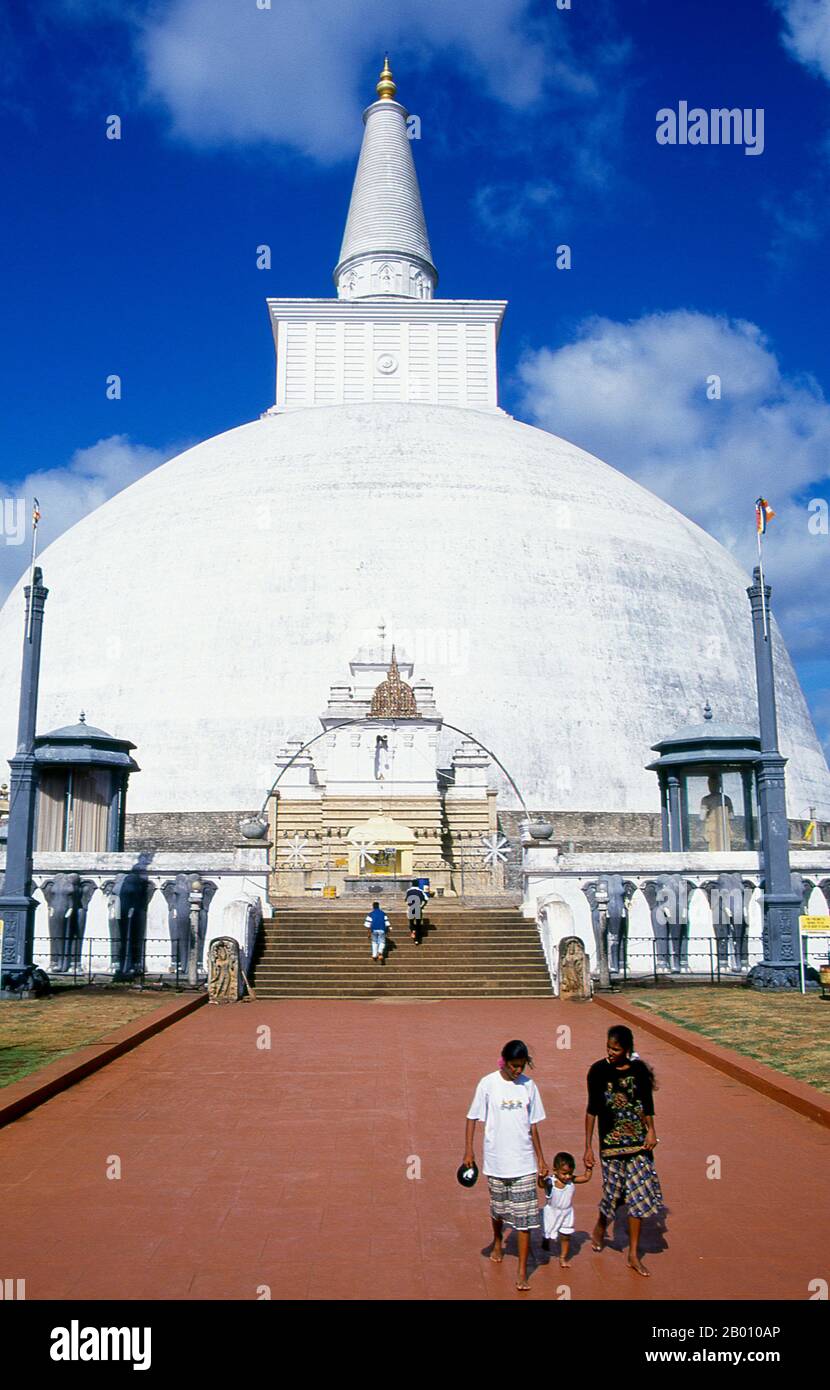 Sri Lanka: Ruvanvelisaya Dagoba, Anuradhapura. Ruvanvelisaya Dagoba was built by King Dutugemunu (r. 161 - 137 BCE). Anuradhapura is one of Sri Lanka's ancient capitals and famous for its well-preserved ruins. From the 4th century BCE until the beginning of the 11th century CE it was the capital. During this period it remained one of the most stable and durable centers of political power and urban life in South Asia. The ancient city, considered sacred to the Buddhist world, is today surrounded by monasteries covering an area of over sixteen square miles (40 km²). Stock Photohttps://www.alamy.com/image-license-details/?v=1https://www.alamy.com/sri-lanka-ruvanvelisaya-dagoba-anuradhapura-ruvanvelisaya-dagoba-was-built-by-king-dutugemunu-r-161-137-bce-anuradhapura-is-one-of-sri-lankas-ancient-capitals-and-famous-for-its-well-preserved-ruins-from-the-4th-century-bce-until-the-beginning-of-the-11th-century-ce-it-was-the-capital-during-this-period-it-remained-one-of-the-most-stable-and-durable-centers-of-political-power-and-urban-life-in-south-asia-the-ancient-city-considered-sacred-to-the-buddhist-world-is-today-surrounded-by-monasteries-covering-an-area-of-over-sixteen-square-miles-40-km-image344229614.html
Sri Lanka: Ruvanvelisaya Dagoba, Anuradhapura. Ruvanvelisaya Dagoba was built by King Dutugemunu (r. 161 - 137 BCE). Anuradhapura is one of Sri Lanka's ancient capitals and famous for its well-preserved ruins. From the 4th century BCE until the beginning of the 11th century CE it was the capital. During this period it remained one of the most stable and durable centers of political power and urban life in South Asia. The ancient city, considered sacred to the Buddhist world, is today surrounded by monasteries covering an area of over sixteen square miles (40 km²). Stock Photohttps://www.alamy.com/image-license-details/?v=1https://www.alamy.com/sri-lanka-ruvanvelisaya-dagoba-anuradhapura-ruvanvelisaya-dagoba-was-built-by-king-dutugemunu-r-161-137-bce-anuradhapura-is-one-of-sri-lankas-ancient-capitals-and-famous-for-its-well-preserved-ruins-from-the-4th-century-bce-until-the-beginning-of-the-11th-century-ce-it-was-the-capital-during-this-period-it-remained-one-of-the-most-stable-and-durable-centers-of-political-power-and-urban-life-in-south-asia-the-ancient-city-considered-sacred-to-the-buddhist-world-is-today-surrounded-by-monasteries-covering-an-area-of-over-sixteen-square-miles-40-km-image344229614.htmlRM2B010AP–Sri Lanka: Ruvanvelisaya Dagoba, Anuradhapura. Ruvanvelisaya Dagoba was built by King Dutugemunu (r. 161 - 137 BCE). Anuradhapura is one of Sri Lanka's ancient capitals and famous for its well-preserved ruins. From the 4th century BCE until the beginning of the 11th century CE it was the capital. During this period it remained one of the most stable and durable centers of political power and urban life in South Asia. The ancient city, considered sacred to the Buddhist world, is today surrounded by monasteries covering an area of over sixteen square miles (40 km²).
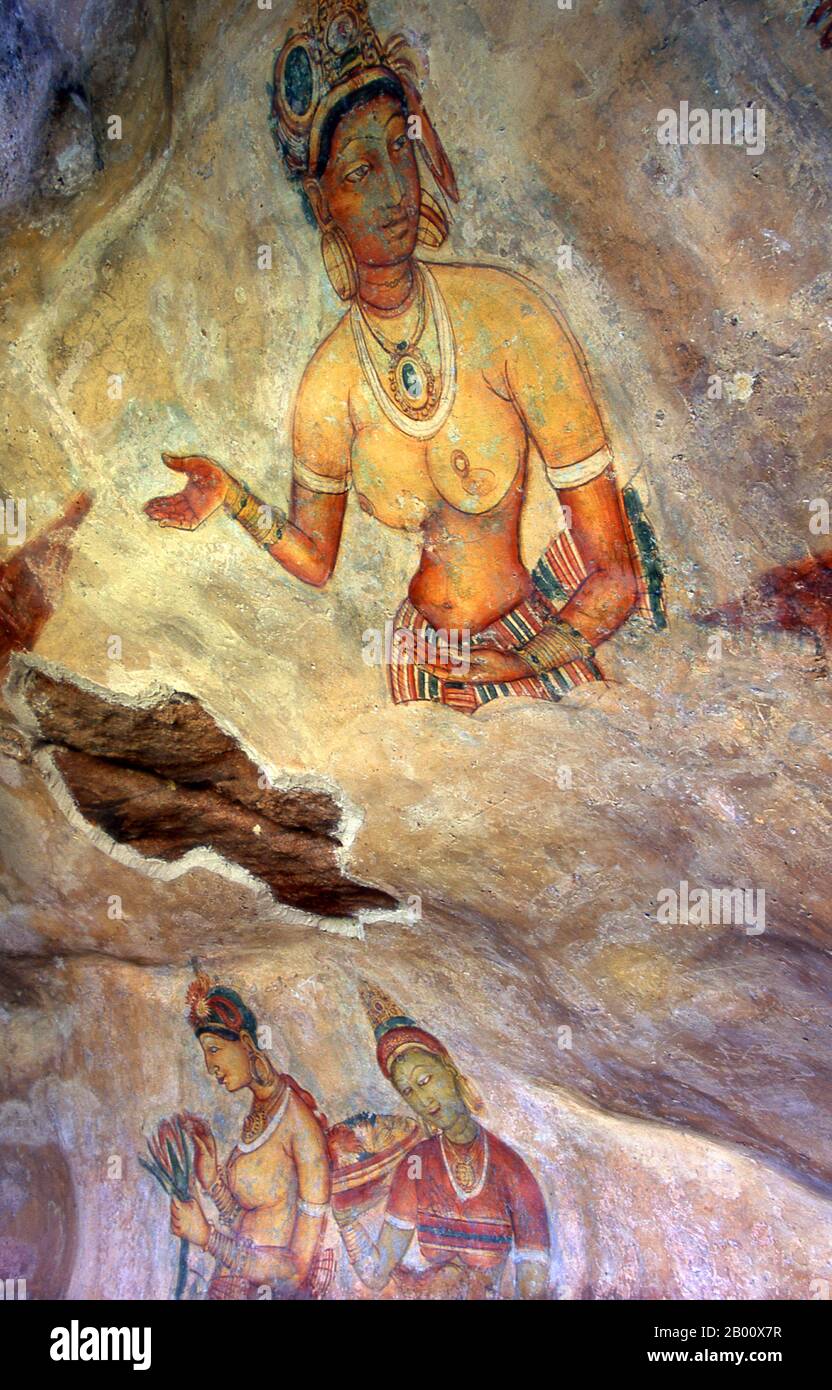 Sri Lanka: Sigiriya's 'Cloud Maidens' adorn the rock face high up over the surrounding countryside. Sigiriya (Lion's rock) is an ancient rock fortress and palace ruin situated in the central Matale District of Sri Lanka, surrounded by the remains of an extensive network of gardens, reservoirs, and other structures. Sigiriya was built during the reign of King Kasyapa I (CE 477 – 495) and after his death it was used as a Buddhist monastery until the 14th century. Stock Photohttps://www.alamy.com/image-license-details/?v=1https://www.alamy.com/sri-lanka-sigiriyas-cloud-maidens-adorn-the-rock-face-high-up-over-the-surrounding-countryside-sigiriya-lions-rock-is-an-ancient-rock-fortress-and-palace-ruin-situated-in-the-central-matale-district-of-sri-lanka-surrounded-by-the-remains-of-an-extensive-network-of-gardens-reservoirs-and-other-structures-sigiriya-was-built-during-the-reign-of-king-kasyapa-i-ce-477-495-and-after-his-death-it-was-used-as-a-buddhist-monastery-until-the-14th-century-image344227963.html
Sri Lanka: Sigiriya's 'Cloud Maidens' adorn the rock face high up over the surrounding countryside. Sigiriya (Lion's rock) is an ancient rock fortress and palace ruin situated in the central Matale District of Sri Lanka, surrounded by the remains of an extensive network of gardens, reservoirs, and other structures. Sigiriya was built during the reign of King Kasyapa I (CE 477 – 495) and after his death it was used as a Buddhist monastery until the 14th century. Stock Photohttps://www.alamy.com/image-license-details/?v=1https://www.alamy.com/sri-lanka-sigiriyas-cloud-maidens-adorn-the-rock-face-high-up-over-the-surrounding-countryside-sigiriya-lions-rock-is-an-ancient-rock-fortress-and-palace-ruin-situated-in-the-central-matale-district-of-sri-lanka-surrounded-by-the-remains-of-an-extensive-network-of-gardens-reservoirs-and-other-structures-sigiriya-was-built-during-the-reign-of-king-kasyapa-i-ce-477-495-and-after-his-death-it-was-used-as-a-buddhist-monastery-until-the-14th-century-image344227963.htmlRM2B00X7R–Sri Lanka: Sigiriya's 'Cloud Maidens' adorn the rock face high up over the surrounding countryside. Sigiriya (Lion's rock) is an ancient rock fortress and palace ruin situated in the central Matale District of Sri Lanka, surrounded by the remains of an extensive network of gardens, reservoirs, and other structures. Sigiriya was built during the reign of King Kasyapa I (CE 477 – 495) and after his death it was used as a Buddhist monastery until the 14th century.
 Sri Lanka: Sigiriya's 'Cloud Maidens' adorn the rock face high up over the surrounding countryside. Sigiriya (Lion's rock) is an ancient rock fortress and palace ruin situated in the central Matale District of Sri Lanka, surrounded by the remains of an extensive network of gardens, reservoirs, and other structures. Sigiriya was built during the reign of King Kasyapa I (CE 477 – 495) and after his death it was used as a Buddhist monastery until the 14th century. Stock Photohttps://www.alamy.com/image-license-details/?v=1https://www.alamy.com/sri-lanka-sigiriyas-cloud-maidens-adorn-the-rock-face-high-up-over-the-surrounding-countryside-sigiriya-lions-rock-is-an-ancient-rock-fortress-and-palace-ruin-situated-in-the-central-matale-district-of-sri-lanka-surrounded-by-the-remains-of-an-extensive-network-of-gardens-reservoirs-and-other-structures-sigiriya-was-built-during-the-reign-of-king-kasyapa-i-ce-477-495-and-after-his-death-it-was-used-as-a-buddhist-monastery-until-the-14th-century-image344227968.html
Sri Lanka: Sigiriya's 'Cloud Maidens' adorn the rock face high up over the surrounding countryside. Sigiriya (Lion's rock) is an ancient rock fortress and palace ruin situated in the central Matale District of Sri Lanka, surrounded by the remains of an extensive network of gardens, reservoirs, and other structures. Sigiriya was built during the reign of King Kasyapa I (CE 477 – 495) and after his death it was used as a Buddhist monastery until the 14th century. Stock Photohttps://www.alamy.com/image-license-details/?v=1https://www.alamy.com/sri-lanka-sigiriyas-cloud-maidens-adorn-the-rock-face-high-up-over-the-surrounding-countryside-sigiriya-lions-rock-is-an-ancient-rock-fortress-and-palace-ruin-situated-in-the-central-matale-district-of-sri-lanka-surrounded-by-the-remains-of-an-extensive-network-of-gardens-reservoirs-and-other-structures-sigiriya-was-built-during-the-reign-of-king-kasyapa-i-ce-477-495-and-after-his-death-it-was-used-as-a-buddhist-monastery-until-the-14th-century-image344227968.htmlRM2B00X80–Sri Lanka: Sigiriya's 'Cloud Maidens' adorn the rock face high up over the surrounding countryside. Sigiriya (Lion's rock) is an ancient rock fortress and palace ruin situated in the central Matale District of Sri Lanka, surrounded by the remains of an extensive network of gardens, reservoirs, and other structures. Sigiriya was built during the reign of King Kasyapa I (CE 477 – 495) and after his death it was used as a Buddhist monastery until the 14th century.
 Sri Lanka: Sigiriya's 'Cloud Maidens' adorn the rock face high up over the surrounding countryside. Sigiriya (Lion's rock) is an ancient rock fortress and palace ruin situated in the central Matale District of Sri Lanka, surrounded by the remains of an extensive network of gardens, reservoirs, and other structures. Sigiriya was built during the reign of King Kasyapa I (CE 477 – 495) and after his death it was used as a Buddhist monastery until the 14th century. Stock Photohttps://www.alamy.com/image-license-details/?v=1https://www.alamy.com/sri-lanka-sigiriyas-cloud-maidens-adorn-the-rock-face-high-up-over-the-surrounding-countryside-sigiriya-lions-rock-is-an-ancient-rock-fortress-and-palace-ruin-situated-in-the-central-matale-district-of-sri-lanka-surrounded-by-the-remains-of-an-extensive-network-of-gardens-reservoirs-and-other-structures-sigiriya-was-built-during-the-reign-of-king-kasyapa-i-ce-477-495-and-after-his-death-it-was-used-as-a-buddhist-monastery-until-the-14th-century-image344227967.html
Sri Lanka: Sigiriya's 'Cloud Maidens' adorn the rock face high up over the surrounding countryside. Sigiriya (Lion's rock) is an ancient rock fortress and palace ruin situated in the central Matale District of Sri Lanka, surrounded by the remains of an extensive network of gardens, reservoirs, and other structures. Sigiriya was built during the reign of King Kasyapa I (CE 477 – 495) and after his death it was used as a Buddhist monastery until the 14th century. Stock Photohttps://www.alamy.com/image-license-details/?v=1https://www.alamy.com/sri-lanka-sigiriyas-cloud-maidens-adorn-the-rock-face-high-up-over-the-surrounding-countryside-sigiriya-lions-rock-is-an-ancient-rock-fortress-and-palace-ruin-situated-in-the-central-matale-district-of-sri-lanka-surrounded-by-the-remains-of-an-extensive-network-of-gardens-reservoirs-and-other-structures-sigiriya-was-built-during-the-reign-of-king-kasyapa-i-ce-477-495-and-after-his-death-it-was-used-as-a-buddhist-monastery-until-the-14th-century-image344227967.htmlRM2B00X7Y–Sri Lanka: Sigiriya's 'Cloud Maidens' adorn the rock face high up over the surrounding countryside. Sigiriya (Lion's rock) is an ancient rock fortress and palace ruin situated in the central Matale District of Sri Lanka, surrounded by the remains of an extensive network of gardens, reservoirs, and other structures. Sigiriya was built during the reign of King Kasyapa I (CE 477 – 495) and after his death it was used as a Buddhist monastery until the 14th century.
 Sri Lanka: Sigiriya's 'Cloud Maidens' adorn the rock face high up over the surrounding countryside. Sigiriya (Lion's rock) is an ancient rock fortress and palace ruin situated in the central Matale District of Sri Lanka, surrounded by the remains of an extensive network of gardens, reservoirs, and other structures. Sigiriya was built during the reign of King Kasyapa I (CE 477 – 495) and after his death it was used as a Buddhist monastery until the 14th century. Stock Photohttps://www.alamy.com/image-license-details/?v=1https://www.alamy.com/sri-lanka-sigiriyas-cloud-maidens-adorn-the-rock-face-high-up-over-the-surrounding-countryside-sigiriya-lions-rock-is-an-ancient-rock-fortress-and-palace-ruin-situated-in-the-central-matale-district-of-sri-lanka-surrounded-by-the-remains-of-an-extensive-network-of-gardens-reservoirs-and-other-structures-sigiriya-was-built-during-the-reign-of-king-kasyapa-i-ce-477-495-and-after-his-death-it-was-used-as-a-buddhist-monastery-until-the-14th-century-image344227970.html
Sri Lanka: Sigiriya's 'Cloud Maidens' adorn the rock face high up over the surrounding countryside. Sigiriya (Lion's rock) is an ancient rock fortress and palace ruin situated in the central Matale District of Sri Lanka, surrounded by the remains of an extensive network of gardens, reservoirs, and other structures. Sigiriya was built during the reign of King Kasyapa I (CE 477 – 495) and after his death it was used as a Buddhist monastery until the 14th century. Stock Photohttps://www.alamy.com/image-license-details/?v=1https://www.alamy.com/sri-lanka-sigiriyas-cloud-maidens-adorn-the-rock-face-high-up-over-the-surrounding-countryside-sigiriya-lions-rock-is-an-ancient-rock-fortress-and-palace-ruin-situated-in-the-central-matale-district-of-sri-lanka-surrounded-by-the-remains-of-an-extensive-network-of-gardens-reservoirs-and-other-structures-sigiriya-was-built-during-the-reign-of-king-kasyapa-i-ce-477-495-and-after-his-death-it-was-used-as-a-buddhist-monastery-until-the-14th-century-image344227970.htmlRM2B00X82–Sri Lanka: Sigiriya's 'Cloud Maidens' adorn the rock face high up over the surrounding countryside. Sigiriya (Lion's rock) is an ancient rock fortress and palace ruin situated in the central Matale District of Sri Lanka, surrounded by the remains of an extensive network of gardens, reservoirs, and other structures. Sigiriya was built during the reign of King Kasyapa I (CE 477 – 495) and after his death it was used as a Buddhist monastery until the 14th century.
 Sri Lanka: Sigiriya's 'Cloud Maidens' adorn the rock face high up over the surrounding countryside. Sigiriya (Lion's rock) is an ancient rock fortress and palace ruin situated in the central Matale District of Sri Lanka, surrounded by the remains of an extensive network of gardens, reservoirs, and other structures. Sigiriya was built during the reign of King Kasyapa I (CE 477 – 495) and after his death it was used as a Buddhist monastery until the 14th century. Stock Photohttps://www.alamy.com/image-license-details/?v=1https://www.alamy.com/sri-lanka-sigiriyas-cloud-maidens-adorn-the-rock-face-high-up-over-the-surrounding-countryside-sigiriya-lions-rock-is-an-ancient-rock-fortress-and-palace-ruin-situated-in-the-central-matale-district-of-sri-lanka-surrounded-by-the-remains-of-an-extensive-network-of-gardens-reservoirs-and-other-structures-sigiriya-was-built-during-the-reign-of-king-kasyapa-i-ce-477-495-and-after-his-death-it-was-used-as-a-buddhist-monastery-until-the-14th-century-image344227964.html
Sri Lanka: Sigiriya's 'Cloud Maidens' adorn the rock face high up over the surrounding countryside. Sigiriya (Lion's rock) is an ancient rock fortress and palace ruin situated in the central Matale District of Sri Lanka, surrounded by the remains of an extensive network of gardens, reservoirs, and other structures. Sigiriya was built during the reign of King Kasyapa I (CE 477 – 495) and after his death it was used as a Buddhist monastery until the 14th century. Stock Photohttps://www.alamy.com/image-license-details/?v=1https://www.alamy.com/sri-lanka-sigiriyas-cloud-maidens-adorn-the-rock-face-high-up-over-the-surrounding-countryside-sigiriya-lions-rock-is-an-ancient-rock-fortress-and-palace-ruin-situated-in-the-central-matale-district-of-sri-lanka-surrounded-by-the-remains-of-an-extensive-network-of-gardens-reservoirs-and-other-structures-sigiriya-was-built-during-the-reign-of-king-kasyapa-i-ce-477-495-and-after-his-death-it-was-used-as-a-buddhist-monastery-until-the-14th-century-image344227964.htmlRM2B00X7T–Sri Lanka: Sigiriya's 'Cloud Maidens' adorn the rock face high up over the surrounding countryside. Sigiriya (Lion's rock) is an ancient rock fortress and palace ruin situated in the central Matale District of Sri Lanka, surrounded by the remains of an extensive network of gardens, reservoirs, and other structures. Sigiriya was built during the reign of King Kasyapa I (CE 477 – 495) and after his death it was used as a Buddhist monastery until the 14th century.
 Sri Lanka: Sigiriya's 'Cloud Maidens' adorn the rock face high up over the surrounding countryside. Sigiriya (Lion's rock) is an ancient rock fortress and palace ruin situated in the central Matale District of Sri Lanka, surrounded by the remains of an extensive network of gardens, reservoirs, and other structures. Sigiriya was built during the reign of King Kasyapa I (CE 477 – 495) and after his death it was used as a Buddhist monastery until the 14th century. Stock Photohttps://www.alamy.com/image-license-details/?v=1https://www.alamy.com/sri-lanka-sigiriyas-cloud-maidens-adorn-the-rock-face-high-up-over-the-surrounding-countryside-sigiriya-lions-rock-is-an-ancient-rock-fortress-and-palace-ruin-situated-in-the-central-matale-district-of-sri-lanka-surrounded-by-the-remains-of-an-extensive-network-of-gardens-reservoirs-and-other-structures-sigiriya-was-built-during-the-reign-of-king-kasyapa-i-ce-477-495-and-after-his-death-it-was-used-as-a-buddhist-monastery-until-the-14th-century-image344227966.html
Sri Lanka: Sigiriya's 'Cloud Maidens' adorn the rock face high up over the surrounding countryside. Sigiriya (Lion's rock) is an ancient rock fortress and palace ruin situated in the central Matale District of Sri Lanka, surrounded by the remains of an extensive network of gardens, reservoirs, and other structures. Sigiriya was built during the reign of King Kasyapa I (CE 477 – 495) and after his death it was used as a Buddhist monastery until the 14th century. Stock Photohttps://www.alamy.com/image-license-details/?v=1https://www.alamy.com/sri-lanka-sigiriyas-cloud-maidens-adorn-the-rock-face-high-up-over-the-surrounding-countryside-sigiriya-lions-rock-is-an-ancient-rock-fortress-and-palace-ruin-situated-in-the-central-matale-district-of-sri-lanka-surrounded-by-the-remains-of-an-extensive-network-of-gardens-reservoirs-and-other-structures-sigiriya-was-built-during-the-reign-of-king-kasyapa-i-ce-477-495-and-after-his-death-it-was-used-as-a-buddhist-monastery-until-the-14th-century-image344227966.htmlRM2B00X7X–Sri Lanka: Sigiriya's 'Cloud Maidens' adorn the rock face high up over the surrounding countryside. Sigiriya (Lion's rock) is an ancient rock fortress and palace ruin situated in the central Matale District of Sri Lanka, surrounded by the remains of an extensive network of gardens, reservoirs, and other structures. Sigiriya was built during the reign of King Kasyapa I (CE 477 – 495) and after his death it was used as a Buddhist monastery until the 14th century.
 Sri Lanka: Sigiriya's 'Cloud Maidens' adorn the rock face high up over the surrounding countryside. Sigiriya (Lion's rock) is an ancient rock fortress and palace ruin situated in the central Matale District of Sri Lanka, surrounded by the remains of an extensive network of gardens, reservoirs, and other structures. Sigiriya was built during the reign of King Kasyapa I (CE 477 – 495) and after his death it was used as a Buddhist monastery until the 14th century. Stock Photohttps://www.alamy.com/image-license-details/?v=1https://www.alamy.com/sri-lanka-sigiriyas-cloud-maidens-adorn-the-rock-face-high-up-over-the-surrounding-countryside-sigiriya-lions-rock-is-an-ancient-rock-fortress-and-palace-ruin-situated-in-the-central-matale-district-of-sri-lanka-surrounded-by-the-remains-of-an-extensive-network-of-gardens-reservoirs-and-other-structures-sigiriya-was-built-during-the-reign-of-king-kasyapa-i-ce-477-495-and-after-his-death-it-was-used-as-a-buddhist-monastery-until-the-14th-century-image344227971.html
Sri Lanka: Sigiriya's 'Cloud Maidens' adorn the rock face high up over the surrounding countryside. Sigiriya (Lion's rock) is an ancient rock fortress and palace ruin situated in the central Matale District of Sri Lanka, surrounded by the remains of an extensive network of gardens, reservoirs, and other structures. Sigiriya was built during the reign of King Kasyapa I (CE 477 – 495) and after his death it was used as a Buddhist monastery until the 14th century. Stock Photohttps://www.alamy.com/image-license-details/?v=1https://www.alamy.com/sri-lanka-sigiriyas-cloud-maidens-adorn-the-rock-face-high-up-over-the-surrounding-countryside-sigiriya-lions-rock-is-an-ancient-rock-fortress-and-palace-ruin-situated-in-the-central-matale-district-of-sri-lanka-surrounded-by-the-remains-of-an-extensive-network-of-gardens-reservoirs-and-other-structures-sigiriya-was-built-during-the-reign-of-king-kasyapa-i-ce-477-495-and-after-his-death-it-was-used-as-a-buddhist-monastery-until-the-14th-century-image344227971.htmlRM2B00X83–Sri Lanka: Sigiriya's 'Cloud Maidens' adorn the rock face high up over the surrounding countryside. Sigiriya (Lion's rock) is an ancient rock fortress and palace ruin situated in the central Matale District of Sri Lanka, surrounded by the remains of an extensive network of gardens, reservoirs, and other structures. Sigiriya was built during the reign of King Kasyapa I (CE 477 – 495) and after his death it was used as a Buddhist monastery until the 14th century.
 Sri Lanka: Sigiriya's 'Cloud Maidens' adorn the rock face high up over the surrounding countryside. Sigiriya (Lion's rock) is an ancient rock fortress and palace ruin situated in the central Matale District of Sri Lanka, surrounded by the remains of an extensive network of gardens, reservoirs, and other structures. Sigiriya was built during the reign of King Kasyapa I (CE 477 – 495) and after his death it was used as a Buddhist monastery until the 14th century. Stock Photohttps://www.alamy.com/image-license-details/?v=1https://www.alamy.com/sri-lanka-sigiriyas-cloud-maidens-adorn-the-rock-face-high-up-over-the-surrounding-countryside-sigiriya-lions-rock-is-an-ancient-rock-fortress-and-palace-ruin-situated-in-the-central-matale-district-of-sri-lanka-surrounded-by-the-remains-of-an-extensive-network-of-gardens-reservoirs-and-other-structures-sigiriya-was-built-during-the-reign-of-king-kasyapa-i-ce-477-495-and-after-his-death-it-was-used-as-a-buddhist-monastery-until-the-14th-century-image344227965.html
Sri Lanka: Sigiriya's 'Cloud Maidens' adorn the rock face high up over the surrounding countryside. Sigiriya (Lion's rock) is an ancient rock fortress and palace ruin situated in the central Matale District of Sri Lanka, surrounded by the remains of an extensive network of gardens, reservoirs, and other structures. Sigiriya was built during the reign of King Kasyapa I (CE 477 – 495) and after his death it was used as a Buddhist monastery until the 14th century. Stock Photohttps://www.alamy.com/image-license-details/?v=1https://www.alamy.com/sri-lanka-sigiriyas-cloud-maidens-adorn-the-rock-face-high-up-over-the-surrounding-countryside-sigiriya-lions-rock-is-an-ancient-rock-fortress-and-palace-ruin-situated-in-the-central-matale-district-of-sri-lanka-surrounded-by-the-remains-of-an-extensive-network-of-gardens-reservoirs-and-other-structures-sigiriya-was-built-during-the-reign-of-king-kasyapa-i-ce-477-495-and-after-his-death-it-was-used-as-a-buddhist-monastery-until-the-14th-century-image344227965.htmlRM2B00X7W–Sri Lanka: Sigiriya's 'Cloud Maidens' adorn the rock face high up over the surrounding countryside. Sigiriya (Lion's rock) is an ancient rock fortress and palace ruin situated in the central Matale District of Sri Lanka, surrounded by the remains of an extensive network of gardens, reservoirs, and other structures. Sigiriya was built during the reign of King Kasyapa I (CE 477 – 495) and after his death it was used as a Buddhist monastery until the 14th century.
 Sri Lanka: Ruvanvelisaya Dagoba, Anuradhapura. Ruvanvelisaya Dagoba was built by King Dutugemunu (r. 161 - 137 BCE). Anuradhapura is one of Sri Lanka's ancient capitals and famous for its well-preserved ruins. From the 4th century BCE until the beginning of the 11th century CE it was the capital. During this period it remained one of the most stable and durable centers of political power and urban life in South Asia. The ancient city, considered sacred to the Buddhist world, is today surrounded by monasteries covering an area of over sixteen square miles (40 km²). Stock Photohttps://www.alamy.com/image-license-details/?v=1https://www.alamy.com/sri-lanka-ruvanvelisaya-dagoba-anuradhapura-ruvanvelisaya-dagoba-was-built-by-king-dutugemunu-r-161-137-bce-anuradhapura-is-one-of-sri-lankas-ancient-capitals-and-famous-for-its-well-preserved-ruins-from-the-4th-century-bce-until-the-beginning-of-the-11th-century-ce-it-was-the-capital-during-this-period-it-remained-one-of-the-most-stable-and-durable-centers-of-political-power-and-urban-life-in-south-asia-the-ancient-city-considered-sacred-to-the-buddhist-world-is-today-surrounded-by-monasteries-covering-an-area-of-over-sixteen-square-miles-40-km-image344229620.html
Sri Lanka: Ruvanvelisaya Dagoba, Anuradhapura. Ruvanvelisaya Dagoba was built by King Dutugemunu (r. 161 - 137 BCE). Anuradhapura is one of Sri Lanka's ancient capitals and famous for its well-preserved ruins. From the 4th century BCE until the beginning of the 11th century CE it was the capital. During this period it remained one of the most stable and durable centers of political power and urban life in South Asia. The ancient city, considered sacred to the Buddhist world, is today surrounded by monasteries covering an area of over sixteen square miles (40 km²). Stock Photohttps://www.alamy.com/image-license-details/?v=1https://www.alamy.com/sri-lanka-ruvanvelisaya-dagoba-anuradhapura-ruvanvelisaya-dagoba-was-built-by-king-dutugemunu-r-161-137-bce-anuradhapura-is-one-of-sri-lankas-ancient-capitals-and-famous-for-its-well-preserved-ruins-from-the-4th-century-bce-until-the-beginning-of-the-11th-century-ce-it-was-the-capital-during-this-period-it-remained-one-of-the-most-stable-and-durable-centers-of-political-power-and-urban-life-in-south-asia-the-ancient-city-considered-sacred-to-the-buddhist-world-is-today-surrounded-by-monasteries-covering-an-area-of-over-sixteen-square-miles-40-km-image344229620.htmlRM2B010B0–Sri Lanka: Ruvanvelisaya Dagoba, Anuradhapura. Ruvanvelisaya Dagoba was built by King Dutugemunu (r. 161 - 137 BCE). Anuradhapura is one of Sri Lanka's ancient capitals and famous for its well-preserved ruins. From the 4th century BCE until the beginning of the 11th century CE it was the capital. During this period it remained one of the most stable and durable centers of political power and urban life in South Asia. The ancient city, considered sacred to the Buddhist world, is today surrounded by monasteries covering an area of over sixteen square miles (40 km²).
RM2B0136N–India: Mandapas (columned halls) at the Vitthala Temple, Hampi, Karnataka State. The Vittala Temple, built in the early 16th century, is devoted to the Hindu god Vithoba (also known as Vitthala and Panduranga), an incarnation of Vishnu or his avatar Krishna. Hampi is a village in northern Karnataka state. It is located within the ruins of Vijayanagara, the former capital of the Vijayanagara Empire. Predating the city of Vijayanagara, it continues to be an important religious centre, housing the Virupaksha Temple, as well as several other monuments belonging to the old city.
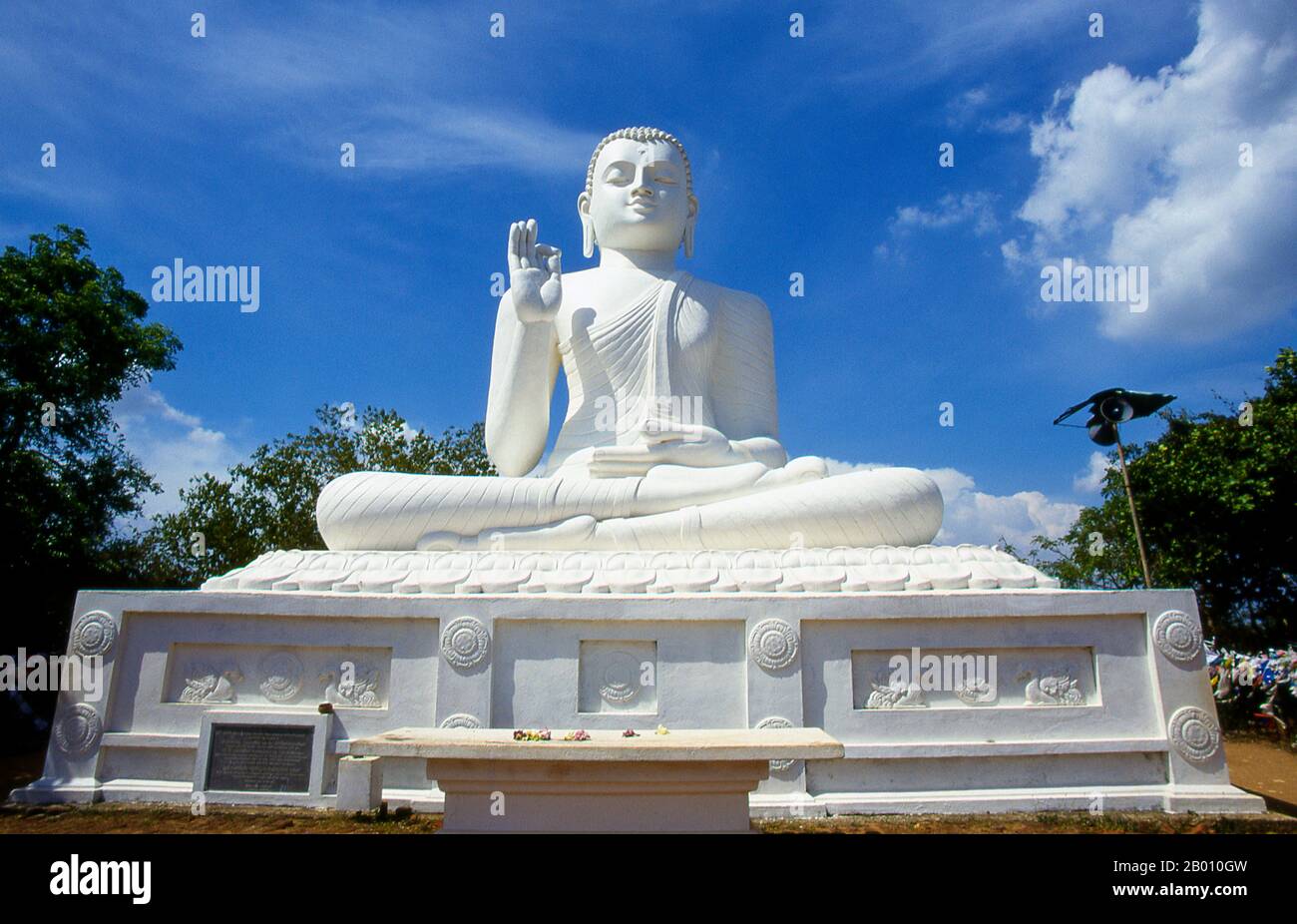 Sri Lanka: Giant seated Buddha at Ambasthala Dagoba, Mihintale. Mihintale is a mountain peak near Anuradhapura that is believed by Sri Lankans to be the site of a meeting between the Buddhist monk Mahinda and King Devanampiyatissa which inaugurated the presence of Buddhism in Sri Lanka. It is now a pilgrimage site, and the site of several religious monuments and abandoned structures. Stock Photohttps://www.alamy.com/image-license-details/?v=1https://www.alamy.com/sri-lanka-giant-seated-buddha-at-ambasthala-dagoba-mihintale-mihintale-is-a-mountain-peak-near-anuradhapura-that-is-believed-by-sri-lankans-to-be-the-site-of-a-meeting-between-the-buddhist-monk-mahinda-and-king-devanampiyatissa-which-inaugurated-the-presence-of-buddhism-in-sri-lanka-it-is-now-a-pilgrimage-site-and-the-site-of-several-religious-monuments-and-abandoned-structures-image344229785.html
Sri Lanka: Giant seated Buddha at Ambasthala Dagoba, Mihintale. Mihintale is a mountain peak near Anuradhapura that is believed by Sri Lankans to be the site of a meeting between the Buddhist monk Mahinda and King Devanampiyatissa which inaugurated the presence of Buddhism in Sri Lanka. It is now a pilgrimage site, and the site of several religious monuments and abandoned structures. Stock Photohttps://www.alamy.com/image-license-details/?v=1https://www.alamy.com/sri-lanka-giant-seated-buddha-at-ambasthala-dagoba-mihintale-mihintale-is-a-mountain-peak-near-anuradhapura-that-is-believed-by-sri-lankans-to-be-the-site-of-a-meeting-between-the-buddhist-monk-mahinda-and-king-devanampiyatissa-which-inaugurated-the-presence-of-buddhism-in-sri-lanka-it-is-now-a-pilgrimage-site-and-the-site-of-several-religious-monuments-and-abandoned-structures-image344229785.htmlRM2B010GW–Sri Lanka: Giant seated Buddha at Ambasthala Dagoba, Mihintale. Mihintale is a mountain peak near Anuradhapura that is believed by Sri Lankans to be the site of a meeting between the Buddhist monk Mahinda and King Devanampiyatissa which inaugurated the presence of Buddhism in Sri Lanka. It is now a pilgrimage site, and the site of several religious monuments and abandoned structures.
 Sri Lanka: Mahinda's statue, Ambasthala (Mango tree) Dagoba, Mihintale. Mihintale is a mountain peak near Anuradhapura that is believed by Sri Lankans to be the site of a meeting between the Buddhist monk Mahinda and King Devanampiyatissa which inaugurated the presence of Buddhism in Sri Lanka. It is now a pilgrimage site, and the site of several religious monuments and abandoned structures. Stock Photohttps://www.alamy.com/image-license-details/?v=1https://www.alamy.com/sri-lanka-mahindas-statue-ambasthala-mango-tree-dagoba-mihintale-mihintale-is-a-mountain-peak-near-anuradhapura-that-is-believed-by-sri-lankans-to-be-the-site-of-a-meeting-between-the-buddhist-monk-mahinda-and-king-devanampiyatissa-which-inaugurated-the-presence-of-buddhism-in-sri-lanka-it-is-now-a-pilgrimage-site-and-the-site-of-several-religious-monuments-and-abandoned-structures-image344229787.html
Sri Lanka: Mahinda's statue, Ambasthala (Mango tree) Dagoba, Mihintale. Mihintale is a mountain peak near Anuradhapura that is believed by Sri Lankans to be the site of a meeting between the Buddhist monk Mahinda and King Devanampiyatissa which inaugurated the presence of Buddhism in Sri Lanka. It is now a pilgrimage site, and the site of several religious monuments and abandoned structures. Stock Photohttps://www.alamy.com/image-license-details/?v=1https://www.alamy.com/sri-lanka-mahindas-statue-ambasthala-mango-tree-dagoba-mihintale-mihintale-is-a-mountain-peak-near-anuradhapura-that-is-believed-by-sri-lankans-to-be-the-site-of-a-meeting-between-the-buddhist-monk-mahinda-and-king-devanampiyatissa-which-inaugurated-the-presence-of-buddhism-in-sri-lanka-it-is-now-a-pilgrimage-site-and-the-site-of-several-religious-monuments-and-abandoned-structures-image344229787.htmlRM2B010GY–Sri Lanka: Mahinda's statue, Ambasthala (Mango tree) Dagoba, Mihintale. Mihintale is a mountain peak near Anuradhapura that is believed by Sri Lankans to be the site of a meeting between the Buddhist monk Mahinda and King Devanampiyatissa which inaugurated the presence of Buddhism in Sri Lanka. It is now a pilgrimage site, and the site of several religious monuments and abandoned structures.
 Sri Lanka: Reclining Buddha at Gal Vihara, Polonnaruwa. Gal Vihara, a Buddhist rock temple, was constructed in the 12th century by King Parakramabahu I (1123 - 1186). Polonnaruwa, the second most ancient of Sri Lanka's kingdoms, was first declared the capital city by King Vijayabahu I, who defeated the Chola invaders in 1070 CE to reunite the country under a national leader. Stock Photohttps://www.alamy.com/image-license-details/?v=1https://www.alamy.com/sri-lanka-reclining-buddha-at-gal-vihara-polonnaruwa-gal-vihara-a-buddhist-rock-temple-was-constructed-in-the-12th-century-by-king-parakramabahu-i-1123-1186-polonnaruwa-the-second-most-ancient-of-sri-lankas-kingdoms-was-first-declared-the-capital-city-by-king-vijayabahu-i-who-defeated-the-chola-invaders-in-1070-ce-to-reunite-the-country-under-a-national-leader-image344229886.html
Sri Lanka: Reclining Buddha at Gal Vihara, Polonnaruwa. Gal Vihara, a Buddhist rock temple, was constructed in the 12th century by King Parakramabahu I (1123 - 1186). Polonnaruwa, the second most ancient of Sri Lanka's kingdoms, was first declared the capital city by King Vijayabahu I, who defeated the Chola invaders in 1070 CE to reunite the country under a national leader. Stock Photohttps://www.alamy.com/image-license-details/?v=1https://www.alamy.com/sri-lanka-reclining-buddha-at-gal-vihara-polonnaruwa-gal-vihara-a-buddhist-rock-temple-was-constructed-in-the-12th-century-by-king-parakramabahu-i-1123-1186-polonnaruwa-the-second-most-ancient-of-sri-lankas-kingdoms-was-first-declared-the-capital-city-by-king-vijayabahu-i-who-defeated-the-chola-invaders-in-1070-ce-to-reunite-the-country-under-a-national-leader-image344229886.htmlRM2B010ME–Sri Lanka: Reclining Buddha at Gal Vihara, Polonnaruwa. Gal Vihara, a Buddhist rock temple, was constructed in the 12th century by King Parakramabahu I (1123 - 1186). Polonnaruwa, the second most ancient of Sri Lanka's kingdoms, was first declared the capital city by King Vijayabahu I, who defeated the Chola invaders in 1070 CE to reunite the country under a national leader.
 Sri Lanka: Buddha's birth, depicted in a mural in the Temple of the Tooth, Kandy. Sri Dalada Maligawa or The Temple of the Sacred Tooth Relic is located in the royal palace complex and houses the Relic of the tooth of Buddha. Since ancient times, the relic has played an important role in local politics because it is believed that whoever holds the relic holds the governance of the country. Stock Photohttps://www.alamy.com/image-license-details/?v=1https://www.alamy.com/sri-lanka-buddhas-birth-depicted-in-a-mural-in-the-temple-of-the-tooth-kandy-sri-dalada-maligawa-or-the-temple-of-the-sacred-tooth-relic-is-located-in-the-royal-palace-complex-and-houses-the-relic-of-the-tooth-of-buddha-since-ancient-times-the-relic-has-played-an-important-role-in-local-politics-because-it-is-believed-that-whoever-holds-the-relic-holds-the-governance-of-the-country-image344229804.html
Sri Lanka: Buddha's birth, depicted in a mural in the Temple of the Tooth, Kandy. Sri Dalada Maligawa or The Temple of the Sacred Tooth Relic is located in the royal palace complex and houses the Relic of the tooth of Buddha. Since ancient times, the relic has played an important role in local politics because it is believed that whoever holds the relic holds the governance of the country. Stock Photohttps://www.alamy.com/image-license-details/?v=1https://www.alamy.com/sri-lanka-buddhas-birth-depicted-in-a-mural-in-the-temple-of-the-tooth-kandy-sri-dalada-maligawa-or-the-temple-of-the-sacred-tooth-relic-is-located-in-the-royal-palace-complex-and-houses-the-relic-of-the-tooth-of-buddha-since-ancient-times-the-relic-has-played-an-important-role-in-local-politics-because-it-is-believed-that-whoever-holds-the-relic-holds-the-governance-of-the-country-image344229804.htmlRM2B010HG–Sri Lanka: Buddha's birth, depicted in a mural in the Temple of the Tooth, Kandy. Sri Dalada Maligawa or The Temple of the Sacred Tooth Relic is located in the royal palace complex and houses the Relic of the tooth of Buddha. Since ancient times, the relic has played an important role in local politics because it is believed that whoever holds the relic holds the governance of the country.
 Sri Lanka: Return of the Tooth, depicted in a mural in the Temple of the Tooth, Kandy. Sri Dalada Maligawa or The Temple of the Sacred Tooth Relic is located in the royal palace complex and houses the Relic of the tooth of Buddha. Since ancient times, the relic has played an important role in local politics because it is believed that whoever holds the relic holds the governance of the country. Stock Photohttps://www.alamy.com/image-license-details/?v=1https://www.alamy.com/sri-lanka-return-of-the-tooth-depicted-in-a-mural-in-the-temple-of-the-tooth-kandy-sri-dalada-maligawa-or-the-temple-of-the-sacred-tooth-relic-is-located-in-the-royal-palace-complex-and-houses-the-relic-of-the-tooth-of-buddha-since-ancient-times-the-relic-has-played-an-important-role-in-local-politics-because-it-is-believed-that-whoever-holds-the-relic-holds-the-governance-of-the-country-image344229803.html
Sri Lanka: Return of the Tooth, depicted in a mural in the Temple of the Tooth, Kandy. Sri Dalada Maligawa or The Temple of the Sacred Tooth Relic is located in the royal palace complex and houses the Relic of the tooth of Buddha. Since ancient times, the relic has played an important role in local politics because it is believed that whoever holds the relic holds the governance of the country. Stock Photohttps://www.alamy.com/image-license-details/?v=1https://www.alamy.com/sri-lanka-return-of-the-tooth-depicted-in-a-mural-in-the-temple-of-the-tooth-kandy-sri-dalada-maligawa-or-the-temple-of-the-sacred-tooth-relic-is-located-in-the-royal-palace-complex-and-houses-the-relic-of-the-tooth-of-buddha-since-ancient-times-the-relic-has-played-an-important-role-in-local-politics-because-it-is-believed-that-whoever-holds-the-relic-holds-the-governance-of-the-country-image344229803.htmlRM2B010HF–Sri Lanka: Return of the Tooth, depicted in a mural in the Temple of the Tooth, Kandy. Sri Dalada Maligawa or The Temple of the Sacred Tooth Relic is located in the royal palace complex and houses the Relic of the tooth of Buddha. Since ancient times, the relic has played an important role in local politics because it is believed that whoever holds the relic holds the governance of the country.
 Sri Lanka: Return of the Tooth, depicted in a mural in the Temple of the Tooth, Kandy. Sri Dalada Maligawa or The Temple of the Sacred Tooth Relic is located in the royal palace complex and houses the Relic of the tooth of Buddha. Since ancient times, the relic has played an important role in local politics because it is believed that whoever holds the relic holds the governance of the country. Stock Photohttps://www.alamy.com/image-license-details/?v=1https://www.alamy.com/sri-lanka-return-of-the-tooth-depicted-in-a-mural-in-the-temple-of-the-tooth-kandy-sri-dalada-maligawa-or-the-temple-of-the-sacred-tooth-relic-is-located-in-the-royal-palace-complex-and-houses-the-relic-of-the-tooth-of-buddha-since-ancient-times-the-relic-has-played-an-important-role-in-local-politics-because-it-is-believed-that-whoever-holds-the-relic-holds-the-governance-of-the-country-image344229801.html
Sri Lanka: Return of the Tooth, depicted in a mural in the Temple of the Tooth, Kandy. Sri Dalada Maligawa or The Temple of the Sacred Tooth Relic is located in the royal palace complex and houses the Relic of the tooth of Buddha. Since ancient times, the relic has played an important role in local politics because it is believed that whoever holds the relic holds the governance of the country. Stock Photohttps://www.alamy.com/image-license-details/?v=1https://www.alamy.com/sri-lanka-return-of-the-tooth-depicted-in-a-mural-in-the-temple-of-the-tooth-kandy-sri-dalada-maligawa-or-the-temple-of-the-sacred-tooth-relic-is-located-in-the-royal-palace-complex-and-houses-the-relic-of-the-tooth-of-buddha-since-ancient-times-the-relic-has-played-an-important-role-in-local-politics-because-it-is-believed-that-whoever-holds-the-relic-holds-the-governance-of-the-country-image344229801.htmlRM2B010HD–Sri Lanka: Return of the Tooth, depicted in a mural in the Temple of the Tooth, Kandy. Sri Dalada Maligawa or The Temple of the Sacred Tooth Relic is located in the royal palace complex and houses the Relic of the tooth of Buddha. Since ancient times, the relic has played an important role in local politics because it is believed that whoever holds the relic holds the governance of the country.
 Sri Lanka: Frieze of 'The Lovers', Isurumuniya temple museum, Anuradhapura. Isurumuniya Vihara is a rock temple built during the reign of King Devanampiya Tissa (r. 307 - 267 BCE). Anuradhapura is one of Sri Lanka's ancient capitals and famous for its well-preserved ruins. From the 4th century BCE until the beginning of the 11th century CE it was the capital. During this period it remained one of the most stable and durable centers of political power and urban life in South Asia. The ancient city, considered sacred to the Buddhist world, is today surrounded by monasteries. Stock Photohttps://www.alamy.com/image-license-details/?v=1https://www.alamy.com/sri-lanka-frieze-of-the-lovers-isurumuniya-temple-museum-anuradhapura-isurumuniya-vihara-is-a-rock-temple-built-during-the-reign-of-king-devanampiya-tissa-r-307-267-bce-anuradhapura-is-one-of-sri-lankas-ancient-capitals-and-famous-for-its-well-preserved-ruins-from-the-4th-century-bce-until-the-beginning-of-the-11th-century-ce-it-was-the-capital-during-this-period-it-remained-one-of-the-most-stable-and-durable-centers-of-political-power-and-urban-life-in-south-asia-the-ancient-city-considered-sacred-to-the-buddhist-world-is-today-surrounded-by-monasteries-image344229612.html
Sri Lanka: Frieze of 'The Lovers', Isurumuniya temple museum, Anuradhapura. Isurumuniya Vihara is a rock temple built during the reign of King Devanampiya Tissa (r. 307 - 267 BCE). Anuradhapura is one of Sri Lanka's ancient capitals and famous for its well-preserved ruins. From the 4th century BCE until the beginning of the 11th century CE it was the capital. During this period it remained one of the most stable and durable centers of political power and urban life in South Asia. The ancient city, considered sacred to the Buddhist world, is today surrounded by monasteries. Stock Photohttps://www.alamy.com/image-license-details/?v=1https://www.alamy.com/sri-lanka-frieze-of-the-lovers-isurumuniya-temple-museum-anuradhapura-isurumuniya-vihara-is-a-rock-temple-built-during-the-reign-of-king-devanampiya-tissa-r-307-267-bce-anuradhapura-is-one-of-sri-lankas-ancient-capitals-and-famous-for-its-well-preserved-ruins-from-the-4th-century-bce-until-the-beginning-of-the-11th-century-ce-it-was-the-capital-during-this-period-it-remained-one-of-the-most-stable-and-durable-centers-of-political-power-and-urban-life-in-south-asia-the-ancient-city-considered-sacred-to-the-buddhist-world-is-today-surrounded-by-monasteries-image344229612.htmlRM2B010AM–Sri Lanka: Frieze of 'The Lovers', Isurumuniya temple museum, Anuradhapura. Isurumuniya Vihara is a rock temple built during the reign of King Devanampiya Tissa (r. 307 - 267 BCE). Anuradhapura is one of Sri Lanka's ancient capitals and famous for its well-preserved ruins. From the 4th century BCE until the beginning of the 11th century CE it was the capital. During this period it remained one of the most stable and durable centers of political power and urban life in South Asia. The ancient city, considered sacred to the Buddhist world, is today surrounded by monasteries.
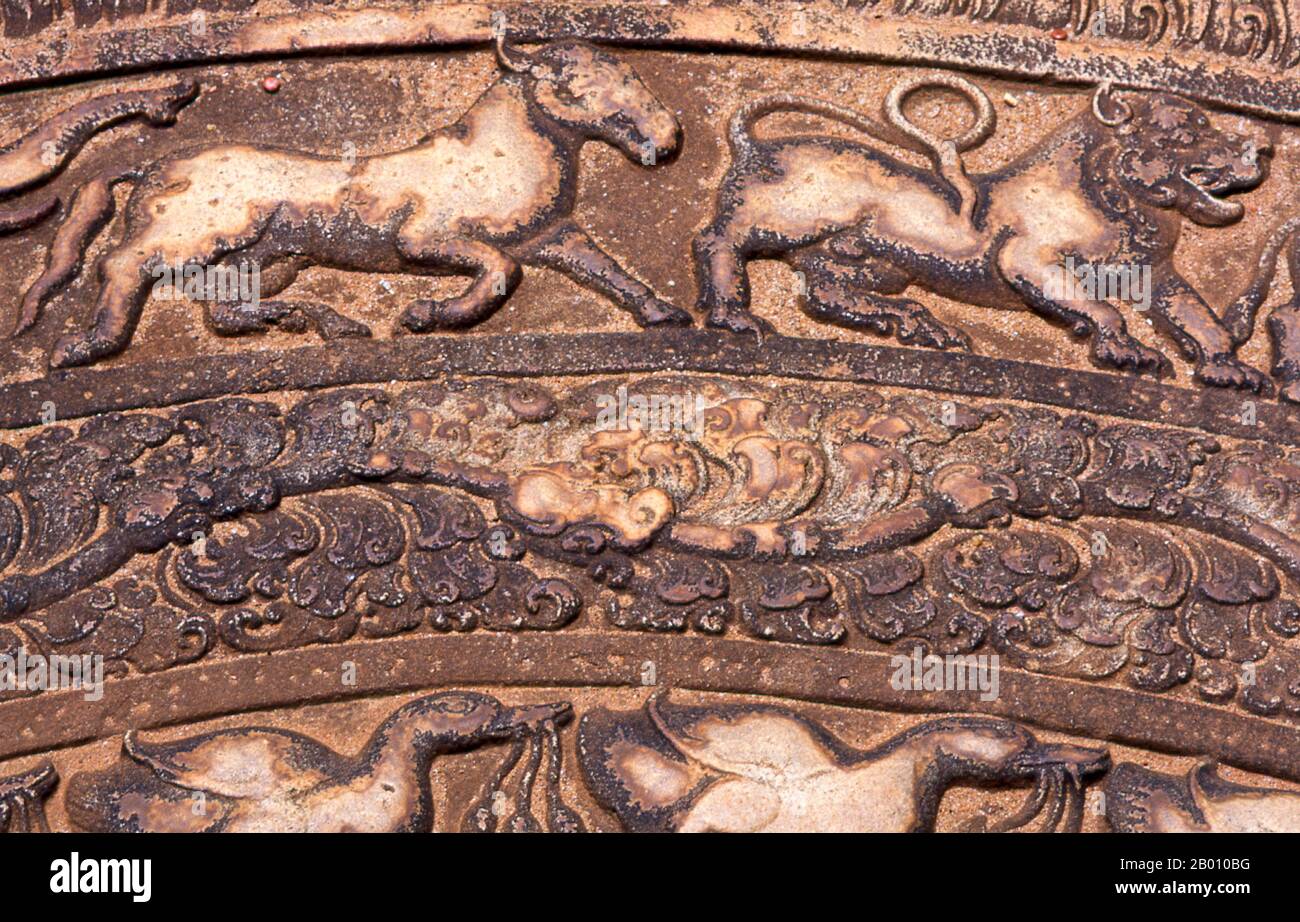 Sri Lanka: Guardian stone or moonstone (Sandakada Pahana) at Mahasen's Palace, Anuradhapura. Sandakada pahana is an elaborately carved semi-circular stone slab, usually placed at the bottom of staircases and entrances and is a unique feature of the Sinhalese architecture of ancient Sri Lanka. It symbolises the cycle of Saṃsāra in Buddhism. Anuradhapura is one of Sri Lanka's ancient capitals and famous for its well-preserved ruins. From the 4th century BCE until the beginning of the 11th century CE it was the capital. Stock Photohttps://www.alamy.com/image-license-details/?v=1https://www.alamy.com/sri-lanka-guardian-stone-or-moonstone-sandakada-pahana-at-mahasens-palace-anuradhapura-sandakada-pahana-is-an-elaborately-carved-semi-circular-stone-slab-usually-placed-at-the-bottom-of-staircases-and-entrances-and-is-a-unique-feature-of-the-sinhalese-architecture-of-ancient-sri-lanka-it-symbolises-the-cycle-of-sasra-in-buddhism-anuradhapura-is-one-of-sri-lankas-ancient-capitals-and-famous-for-its-well-preserved-ruins-from-the-4th-century-bce-until-the-beginning-of-the-11th-century-ce-it-was-the-capital-image344229636.html
Sri Lanka: Guardian stone or moonstone (Sandakada Pahana) at Mahasen's Palace, Anuradhapura. Sandakada pahana is an elaborately carved semi-circular stone slab, usually placed at the bottom of staircases and entrances and is a unique feature of the Sinhalese architecture of ancient Sri Lanka. It symbolises the cycle of Saṃsāra in Buddhism. Anuradhapura is one of Sri Lanka's ancient capitals and famous for its well-preserved ruins. From the 4th century BCE until the beginning of the 11th century CE it was the capital. Stock Photohttps://www.alamy.com/image-license-details/?v=1https://www.alamy.com/sri-lanka-guardian-stone-or-moonstone-sandakada-pahana-at-mahasens-palace-anuradhapura-sandakada-pahana-is-an-elaborately-carved-semi-circular-stone-slab-usually-placed-at-the-bottom-of-staircases-and-entrances-and-is-a-unique-feature-of-the-sinhalese-architecture-of-ancient-sri-lanka-it-symbolises-the-cycle-of-sasra-in-buddhism-anuradhapura-is-one-of-sri-lankas-ancient-capitals-and-famous-for-its-well-preserved-ruins-from-the-4th-century-bce-until-the-beginning-of-the-11th-century-ce-it-was-the-capital-image344229636.htmlRM2B010BG–Sri Lanka: Guardian stone or moonstone (Sandakada Pahana) at Mahasen's Palace, Anuradhapura. Sandakada pahana is an elaborately carved semi-circular stone slab, usually placed at the bottom of staircases and entrances and is a unique feature of the Sinhalese architecture of ancient Sri Lanka. It symbolises the cycle of Saṃsāra in Buddhism. Anuradhapura is one of Sri Lanka's ancient capitals and famous for its well-preserved ruins. From the 4th century BCE until the beginning of the 11th century CE it was the capital.
 Sri Lanka: Buddha statue at the cave temple at Isurumuniya Vihara, Anuradhapura. Isurumuniya Vihara is a rock temple built during the reign of King Devanampiya Tissa (r. 307 - 267 BCE). Anuradhapura is one of Sri Lanka's ancient capitals and famous for its well-preserved ruins. From the 4th century BCE until the beginning of the 11th century CE it was the capital. During this period it remained one of the most stable and durable centers of political power and urban life in South Asia. The ancient city, considered sacred to the Buddhist world, is today surrounded by monasteries. Stock Photohttps://www.alamy.com/image-license-details/?v=1https://www.alamy.com/sri-lanka-buddha-statue-at-the-cave-temple-at-isurumuniya-vihara-anuradhapura-isurumuniya-vihara-is-a-rock-temple-built-during-the-reign-of-king-devanampiya-tissa-r-307-267-bce-anuradhapura-is-one-of-sri-lankas-ancient-capitals-and-famous-for-its-well-preserved-ruins-from-the-4th-century-bce-until-the-beginning-of-the-11th-century-ce-it-was-the-capital-during-this-period-it-remained-one-of-the-most-stable-and-durable-centers-of-political-power-and-urban-life-in-south-asia-the-ancient-city-considered-sacred-to-the-buddhist-world-is-today-surrounded-by-monasteries-image344229646.html
Sri Lanka: Buddha statue at the cave temple at Isurumuniya Vihara, Anuradhapura. Isurumuniya Vihara is a rock temple built during the reign of King Devanampiya Tissa (r. 307 - 267 BCE). Anuradhapura is one of Sri Lanka's ancient capitals and famous for its well-preserved ruins. From the 4th century BCE until the beginning of the 11th century CE it was the capital. During this period it remained one of the most stable and durable centers of political power and urban life in South Asia. The ancient city, considered sacred to the Buddhist world, is today surrounded by monasteries. Stock Photohttps://www.alamy.com/image-license-details/?v=1https://www.alamy.com/sri-lanka-buddha-statue-at-the-cave-temple-at-isurumuniya-vihara-anuradhapura-isurumuniya-vihara-is-a-rock-temple-built-during-the-reign-of-king-devanampiya-tissa-r-307-267-bce-anuradhapura-is-one-of-sri-lankas-ancient-capitals-and-famous-for-its-well-preserved-ruins-from-the-4th-century-bce-until-the-beginning-of-the-11th-century-ce-it-was-the-capital-during-this-period-it-remained-one-of-the-most-stable-and-durable-centers-of-political-power-and-urban-life-in-south-asia-the-ancient-city-considered-sacred-to-the-buddhist-world-is-today-surrounded-by-monasteries-image344229646.htmlRM2B010BX–Sri Lanka: Buddha statue at the cave temple at Isurumuniya Vihara, Anuradhapura. Isurumuniya Vihara is a rock temple built during the reign of King Devanampiya Tissa (r. 307 - 267 BCE). Anuradhapura is one of Sri Lanka's ancient capitals and famous for its well-preserved ruins. From the 4th century BCE until the beginning of the 11th century CE it was the capital. During this period it remained one of the most stable and durable centers of political power and urban life in South Asia. The ancient city, considered sacred to the Buddhist world, is today surrounded by monasteries.
 Sri Lanka: Frieze of royal family, Isurumuniya temple museum, Anuradhapura. Isurumuniya Vihara is a rock temple built during the reign of King Devanampiya Tissa (r. 307 - 267 BCE). Anuradhapura is one of Sri Lanka's ancient capitals and famous for its well-preserved ruins. From the 4th century BCE until the beginning of the 11th century CE it was the capital. During this period it remained one of the most stable and durable centers of political power and urban life in South Asia. The ancient city, considered sacred to the Buddhist world, is today surrounded by monasteries. Stock Photohttps://www.alamy.com/image-license-details/?v=1https://www.alamy.com/sri-lanka-frieze-of-royal-family-isurumuniya-temple-museum-anuradhapura-isurumuniya-vihara-is-a-rock-temple-built-during-the-reign-of-king-devanampiya-tissa-r-307-267-bce-anuradhapura-is-one-of-sri-lankas-ancient-capitals-and-famous-for-its-well-preserved-ruins-from-the-4th-century-bce-until-the-beginning-of-the-11th-century-ce-it-was-the-capital-during-this-period-it-remained-one-of-the-most-stable-and-durable-centers-of-political-power-and-urban-life-in-south-asia-the-ancient-city-considered-sacred-to-the-buddhist-world-is-today-surrounded-by-monasteries-image344229607.html
Sri Lanka: Frieze of royal family, Isurumuniya temple museum, Anuradhapura. Isurumuniya Vihara is a rock temple built during the reign of King Devanampiya Tissa (r. 307 - 267 BCE). Anuradhapura is one of Sri Lanka's ancient capitals and famous for its well-preserved ruins. From the 4th century BCE until the beginning of the 11th century CE it was the capital. During this period it remained one of the most stable and durable centers of political power and urban life in South Asia. The ancient city, considered sacred to the Buddhist world, is today surrounded by monasteries. Stock Photohttps://www.alamy.com/image-license-details/?v=1https://www.alamy.com/sri-lanka-frieze-of-royal-family-isurumuniya-temple-museum-anuradhapura-isurumuniya-vihara-is-a-rock-temple-built-during-the-reign-of-king-devanampiya-tissa-r-307-267-bce-anuradhapura-is-one-of-sri-lankas-ancient-capitals-and-famous-for-its-well-preserved-ruins-from-the-4th-century-bce-until-the-beginning-of-the-11th-century-ce-it-was-the-capital-during-this-period-it-remained-one-of-the-most-stable-and-durable-centers-of-political-power-and-urban-life-in-south-asia-the-ancient-city-considered-sacred-to-the-buddhist-world-is-today-surrounded-by-monasteries-image344229607.htmlRM2B010AF–Sri Lanka: Frieze of royal family, Isurumuniya temple museum, Anuradhapura. Isurumuniya Vihara is a rock temple built during the reign of King Devanampiya Tissa (r. 307 - 267 BCE). Anuradhapura is one of Sri Lanka's ancient capitals and famous for its well-preserved ruins. From the 4th century BCE until the beginning of the 11th century CE it was the capital. During this period it remained one of the most stable and durable centers of political power and urban life in South Asia. The ancient city, considered sacred to the Buddhist world, is today surrounded by monasteries.
 Sri Lanka: Frieze of musicians, Isurumuniya temple museum, Anuradhapura. Isurumuniya Vihara is a rock temple built during the reign of King Devanampiya Tissa (r. 307 - 267 BCE). Anuradhapura is one of Sri Lanka's ancient capitals and famous for its well-preserved ruins. From the 4th century BCE until the beginning of the 11th century CE it was the capital. During this period it remained one of the most stable and durable centers of political power and urban life in South Asia. The ancient city, considered sacred to the Buddhist world, is today surrounded by monasteries. Stock Photohttps://www.alamy.com/image-license-details/?v=1https://www.alamy.com/sri-lanka-frieze-of-musicians-isurumuniya-temple-museum-anuradhapura-isurumuniya-vihara-is-a-rock-temple-built-during-the-reign-of-king-devanampiya-tissa-r-307-267-bce-anuradhapura-is-one-of-sri-lankas-ancient-capitals-and-famous-for-its-well-preserved-ruins-from-the-4th-century-bce-until-the-beginning-of-the-11th-century-ce-it-was-the-capital-during-this-period-it-remained-one-of-the-most-stable-and-durable-centers-of-political-power-and-urban-life-in-south-asia-the-ancient-city-considered-sacred-to-the-buddhist-world-is-today-surrounded-by-monasteries-image344229608.html
Sri Lanka: Frieze of musicians, Isurumuniya temple museum, Anuradhapura. Isurumuniya Vihara is a rock temple built during the reign of King Devanampiya Tissa (r. 307 - 267 BCE). Anuradhapura is one of Sri Lanka's ancient capitals and famous for its well-preserved ruins. From the 4th century BCE until the beginning of the 11th century CE it was the capital. During this period it remained one of the most stable and durable centers of political power and urban life in South Asia. The ancient city, considered sacred to the Buddhist world, is today surrounded by monasteries. Stock Photohttps://www.alamy.com/image-license-details/?v=1https://www.alamy.com/sri-lanka-frieze-of-musicians-isurumuniya-temple-museum-anuradhapura-isurumuniya-vihara-is-a-rock-temple-built-during-the-reign-of-king-devanampiya-tissa-r-307-267-bce-anuradhapura-is-one-of-sri-lankas-ancient-capitals-and-famous-for-its-well-preserved-ruins-from-the-4th-century-bce-until-the-beginning-of-the-11th-century-ce-it-was-the-capital-during-this-period-it-remained-one-of-the-most-stable-and-durable-centers-of-political-power-and-urban-life-in-south-asia-the-ancient-city-considered-sacred-to-the-buddhist-world-is-today-surrounded-by-monasteries-image344229608.htmlRM2B010AG–Sri Lanka: Frieze of musicians, Isurumuniya temple museum, Anuradhapura. Isurumuniya Vihara is a rock temple built during the reign of King Devanampiya Tissa (r. 307 - 267 BCE). Anuradhapura is one of Sri Lanka's ancient capitals and famous for its well-preserved ruins. From the 4th century BCE until the beginning of the 11th century CE it was the capital. During this period it remained one of the most stable and durable centers of political power and urban life in South Asia. The ancient city, considered sacred to the Buddhist world, is today surrounded by monasteries.
 Sri Lanka: Wall painting, Isurumuniya Vihara, Anuradhapura. Isurumuniya Vihara is a rock temple built during the reign of King Devanampiya Tissa (r. 307 - 267 BCE). Anuradhapura is one of Sri Lanka's ancient capitals and famous for its well-preserved ruins. From the 4th century BCE until the beginning of the 11th century CE it was the capital. During this period it remained one of the most stable and durable centers of political power and urban life in South Asia. The ancient city, considered sacred to the Buddhist world, is today surrounded by monasteries. Stock Photohttps://www.alamy.com/image-license-details/?v=1https://www.alamy.com/sri-lanka-wall-painting-isurumuniya-vihara-anuradhapura-isurumuniya-vihara-is-a-rock-temple-built-during-the-reign-of-king-devanampiya-tissa-r-307-267-bce-anuradhapura-is-one-of-sri-lankas-ancient-capitals-and-famous-for-its-well-preserved-ruins-from-the-4th-century-bce-until-the-beginning-of-the-11th-century-ce-it-was-the-capital-during-this-period-it-remained-one-of-the-most-stable-and-durable-centers-of-political-power-and-urban-life-in-south-asia-the-ancient-city-considered-sacred-to-the-buddhist-world-is-today-surrounded-by-monasteries-image344229643.html
Sri Lanka: Wall painting, Isurumuniya Vihara, Anuradhapura. Isurumuniya Vihara is a rock temple built during the reign of King Devanampiya Tissa (r. 307 - 267 BCE). Anuradhapura is one of Sri Lanka's ancient capitals and famous for its well-preserved ruins. From the 4th century BCE until the beginning of the 11th century CE it was the capital. During this period it remained one of the most stable and durable centers of political power and urban life in South Asia. The ancient city, considered sacred to the Buddhist world, is today surrounded by monasteries. Stock Photohttps://www.alamy.com/image-license-details/?v=1https://www.alamy.com/sri-lanka-wall-painting-isurumuniya-vihara-anuradhapura-isurumuniya-vihara-is-a-rock-temple-built-during-the-reign-of-king-devanampiya-tissa-r-307-267-bce-anuradhapura-is-one-of-sri-lankas-ancient-capitals-and-famous-for-its-well-preserved-ruins-from-the-4th-century-bce-until-the-beginning-of-the-11th-century-ce-it-was-the-capital-during-this-period-it-remained-one-of-the-most-stable-and-durable-centers-of-political-power-and-urban-life-in-south-asia-the-ancient-city-considered-sacred-to-the-buddhist-world-is-today-surrounded-by-monasteries-image344229643.htmlRM2B010BR–Sri Lanka: Wall painting, Isurumuniya Vihara, Anuradhapura. Isurumuniya Vihara is a rock temple built during the reign of King Devanampiya Tissa (r. 307 - 267 BCE). Anuradhapura is one of Sri Lanka's ancient capitals and famous for its well-preserved ruins. From the 4th century BCE until the beginning of the 11th century CE it was the capital. During this period it remained one of the most stable and durable centers of political power and urban life in South Asia. The ancient city, considered sacred to the Buddhist world, is today surrounded by monasteries.
 Sri Lanka: Wall painting, Isurumuniya Vihara, Anuradhapura. Isurumuniya Vihara is a rock temple built during the reign of King Devanampiya Tissa (r. 307 - 267 BCE). Anuradhapura is one of Sri Lanka's ancient capitals and famous for its well-preserved ruins. From the 4th century BCE until the beginning of the 11th century CE it was the capital. During this period it remained one of the most stable and durable centers of political power and urban life in South Asia. The ancient city, considered sacred to the Buddhist world, is today surrounded by monasteries. Stock Photohttps://www.alamy.com/image-license-details/?v=1https://www.alamy.com/sri-lanka-wall-painting-isurumuniya-vihara-anuradhapura-isurumuniya-vihara-is-a-rock-temple-built-during-the-reign-of-king-devanampiya-tissa-r-307-267-bce-anuradhapura-is-one-of-sri-lankas-ancient-capitals-and-famous-for-its-well-preserved-ruins-from-the-4th-century-bce-until-the-beginning-of-the-11th-century-ce-it-was-the-capital-during-this-period-it-remained-one-of-the-most-stable-and-durable-centers-of-political-power-and-urban-life-in-south-asia-the-ancient-city-considered-sacred-to-the-buddhist-world-is-today-surrounded-by-monasteries-image344229640.html
Sri Lanka: Wall painting, Isurumuniya Vihara, Anuradhapura. Isurumuniya Vihara is a rock temple built during the reign of King Devanampiya Tissa (r. 307 - 267 BCE). Anuradhapura is one of Sri Lanka's ancient capitals and famous for its well-preserved ruins. From the 4th century BCE until the beginning of the 11th century CE it was the capital. During this period it remained one of the most stable and durable centers of political power and urban life in South Asia. The ancient city, considered sacred to the Buddhist world, is today surrounded by monasteries. Stock Photohttps://www.alamy.com/image-license-details/?v=1https://www.alamy.com/sri-lanka-wall-painting-isurumuniya-vihara-anuradhapura-isurumuniya-vihara-is-a-rock-temple-built-during-the-reign-of-king-devanampiya-tissa-r-307-267-bce-anuradhapura-is-one-of-sri-lankas-ancient-capitals-and-famous-for-its-well-preserved-ruins-from-the-4th-century-bce-until-the-beginning-of-the-11th-century-ce-it-was-the-capital-during-this-period-it-remained-one-of-the-most-stable-and-durable-centers-of-political-power-and-urban-life-in-south-asia-the-ancient-city-considered-sacred-to-the-buddhist-world-is-today-surrounded-by-monasteries-image344229640.htmlRM2B010BM–Sri Lanka: Wall painting, Isurumuniya Vihara, Anuradhapura. Isurumuniya Vihara is a rock temple built during the reign of King Devanampiya Tissa (r. 307 - 267 BCE). Anuradhapura is one of Sri Lanka's ancient capitals and famous for its well-preserved ruins. From the 4th century BCE until the beginning of the 11th century CE it was the capital. During this period it remained one of the most stable and durable centers of political power and urban life in South Asia. The ancient city, considered sacred to the Buddhist world, is today surrounded by monasteries.
 Sri Lanka: Wall painting, Isurumuniya Vihara, Anuradhapura. Isurumuniya Vihara is a rock temple built during the reign of King Devanampiya Tissa (r. 307 - 267 BCE). Anuradhapura is one of Sri Lanka's ancient capitals and famous for its well-preserved ruins. From the 4th century BCE until the beginning of the 11th century CE it was the capital. During this period it remained one of the most stable and durable centers of political power and urban life in South Asia. The ancient city, considered sacred to the Buddhist world, is today surrounded by monasteries. Stock Photohttps://www.alamy.com/image-license-details/?v=1https://www.alamy.com/sri-lanka-wall-painting-isurumuniya-vihara-anuradhapura-isurumuniya-vihara-is-a-rock-temple-built-during-the-reign-of-king-devanampiya-tissa-r-307-267-bce-anuradhapura-is-one-of-sri-lankas-ancient-capitals-and-famous-for-its-well-preserved-ruins-from-the-4th-century-bce-until-the-beginning-of-the-11th-century-ce-it-was-the-capital-during-this-period-it-remained-one-of-the-most-stable-and-durable-centers-of-political-power-and-urban-life-in-south-asia-the-ancient-city-considered-sacred-to-the-buddhist-world-is-today-surrounded-by-monasteries-image344229641.html
Sri Lanka: Wall painting, Isurumuniya Vihara, Anuradhapura. Isurumuniya Vihara is a rock temple built during the reign of King Devanampiya Tissa (r. 307 - 267 BCE). Anuradhapura is one of Sri Lanka's ancient capitals and famous for its well-preserved ruins. From the 4th century BCE until the beginning of the 11th century CE it was the capital. During this period it remained one of the most stable and durable centers of political power and urban life in South Asia. The ancient city, considered sacred to the Buddhist world, is today surrounded by monasteries. Stock Photohttps://www.alamy.com/image-license-details/?v=1https://www.alamy.com/sri-lanka-wall-painting-isurumuniya-vihara-anuradhapura-isurumuniya-vihara-is-a-rock-temple-built-during-the-reign-of-king-devanampiya-tissa-r-307-267-bce-anuradhapura-is-one-of-sri-lankas-ancient-capitals-and-famous-for-its-well-preserved-ruins-from-the-4th-century-bce-until-the-beginning-of-the-11th-century-ce-it-was-the-capital-during-this-period-it-remained-one-of-the-most-stable-and-durable-centers-of-political-power-and-urban-life-in-south-asia-the-ancient-city-considered-sacred-to-the-buddhist-world-is-today-surrounded-by-monasteries-image344229641.htmlRM2B010BN–Sri Lanka: Wall painting, Isurumuniya Vihara, Anuradhapura. Isurumuniya Vihara is a rock temple built during the reign of King Devanampiya Tissa (r. 307 - 267 BCE). Anuradhapura is one of Sri Lanka's ancient capitals and famous for its well-preserved ruins. From the 4th century BCE until the beginning of the 11th century CE it was the capital. During this period it remained one of the most stable and durable centers of political power and urban life in South Asia. The ancient city, considered sacred to the Buddhist world, is today surrounded by monasteries.
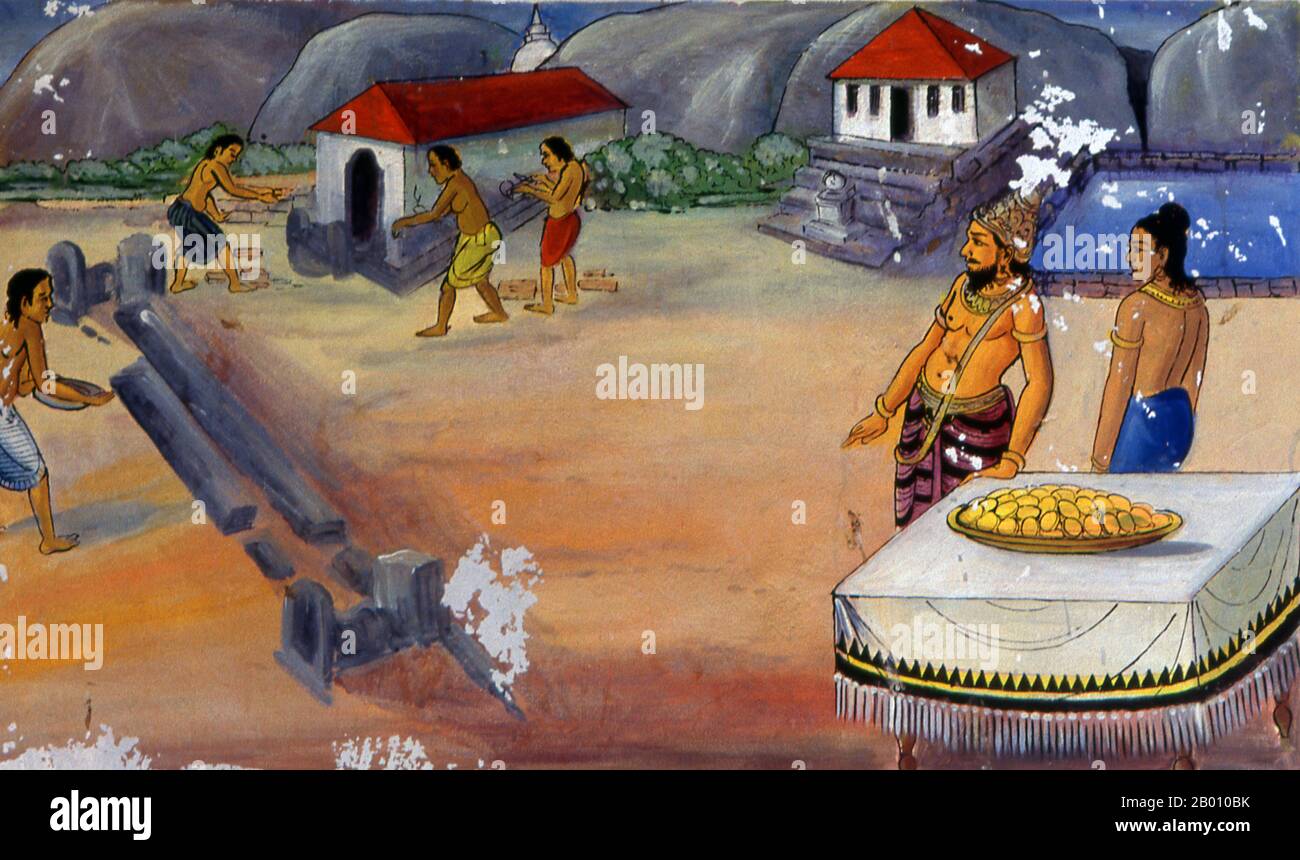 Sri Lanka: Wall painting, Isurumuniya Vihara, Anuradhapura. Isurumuniya Vihara is a rock temple built during the reign of King Devanampiya Tissa (r. 307 - 267 BCE). Anuradhapura is one of Sri Lanka's ancient capitals and famous for its well-preserved ruins. From the 4th century BCE until the beginning of the 11th century CE it was the capital. During this period it remained one of the most stable and durable centers of political power and urban life in South Asia. The ancient city, considered sacred to the Buddhist world, is today surrounded by monasteries. Stock Photohttps://www.alamy.com/image-license-details/?v=1https://www.alamy.com/sri-lanka-wall-painting-isurumuniya-vihara-anuradhapura-isurumuniya-vihara-is-a-rock-temple-built-during-the-reign-of-king-devanampiya-tissa-r-307-267-bce-anuradhapura-is-one-of-sri-lankas-ancient-capitals-and-famous-for-its-well-preserved-ruins-from-the-4th-century-bce-until-the-beginning-of-the-11th-century-ce-it-was-the-capital-during-this-period-it-remained-one-of-the-most-stable-and-durable-centers-of-political-power-and-urban-life-in-south-asia-the-ancient-city-considered-sacred-to-the-buddhist-world-is-today-surrounded-by-monasteries-image344229639.html
Sri Lanka: Wall painting, Isurumuniya Vihara, Anuradhapura. Isurumuniya Vihara is a rock temple built during the reign of King Devanampiya Tissa (r. 307 - 267 BCE). Anuradhapura is one of Sri Lanka's ancient capitals and famous for its well-preserved ruins. From the 4th century BCE until the beginning of the 11th century CE it was the capital. During this period it remained one of the most stable and durable centers of political power and urban life in South Asia. The ancient city, considered sacred to the Buddhist world, is today surrounded by monasteries. Stock Photohttps://www.alamy.com/image-license-details/?v=1https://www.alamy.com/sri-lanka-wall-painting-isurumuniya-vihara-anuradhapura-isurumuniya-vihara-is-a-rock-temple-built-during-the-reign-of-king-devanampiya-tissa-r-307-267-bce-anuradhapura-is-one-of-sri-lankas-ancient-capitals-and-famous-for-its-well-preserved-ruins-from-the-4th-century-bce-until-the-beginning-of-the-11th-century-ce-it-was-the-capital-during-this-period-it-remained-one-of-the-most-stable-and-durable-centers-of-political-power-and-urban-life-in-south-asia-the-ancient-city-considered-sacred-to-the-buddhist-world-is-today-surrounded-by-monasteries-image344229639.htmlRM2B010BK–Sri Lanka: Wall painting, Isurumuniya Vihara, Anuradhapura. Isurumuniya Vihara is a rock temple built during the reign of King Devanampiya Tissa (r. 307 - 267 BCE). Anuradhapura is one of Sri Lanka's ancient capitals and famous for its well-preserved ruins. From the 4th century BCE until the beginning of the 11th century CE it was the capital. During this period it remained one of the most stable and durable centers of political power and urban life in South Asia. The ancient city, considered sacred to the Buddhist world, is today surrounded by monasteries.
 Sri Lanka: Monk statues in the cave temple at Isurumuniya Vihara, Anuradhapura. Isurumuniya Vihara is a rock temple built during the reign of King Devanampiya Tissa (r. 307 - 267 BCE). Anuradhapura is one of Sri Lanka's ancient capitals and famous for its well-preserved ruins. From the 4th century BCE until the beginning of the 11th century CE it was the capital. During this period it remained one of the most stable and durable centers of political power and urban life in South Asia. The ancient city, considered sacred to the Buddhist world, is today surrounded by monasteries, Stock Photohttps://www.alamy.com/image-license-details/?v=1https://www.alamy.com/sri-lanka-monk-statues-in-the-cave-temple-at-isurumuniya-vihara-anuradhapura-isurumuniya-vihara-is-a-rock-temple-built-during-the-reign-of-king-devanampiya-tissa-r-307-267-bce-anuradhapura-is-one-of-sri-lankas-ancient-capitals-and-famous-for-its-well-preserved-ruins-from-the-4th-century-bce-until-the-beginning-of-the-11th-century-ce-it-was-the-capital-during-this-period-it-remained-one-of-the-most-stable-and-durable-centers-of-political-power-and-urban-life-in-south-asia-the-ancient-city-considered-sacred-to-the-buddhist-world-is-today-surrounded-by-monasteries-image344229645.html
Sri Lanka: Monk statues in the cave temple at Isurumuniya Vihara, Anuradhapura. Isurumuniya Vihara is a rock temple built during the reign of King Devanampiya Tissa (r. 307 - 267 BCE). Anuradhapura is one of Sri Lanka's ancient capitals and famous for its well-preserved ruins. From the 4th century BCE until the beginning of the 11th century CE it was the capital. During this period it remained one of the most stable and durable centers of political power and urban life in South Asia. The ancient city, considered sacred to the Buddhist world, is today surrounded by monasteries, Stock Photohttps://www.alamy.com/image-license-details/?v=1https://www.alamy.com/sri-lanka-monk-statues-in-the-cave-temple-at-isurumuniya-vihara-anuradhapura-isurumuniya-vihara-is-a-rock-temple-built-during-the-reign-of-king-devanampiya-tissa-r-307-267-bce-anuradhapura-is-one-of-sri-lankas-ancient-capitals-and-famous-for-its-well-preserved-ruins-from-the-4th-century-bce-until-the-beginning-of-the-11th-century-ce-it-was-the-capital-during-this-period-it-remained-one-of-the-most-stable-and-durable-centers-of-political-power-and-urban-life-in-south-asia-the-ancient-city-considered-sacred-to-the-buddhist-world-is-today-surrounded-by-monasteries-image344229645.htmlRM2B010BW–Sri Lanka: Monk statues in the cave temple at Isurumuniya Vihara, Anuradhapura. Isurumuniya Vihara is a rock temple built during the reign of King Devanampiya Tissa (r. 307 - 267 BCE). Anuradhapura is one of Sri Lanka's ancient capitals and famous for its well-preserved ruins. From the 4th century BCE until the beginning of the 11th century CE it was the capital. During this period it remained one of the most stable and durable centers of political power and urban life in South Asia. The ancient city, considered sacred to the Buddhist world, is today surrounded by monasteries,
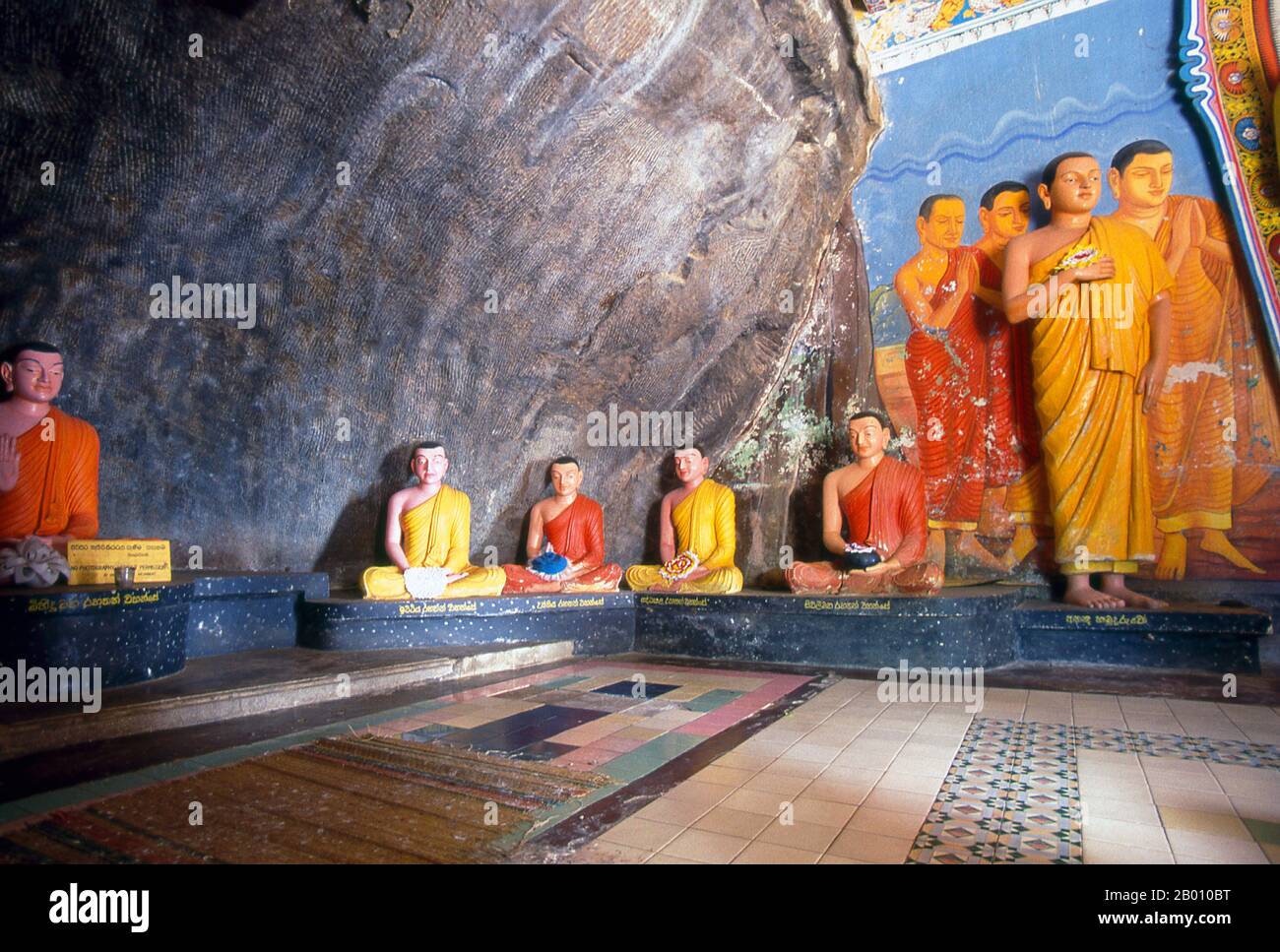 Sri Lanka: Monk statues in the cave temple at Isurumuniya Vihara, Anuradhapura. Isurumuniya Vihara is a rock temple built during the reign of King Devanampiya Tissa (r. 307 - 267 BCE). Anuradhapura is one of Sri Lanka's ancient capitals and famous for its well-preserved ruins. From the 4th century BCE until the beginning of the 11th century CE it was the capital. During this period it remained one of the most stable and durable centers of political power and urban life in South Asia. The ancient city, considered sacred to the Buddhist world, is today surrounded by monasteries, Stock Photohttps://www.alamy.com/image-license-details/?v=1https://www.alamy.com/sri-lanka-monk-statues-in-the-cave-temple-at-isurumuniya-vihara-anuradhapura-isurumuniya-vihara-is-a-rock-temple-built-during-the-reign-of-king-devanampiya-tissa-r-307-267-bce-anuradhapura-is-one-of-sri-lankas-ancient-capitals-and-famous-for-its-well-preserved-ruins-from-the-4th-century-bce-until-the-beginning-of-the-11th-century-ce-it-was-the-capital-during-this-period-it-remained-one-of-the-most-stable-and-durable-centers-of-political-power-and-urban-life-in-south-asia-the-ancient-city-considered-sacred-to-the-buddhist-world-is-today-surrounded-by-monasteries-image344229644.html
Sri Lanka: Monk statues in the cave temple at Isurumuniya Vihara, Anuradhapura. Isurumuniya Vihara is a rock temple built during the reign of King Devanampiya Tissa (r. 307 - 267 BCE). Anuradhapura is one of Sri Lanka's ancient capitals and famous for its well-preserved ruins. From the 4th century BCE until the beginning of the 11th century CE it was the capital. During this period it remained one of the most stable and durable centers of political power and urban life in South Asia. The ancient city, considered sacred to the Buddhist world, is today surrounded by monasteries, Stock Photohttps://www.alamy.com/image-license-details/?v=1https://www.alamy.com/sri-lanka-monk-statues-in-the-cave-temple-at-isurumuniya-vihara-anuradhapura-isurumuniya-vihara-is-a-rock-temple-built-during-the-reign-of-king-devanampiya-tissa-r-307-267-bce-anuradhapura-is-one-of-sri-lankas-ancient-capitals-and-famous-for-its-well-preserved-ruins-from-the-4th-century-bce-until-the-beginning-of-the-11th-century-ce-it-was-the-capital-during-this-period-it-remained-one-of-the-most-stable-and-durable-centers-of-political-power-and-urban-life-in-south-asia-the-ancient-city-considered-sacred-to-the-buddhist-world-is-today-surrounded-by-monasteries-image344229644.htmlRM2B010BT–Sri Lanka: Monk statues in the cave temple at Isurumuniya Vihara, Anuradhapura. Isurumuniya Vihara is a rock temple built during the reign of King Devanampiya Tissa (r. 307 - 267 BCE). Anuradhapura is one of Sri Lanka's ancient capitals and famous for its well-preserved ruins. From the 4th century BCE until the beginning of the 11th century CE it was the capital. During this period it remained one of the most stable and durable centers of political power and urban life in South Asia. The ancient city, considered sacred to the Buddhist world, is today surrounded by monasteries,
 Sri Lanka: Monk statues in the cave temple at Isurumuniya Vihara, Anuradhapura. Isurumuniya Vihara is a rock temple built during the reign of King Devanampiya Tissa (r. 307 - 267 BCE). Anuradhapura is one of Sri Lanka's ancient capitals and famous for its well-preserved ruins. From the 4th century BCE until the beginning of the 11th century CE it was the capital. During this period it remained one of the most stable and durable centers of political power and urban life in South Asia. The ancient city, considered sacred to the Buddhist world, is today surrounded by monasteries, Stock Photohttps://www.alamy.com/image-license-details/?v=1https://www.alamy.com/sri-lanka-monk-statues-in-the-cave-temple-at-isurumuniya-vihara-anuradhapura-isurumuniya-vihara-is-a-rock-temple-built-during-the-reign-of-king-devanampiya-tissa-r-307-267-bce-anuradhapura-is-one-of-sri-lankas-ancient-capitals-and-famous-for-its-well-preserved-ruins-from-the-4th-century-bce-until-the-beginning-of-the-11th-century-ce-it-was-the-capital-during-this-period-it-remained-one-of-the-most-stable-and-durable-centers-of-political-power-and-urban-life-in-south-asia-the-ancient-city-considered-sacred-to-the-buddhist-world-is-today-surrounded-by-monasteries-image344229642.html
Sri Lanka: Monk statues in the cave temple at Isurumuniya Vihara, Anuradhapura. Isurumuniya Vihara is a rock temple built during the reign of King Devanampiya Tissa (r. 307 - 267 BCE). Anuradhapura is one of Sri Lanka's ancient capitals and famous for its well-preserved ruins. From the 4th century BCE until the beginning of the 11th century CE it was the capital. During this period it remained one of the most stable and durable centers of political power and urban life in South Asia. The ancient city, considered sacred to the Buddhist world, is today surrounded by monasteries, Stock Photohttps://www.alamy.com/image-license-details/?v=1https://www.alamy.com/sri-lanka-monk-statues-in-the-cave-temple-at-isurumuniya-vihara-anuradhapura-isurumuniya-vihara-is-a-rock-temple-built-during-the-reign-of-king-devanampiya-tissa-r-307-267-bce-anuradhapura-is-one-of-sri-lankas-ancient-capitals-and-famous-for-its-well-preserved-ruins-from-the-4th-century-bce-until-the-beginning-of-the-11th-century-ce-it-was-the-capital-during-this-period-it-remained-one-of-the-most-stable-and-durable-centers-of-political-power-and-urban-life-in-south-asia-the-ancient-city-considered-sacred-to-the-buddhist-world-is-today-surrounded-by-monasteries-image344229642.htmlRM2B010BP–Sri Lanka: Monk statues in the cave temple at Isurumuniya Vihara, Anuradhapura. Isurumuniya Vihara is a rock temple built during the reign of King Devanampiya Tissa (r. 307 - 267 BCE). Anuradhapura is one of Sri Lanka's ancient capitals and famous for its well-preserved ruins. From the 4th century BCE until the beginning of the 11th century CE it was the capital. During this period it remained one of the most stable and durable centers of political power and urban life in South Asia. The ancient city, considered sacred to the Buddhist world, is today surrounded by monasteries,
 Vagator Beach is the northernmost beach of Bardez Taluka, Goa. It is located on the opposite bank of the Chapora River from Morjim in Pernem. To the south of Vagator is Anjuna, one of the first hippie haunts of Goa. Stock Photohttps://www.alamy.com/image-license-details/?v=1https://www.alamy.com/vagator-beach-is-the-northernmost-beach-of-bardez-taluka-goa-it-is-located-on-the-opposite-bank-of-the-chapora-river-from-morjim-in-pernem-to-the-south-of-vagator-is-anjuna-one-of-the-first-hippie-haunts-of-goa-image344278868.html
Vagator Beach is the northernmost beach of Bardez Taluka, Goa. It is located on the opposite bank of the Chapora River from Morjim in Pernem. To the south of Vagator is Anjuna, one of the first hippie haunts of Goa. Stock Photohttps://www.alamy.com/image-license-details/?v=1https://www.alamy.com/vagator-beach-is-the-northernmost-beach-of-bardez-taluka-goa-it-is-located-on-the-opposite-bank-of-the-chapora-river-from-morjim-in-pernem-to-the-south-of-vagator-is-anjuna-one-of-the-first-hippie-haunts-of-goa-image344278868.htmlRM2B0375T–Vagator Beach is the northernmost beach of Bardez Taluka, Goa. It is located on the opposite bank of the Chapora River from Morjim in Pernem. To the south of Vagator is Anjuna, one of the first hippie haunts of Goa.
 Vagator Beach is the northernmost beach of Bardez Taluka, Goa. It is located on the opposite bank of the Chapora River from Morjim in Pernem. To the south of Vagator is Anjuna, one of the first hippie haunts of Goa. Stock Photohttps://www.alamy.com/image-license-details/?v=1https://www.alamy.com/vagator-beach-is-the-northernmost-beach-of-bardez-taluka-goa-it-is-located-on-the-opposite-bank-of-the-chapora-river-from-morjim-in-pernem-to-the-south-of-vagator-is-anjuna-one-of-the-first-hippie-haunts-of-goa-image344278858.html
Vagator Beach is the northernmost beach of Bardez Taluka, Goa. It is located on the opposite bank of the Chapora River from Morjim in Pernem. To the south of Vagator is Anjuna, one of the first hippie haunts of Goa. Stock Photohttps://www.alamy.com/image-license-details/?v=1https://www.alamy.com/vagator-beach-is-the-northernmost-beach-of-bardez-taluka-goa-it-is-located-on-the-opposite-bank-of-the-chapora-river-from-morjim-in-pernem-to-the-south-of-vagator-is-anjuna-one-of-the-first-hippie-haunts-of-goa-image344278858.htmlRM2B0375E–Vagator Beach is the northernmost beach of Bardez Taluka, Goa. It is located on the opposite bank of the Chapora River from Morjim in Pernem. To the south of Vagator is Anjuna, one of the first hippie haunts of Goa.
 The Vashishti River is one of the larger rivers on the Konkan coast of Maharashtra State. The town of Chiplun lies on its banks. The river begins in the Western Ghats and snakes its way westwards towards the Arabian Sea. Kolkewadi Dam, near Alore has a vast reservoir which feeds a tributary of the river. The river has many riverine islands. Crocodiles are known to inhabit the waters. Stock Photohttps://www.alamy.com/image-license-details/?v=1https://www.alamy.com/the-vashishti-river-is-one-of-the-larger-rivers-on-the-konkan-coast-of-maharashtra-state-the-town-of-chiplun-lies-on-its-banks-the-river-begins-in-the-western-ghats-and-snakes-its-way-westwards-towards-the-arabian-sea-kolkewadi-dam-near-alore-has-a-vast-reservoir-which-feeds-a-tributary-of-the-river-the-river-has-many-riverine-islands-crocodiles-are-known-to-inhabit-the-waters-image344278885.html
The Vashishti River is one of the larger rivers on the Konkan coast of Maharashtra State. The town of Chiplun lies on its banks. The river begins in the Western Ghats and snakes its way westwards towards the Arabian Sea. Kolkewadi Dam, near Alore has a vast reservoir which feeds a tributary of the river. The river has many riverine islands. Crocodiles are known to inhabit the waters. Stock Photohttps://www.alamy.com/image-license-details/?v=1https://www.alamy.com/the-vashishti-river-is-one-of-the-larger-rivers-on-the-konkan-coast-of-maharashtra-state-the-town-of-chiplun-lies-on-its-banks-the-river-begins-in-the-western-ghats-and-snakes-its-way-westwards-towards-the-arabian-sea-kolkewadi-dam-near-alore-has-a-vast-reservoir-which-feeds-a-tributary-of-the-river-the-river-has-many-riverine-islands-crocodiles-are-known-to-inhabit-the-waters-image344278885.htmlRM2B0376D–The Vashishti River is one of the larger rivers on the Konkan coast of Maharashtra State. The town of Chiplun lies on its banks. The river begins in the Western Ghats and snakes its way westwards towards the Arabian Sea. Kolkewadi Dam, near Alore has a vast reservoir which feeds a tributary of the river. The river has many riverine islands. Crocodiles are known to inhabit the waters.
 Vagator Beach is the northernmost beach of Bardez Taluka, Goa. It is located on the opposite bank of the Chapora River from Morjim in Pernem. To the south of Vagator is Anjuna, one of the first hippie haunts of Goa. Stock Photohttps://www.alamy.com/image-license-details/?v=1https://www.alamy.com/vagator-beach-is-the-northernmost-beach-of-bardez-taluka-goa-it-is-located-on-the-opposite-bank-of-the-chapora-river-from-morjim-in-pernem-to-the-south-of-vagator-is-anjuna-one-of-the-first-hippie-haunts-of-goa-image344278872.html
Vagator Beach is the northernmost beach of Bardez Taluka, Goa. It is located on the opposite bank of the Chapora River from Morjim in Pernem. To the south of Vagator is Anjuna, one of the first hippie haunts of Goa. Stock Photohttps://www.alamy.com/image-license-details/?v=1https://www.alamy.com/vagator-beach-is-the-northernmost-beach-of-bardez-taluka-goa-it-is-located-on-the-opposite-bank-of-the-chapora-river-from-morjim-in-pernem-to-the-south-of-vagator-is-anjuna-one-of-the-first-hippie-haunts-of-goa-image344278872.htmlRM2B03760–Vagator Beach is the northernmost beach of Bardez Taluka, Goa. It is located on the opposite bank of the Chapora River from Morjim in Pernem. To the south of Vagator is Anjuna, one of the first hippie haunts of Goa.
 Kutch (often spelled Kachch) is the northwestern part of the Indian state of Gujarat, divided from the main part of the state by the Arabian Sea and a stretch of salt marshes. To its north lies the Pakistani province of Sind. The name Kutch is said to be derived from the Kachelas, a sub-caste of the lohar (blacksmiths’) or soni (goldsmiths’) castes. Stock Photohttps://www.alamy.com/image-license-details/?v=1https://www.alamy.com/kutch-often-spelled-kachch-is-the-northwestern-part-of-the-indian-state-of-gujarat-divided-from-the-main-part-of-the-state-by-the-arabian-sea-and-a-stretch-of-salt-marshes-to-its-north-lies-the-pakistani-province-of-sind-the-name-kutch-is-said-to-be-derived-from-the-kachelas-a-sub-caste-of-the-lohar-blacksmiths-or-soni-goldsmiths-castes-image344281301.html
Kutch (often spelled Kachch) is the northwestern part of the Indian state of Gujarat, divided from the main part of the state by the Arabian Sea and a stretch of salt marshes. To its north lies the Pakistani province of Sind. The name Kutch is said to be derived from the Kachelas, a sub-caste of the lohar (blacksmiths’) or soni (goldsmiths’) castes. Stock Photohttps://www.alamy.com/image-license-details/?v=1https://www.alamy.com/kutch-often-spelled-kachch-is-the-northwestern-part-of-the-indian-state-of-gujarat-divided-from-the-main-part-of-the-state-by-the-arabian-sea-and-a-stretch-of-salt-marshes-to-its-north-lies-the-pakistani-province-of-sind-the-name-kutch-is-said-to-be-derived-from-the-kachelas-a-sub-caste-of-the-lohar-blacksmiths-or-soni-goldsmiths-castes-image344281301.htmlRM2B03A8N–Kutch (often spelled Kachch) is the northwestern part of the Indian state of Gujarat, divided from the main part of the state by the Arabian Sea and a stretch of salt marshes. To its north lies the Pakistani province of Sind. The name Kutch is said to be derived from the Kachelas, a sub-caste of the lohar (blacksmiths’) or soni (goldsmiths’) castes.
 Kutch (often spelled Kachch) is the northwestern part of the Indian state of Gujarat, divided from the main part of the state by the Arabian Sea and a stretch of salt marshes. To its north lies the Pakistani province of Sind. The name Kutch is said to be derived from the Kachelas, a sub-caste of the lohar (blacksmiths’) or soni (goldsmiths’) castes. Stock Photohttps://www.alamy.com/image-license-details/?v=1https://www.alamy.com/kutch-often-spelled-kachch-is-the-northwestern-part-of-the-indian-state-of-gujarat-divided-from-the-main-part-of-the-state-by-the-arabian-sea-and-a-stretch-of-salt-marshes-to-its-north-lies-the-pakistani-province-of-sind-the-name-kutch-is-said-to-be-derived-from-the-kachelas-a-sub-caste-of-the-lohar-blacksmiths-or-soni-goldsmiths-castes-image344281298.html
Kutch (often spelled Kachch) is the northwestern part of the Indian state of Gujarat, divided from the main part of the state by the Arabian Sea and a stretch of salt marshes. To its north lies the Pakistani province of Sind. The name Kutch is said to be derived from the Kachelas, a sub-caste of the lohar (blacksmiths’) or soni (goldsmiths’) castes. Stock Photohttps://www.alamy.com/image-license-details/?v=1https://www.alamy.com/kutch-often-spelled-kachch-is-the-northwestern-part-of-the-indian-state-of-gujarat-divided-from-the-main-part-of-the-state-by-the-arabian-sea-and-a-stretch-of-salt-marshes-to-its-north-lies-the-pakistani-province-of-sind-the-name-kutch-is-said-to-be-derived-from-the-kachelas-a-sub-caste-of-the-lohar-blacksmiths-or-soni-goldsmiths-castes-image344281298.htmlRM2B03A8J–Kutch (often spelled Kachch) is the northwestern part of the Indian state of Gujarat, divided from the main part of the state by the Arabian Sea and a stretch of salt marshes. To its north lies the Pakistani province of Sind. The name Kutch is said to be derived from the Kachelas, a sub-caste of the lohar (blacksmiths’) or soni (goldsmiths’) castes.
 Kutch (often spelled Kachch) is the northwestern part of the Indian state of Gujarat, divided from the main part of the state by the Arabian Sea and a stretch of salt marshes. To its north lies the Pakistani province of Sind. The name Kutch is said to be derived from the Kachelas, a sub-caste of the lohar (blacksmiths’) or soni (goldsmiths’) castes. Stock Photohttps://www.alamy.com/image-license-details/?v=1https://www.alamy.com/kutch-often-spelled-kachch-is-the-northwestern-part-of-the-indian-state-of-gujarat-divided-from-the-main-part-of-the-state-by-the-arabian-sea-and-a-stretch-of-salt-marshes-to-its-north-lies-the-pakistani-province-of-sind-the-name-kutch-is-said-to-be-derived-from-the-kachelas-a-sub-caste-of-the-lohar-blacksmiths-or-soni-goldsmiths-castes-image344279115.html
Kutch (often spelled Kachch) is the northwestern part of the Indian state of Gujarat, divided from the main part of the state by the Arabian Sea and a stretch of salt marshes. To its north lies the Pakistani province of Sind. The name Kutch is said to be derived from the Kachelas, a sub-caste of the lohar (blacksmiths’) or soni (goldsmiths’) castes. Stock Photohttps://www.alamy.com/image-license-details/?v=1https://www.alamy.com/kutch-often-spelled-kachch-is-the-northwestern-part-of-the-indian-state-of-gujarat-divided-from-the-main-part-of-the-state-by-the-arabian-sea-and-a-stretch-of-salt-marshes-to-its-north-lies-the-pakistani-province-of-sind-the-name-kutch-is-said-to-be-derived-from-the-kachelas-a-sub-caste-of-the-lohar-blacksmiths-or-soni-goldsmiths-castes-image344279115.htmlRM2B037EK–Kutch (often spelled Kachch) is the northwestern part of the Indian state of Gujarat, divided from the main part of the state by the Arabian Sea and a stretch of salt marshes. To its north lies the Pakistani province of Sind. The name Kutch is said to be derived from the Kachelas, a sub-caste of the lohar (blacksmiths’) or soni (goldsmiths’) castes.
 Kutch (often spelled Kachch) is the northwestern part of the Indian state of Gujarat, divided from the main part of the state by the Arabian Sea and a stretch of salt marshes. To its north lies the Pakistani province of Sind. The name Kutch is said to be derived from the Kachelas, a sub-caste of the lohar (blacksmiths’) or soni (goldsmiths’) castes. Stock Photohttps://www.alamy.com/image-license-details/?v=1https://www.alamy.com/kutch-often-spelled-kachch-is-the-northwestern-part-of-the-indian-state-of-gujarat-divided-from-the-main-part-of-the-state-by-the-arabian-sea-and-a-stretch-of-salt-marshes-to-its-north-lies-the-pakistani-province-of-sind-the-name-kutch-is-said-to-be-derived-from-the-kachelas-a-sub-caste-of-the-lohar-blacksmiths-or-soni-goldsmiths-castes-image344279121.html
Kutch (often spelled Kachch) is the northwestern part of the Indian state of Gujarat, divided from the main part of the state by the Arabian Sea and a stretch of salt marshes. To its north lies the Pakistani province of Sind. The name Kutch is said to be derived from the Kachelas, a sub-caste of the lohar (blacksmiths’) or soni (goldsmiths’) castes. Stock Photohttps://www.alamy.com/image-license-details/?v=1https://www.alamy.com/kutch-often-spelled-kachch-is-the-northwestern-part-of-the-indian-state-of-gujarat-divided-from-the-main-part-of-the-state-by-the-arabian-sea-and-a-stretch-of-salt-marshes-to-its-north-lies-the-pakistani-province-of-sind-the-name-kutch-is-said-to-be-derived-from-the-kachelas-a-sub-caste-of-the-lohar-blacksmiths-or-soni-goldsmiths-castes-image344279121.htmlRM2B037EW–Kutch (often spelled Kachch) is the northwestern part of the Indian state of Gujarat, divided from the main part of the state by the Arabian Sea and a stretch of salt marshes. To its north lies the Pakistani province of Sind. The name Kutch is said to be derived from the Kachelas, a sub-caste of the lohar (blacksmiths’) or soni (goldsmiths’) castes.
 Kutch (often spelled Kachch) is the northwestern part of the Indian state of Gujarat, divided from the main part of the state by the Arabian Sea and a stretch of salt marshes. To its north lies the Pakistani province of Sind. The name Kutch is said to be derived from the Kachelas, a sub-caste of the lohar (blacksmiths’) or soni (goldsmiths’) castes. Stock Photohttps://www.alamy.com/image-license-details/?v=1https://www.alamy.com/kutch-often-spelled-kachch-is-the-northwestern-part-of-the-indian-state-of-gujarat-divided-from-the-main-part-of-the-state-by-the-arabian-sea-and-a-stretch-of-salt-marshes-to-its-north-lies-the-pakistani-province-of-sind-the-name-kutch-is-said-to-be-derived-from-the-kachelas-a-sub-caste-of-the-lohar-blacksmiths-or-soni-goldsmiths-castes-image344279120.html
Kutch (often spelled Kachch) is the northwestern part of the Indian state of Gujarat, divided from the main part of the state by the Arabian Sea and a stretch of salt marshes. To its north lies the Pakistani province of Sind. The name Kutch is said to be derived from the Kachelas, a sub-caste of the lohar (blacksmiths’) or soni (goldsmiths’) castes. Stock Photohttps://www.alamy.com/image-license-details/?v=1https://www.alamy.com/kutch-often-spelled-kachch-is-the-northwestern-part-of-the-indian-state-of-gujarat-divided-from-the-main-part-of-the-state-by-the-arabian-sea-and-a-stretch-of-salt-marshes-to-its-north-lies-the-pakistani-province-of-sind-the-name-kutch-is-said-to-be-derived-from-the-kachelas-a-sub-caste-of-the-lohar-blacksmiths-or-soni-goldsmiths-castes-image344279120.htmlRM2B037ET–Kutch (often spelled Kachch) is the northwestern part of the Indian state of Gujarat, divided from the main part of the state by the Arabian Sea and a stretch of salt marshes. To its north lies the Pakistani province of Sind. The name Kutch is said to be derived from the Kachelas, a sub-caste of the lohar (blacksmiths’) or soni (goldsmiths’) castes.
 Kutch (often spelled Kachch) is the northwestern part of the Indian state of Gujarat, divided from the main part of the state by the Arabian Sea and a stretch of salt marshes. To its north lies the Pakistani province of Sind. The name Kutch is said to be derived from the Kachelas, a sub-caste of the lohar (blacksmiths’) or soni (goldsmiths’) castes. Stock Photohttps://www.alamy.com/image-license-details/?v=1https://www.alamy.com/kutch-often-spelled-kachch-is-the-northwestern-part-of-the-indian-state-of-gujarat-divided-from-the-main-part-of-the-state-by-the-arabian-sea-and-a-stretch-of-salt-marshes-to-its-north-lies-the-pakistani-province-of-sind-the-name-kutch-is-said-to-be-derived-from-the-kachelas-a-sub-caste-of-the-lohar-blacksmiths-or-soni-goldsmiths-castes-image344279118.html
Kutch (often spelled Kachch) is the northwestern part of the Indian state of Gujarat, divided from the main part of the state by the Arabian Sea and a stretch of salt marshes. To its north lies the Pakistani province of Sind. The name Kutch is said to be derived from the Kachelas, a sub-caste of the lohar (blacksmiths’) or soni (goldsmiths’) castes. Stock Photohttps://www.alamy.com/image-license-details/?v=1https://www.alamy.com/kutch-often-spelled-kachch-is-the-northwestern-part-of-the-indian-state-of-gujarat-divided-from-the-main-part-of-the-state-by-the-arabian-sea-and-a-stretch-of-salt-marshes-to-its-north-lies-the-pakistani-province-of-sind-the-name-kutch-is-said-to-be-derived-from-the-kachelas-a-sub-caste-of-the-lohar-blacksmiths-or-soni-goldsmiths-castes-image344279118.htmlRM2B037EP–Kutch (often spelled Kachch) is the northwestern part of the Indian state of Gujarat, divided from the main part of the state by the Arabian Sea and a stretch of salt marshes. To its north lies the Pakistani province of Sind. The name Kutch is said to be derived from the Kachelas, a sub-caste of the lohar (blacksmiths’) or soni (goldsmiths’) castes.
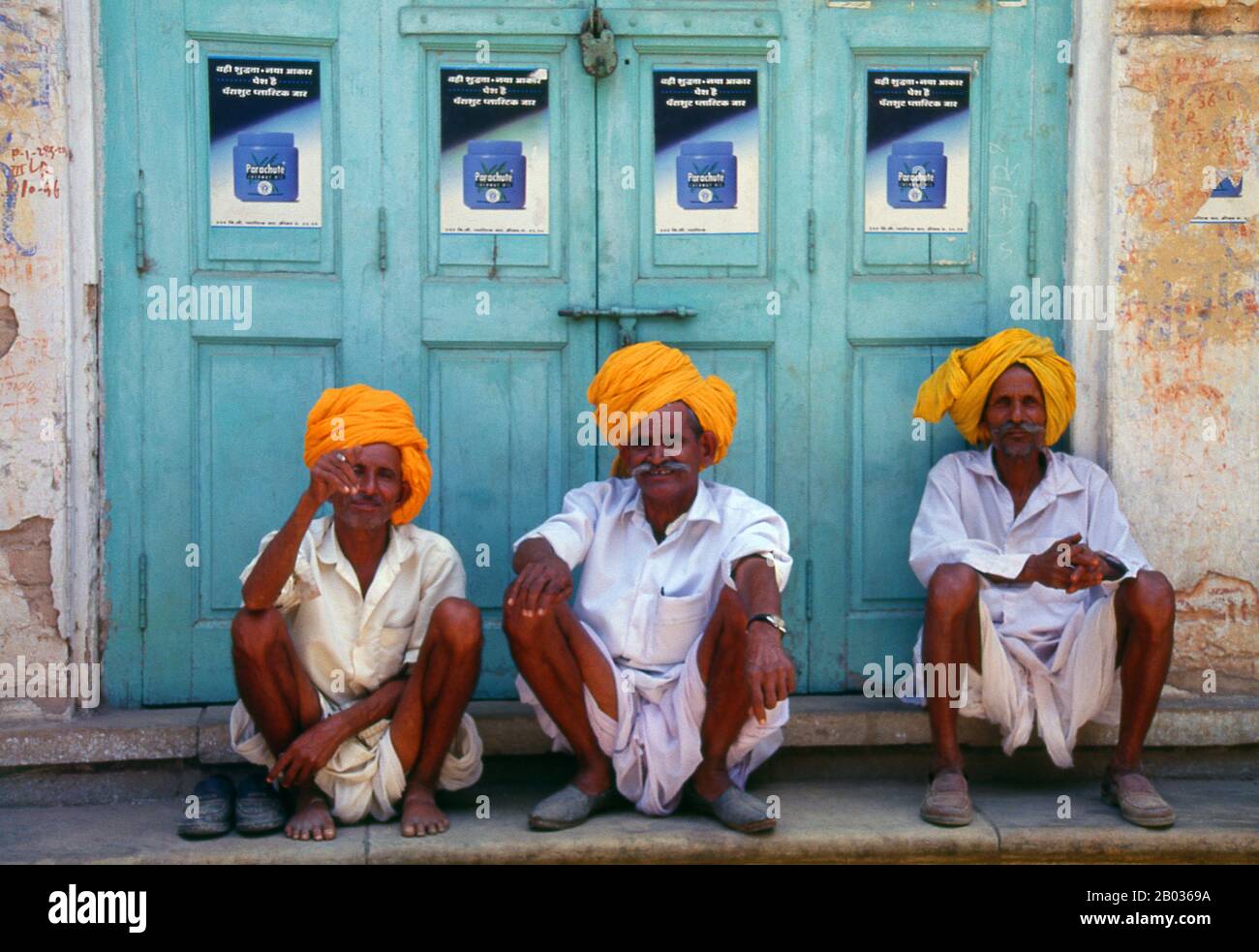 Madhya Pradesh (meaning Central Province) is a state in central India. Its capital is Bhopal and the largest city is Indore. Nicknamed the 'heart of India' due to its geographical location in India, Madhya Pradesh is the second-largest state in the country by area. With over 75 million inhabitants, it is the fifth-largest state in India by population. Stock Photohttps://www.alamy.com/image-license-details/?v=1https://www.alamy.com/madhya-pradesh-meaning-central-province-is-a-state-in-central-india-its-capital-is-bhopal-and-the-largest-city-is-indore-nicknamed-the-heart-of-india-due-to-its-geographical-location-in-india-madhya-pradesh-is-the-second-largest-state-in-the-country-by-area-with-over-75-million-inhabitants-it-is-the-fifth-largest-state-in-india-by-population-image344278182.html
Madhya Pradesh (meaning Central Province) is a state in central India. Its capital is Bhopal and the largest city is Indore. Nicknamed the 'heart of India' due to its geographical location in India, Madhya Pradesh is the second-largest state in the country by area. With over 75 million inhabitants, it is the fifth-largest state in India by population. Stock Photohttps://www.alamy.com/image-license-details/?v=1https://www.alamy.com/madhya-pradesh-meaning-central-province-is-a-state-in-central-india-its-capital-is-bhopal-and-the-largest-city-is-indore-nicknamed-the-heart-of-india-due-to-its-geographical-location-in-india-madhya-pradesh-is-the-second-largest-state-in-the-country-by-area-with-over-75-million-inhabitants-it-is-the-fifth-largest-state-in-india-by-population-image344278182.htmlRM2B0369A–Madhya Pradesh (meaning Central Province) is a state in central India. Its capital is Bhopal and the largest city is Indore. Nicknamed the 'heart of India' due to its geographical location in India, Madhya Pradesh is the second-largest state in the country by area. With over 75 million inhabitants, it is the fifth-largest state in India by population.
 The Tundikhel is a grass-covered parade ground, about half a kilometre long and a quarter kilometre wide. The area was given its present form by commander-in-chief Bhimsen Thapa (1775-1839). According to the Nepalese chronicles, though, a young boy by the name of Kesh-Chandra Malla, the son of a nobleman, had laid out an open space at the site as far back as the 12th century. The money for it allegedly came from some maggots which were lodged in grain and which miraculously transformed into gold. The tale continues with Kesh-Chandra Malla giving the Tundikhel to the ogre Guru Mapa (a form of Stock Photohttps://www.alamy.com/image-license-details/?v=1https://www.alamy.com/the-tundikhel-is-a-grass-covered-parade-ground-about-half-a-kilometre-long-and-a-quarter-kilometre-wide-the-area-was-given-its-present-form-by-commander-in-chief-bhimsen-thapa-1775-1839-according-to-the-nepalese-chronicles-though-a-young-boy-by-the-name-of-kesh-chandra-malla-the-son-of-a-nobleman-had-laid-out-an-open-space-at-the-site-as-far-back-as-the-12th-century-the-money-for-it-allegedly-came-from-some-maggots-which-were-lodged-in-grain-and-which-miraculously-transformed-into-gold-the-tale-continues-with-kesh-chandra-malla-giving-the-tundikhel-to-the-ogre-guru-mapa-a-form-of-image344272375.html
The Tundikhel is a grass-covered parade ground, about half a kilometre long and a quarter kilometre wide. The area was given its present form by commander-in-chief Bhimsen Thapa (1775-1839). According to the Nepalese chronicles, though, a young boy by the name of Kesh-Chandra Malla, the son of a nobleman, had laid out an open space at the site as far back as the 12th century. The money for it allegedly came from some maggots which were lodged in grain and which miraculously transformed into gold. The tale continues with Kesh-Chandra Malla giving the Tundikhel to the ogre Guru Mapa (a form of Stock Photohttps://www.alamy.com/image-license-details/?v=1https://www.alamy.com/the-tundikhel-is-a-grass-covered-parade-ground-about-half-a-kilometre-long-and-a-quarter-kilometre-wide-the-area-was-given-its-present-form-by-commander-in-chief-bhimsen-thapa-1775-1839-according-to-the-nepalese-chronicles-though-a-young-boy-by-the-name-of-kesh-chandra-malla-the-son-of-a-nobleman-had-laid-out-an-open-space-at-the-site-as-far-back-as-the-12th-century-the-money-for-it-allegedly-came-from-some-maggots-which-were-lodged-in-grain-and-which-miraculously-transformed-into-gold-the-tale-continues-with-kesh-chandra-malla-giving-the-tundikhel-to-the-ogre-guru-mapa-a-form-of-image344272375.htmlRM2B02XWY–The Tundikhel is a grass-covered parade ground, about half a kilometre long and a quarter kilometre wide. The area was given its present form by commander-in-chief Bhimsen Thapa (1775-1839). According to the Nepalese chronicles, though, a young boy by the name of Kesh-Chandra Malla, the son of a nobleman, had laid out an open space at the site as far back as the 12th century. The money for it allegedly came from some maggots which were lodged in grain and which miraculously transformed into gold. The tale continues with Kesh-Chandra Malla giving the Tundikhel to the ogre Guru Mapa (a form of
 Kutch (often spelled Kachch) is the northwestern part of the Indian state of Gujarat, divided from the main part of the state by the Arabian Sea and a stretch of salt marshes. To its north lies the Pakistani province of Sind. The name Kutch is said to be derived from the Kachelas, a sub-caste of the lohar (blacksmiths’) or soni (goldsmiths’) castes. Stock Photohttps://www.alamy.com/image-license-details/?v=1https://www.alamy.com/kutch-often-spelled-kachch-is-the-northwestern-part-of-the-indian-state-of-gujarat-divided-from-the-main-part-of-the-state-by-the-arabian-sea-and-a-stretch-of-salt-marshes-to-its-north-lies-the-pakistani-province-of-sind-the-name-kutch-is-said-to-be-derived-from-the-kachelas-a-sub-caste-of-the-lohar-blacksmiths-or-soni-goldsmiths-castes-image344281378.html
Kutch (often spelled Kachch) is the northwestern part of the Indian state of Gujarat, divided from the main part of the state by the Arabian Sea and a stretch of salt marshes. To its north lies the Pakistani province of Sind. The name Kutch is said to be derived from the Kachelas, a sub-caste of the lohar (blacksmiths’) or soni (goldsmiths’) castes. Stock Photohttps://www.alamy.com/image-license-details/?v=1https://www.alamy.com/kutch-often-spelled-kachch-is-the-northwestern-part-of-the-indian-state-of-gujarat-divided-from-the-main-part-of-the-state-by-the-arabian-sea-and-a-stretch-of-salt-marshes-to-its-north-lies-the-pakistani-province-of-sind-the-name-kutch-is-said-to-be-derived-from-the-kachelas-a-sub-caste-of-the-lohar-blacksmiths-or-soni-goldsmiths-castes-image344281378.htmlRM2B03ABE–Kutch (often spelled Kachch) is the northwestern part of the Indian state of Gujarat, divided from the main part of the state by the Arabian Sea and a stretch of salt marshes. To its north lies the Pakistani province of Sind. The name Kutch is said to be derived from the Kachelas, a sub-caste of the lohar (blacksmiths’) or soni (goldsmiths’) castes.
 Diu town was historically part of the Saurashtra region of Gujarat and an important port on the trade routes of the Arabian sea and Indian Ocean. In 1535 Bahadur Shah, the Sultan of Gujarat, concluded a defensive alliance with the Portuguese against the Mughal emperor Humayun, and allowed the Portuguese to construct the Diu Fort and maintain a garrison on the island. The alliance quickly unraveled, and attempts by the Sultans to oust the Portuguese from Diu between 1537 and 1546 failed. Having repented of his generosity, Bahadur Shah sought to recover Diu, but was defeated and killed by the Stock Photohttps://www.alamy.com/image-license-details/?v=1https://www.alamy.com/diu-town-was-historically-part-of-the-saurashtra-region-of-gujarat-and-an-important-port-on-the-trade-routes-of-the-arabian-sea-and-indian-ocean-in-1535-bahadur-shah-the-sultan-of-gujarat-concluded-a-defensive-alliance-with-the-portuguese-against-the-mughal-emperor-humayun-and-allowed-the-portuguese-to-construct-the-diu-fort-and-maintain-a-garrison-on-the-island-the-alliance-quickly-unraveled-and-attempts-by-the-sultans-to-oust-the-portuguese-from-diu-between-1537-and-1546-failed-having-repented-of-his-generosity-bahadur-shah-sought-to-recover-diu-but-was-defeated-and-killed-by-the-image344279621.html
Diu town was historically part of the Saurashtra region of Gujarat and an important port on the trade routes of the Arabian sea and Indian Ocean. In 1535 Bahadur Shah, the Sultan of Gujarat, concluded a defensive alliance with the Portuguese against the Mughal emperor Humayun, and allowed the Portuguese to construct the Diu Fort and maintain a garrison on the island. The alliance quickly unraveled, and attempts by the Sultans to oust the Portuguese from Diu between 1537 and 1546 failed. Having repented of his generosity, Bahadur Shah sought to recover Diu, but was defeated and killed by the Stock Photohttps://www.alamy.com/image-license-details/?v=1https://www.alamy.com/diu-town-was-historically-part-of-the-saurashtra-region-of-gujarat-and-an-important-port-on-the-trade-routes-of-the-arabian-sea-and-indian-ocean-in-1535-bahadur-shah-the-sultan-of-gujarat-concluded-a-defensive-alliance-with-the-portuguese-against-the-mughal-emperor-humayun-and-allowed-the-portuguese-to-construct-the-diu-fort-and-maintain-a-garrison-on-the-island-the-alliance-quickly-unraveled-and-attempts-by-the-sultans-to-oust-the-portuguese-from-diu-between-1537-and-1546-failed-having-repented-of-his-generosity-bahadur-shah-sought-to-recover-diu-but-was-defeated-and-killed-by-the-image344279621.htmlRM2B0384N–Diu town was historically part of the Saurashtra region of Gujarat and an important port on the trade routes of the Arabian sea and Indian Ocean. In 1535 Bahadur Shah, the Sultan of Gujarat, concluded a defensive alliance with the Portuguese against the Mughal emperor Humayun, and allowed the Portuguese to construct the Diu Fort and maintain a garrison on the island. The alliance quickly unraveled, and attempts by the Sultans to oust the Portuguese from Diu between 1537 and 1546 failed. Having repented of his generosity, Bahadur Shah sought to recover Diu, but was defeated and killed by the
 Kutch (often spelled Kachch) is the northwestern part of the Indian state of Gujarat, divided from the main part of the state by the Arabian Sea and a stretch of salt marshes. To its north lies the Pakistani province of Sind. The name Kutch is said to be derived from the Kachelas, a sub-caste of the lohar (blacksmiths’) or soni (goldsmiths’) castes. Stock Photohttps://www.alamy.com/image-license-details/?v=1https://www.alamy.com/kutch-often-spelled-kachch-is-the-northwestern-part-of-the-indian-state-of-gujarat-divided-from-the-main-part-of-the-state-by-the-arabian-sea-and-a-stretch-of-salt-marshes-to-its-north-lies-the-pakistani-province-of-sind-the-name-kutch-is-said-to-be-derived-from-the-kachelas-a-sub-caste-of-the-lohar-blacksmiths-or-soni-goldsmiths-castes-image344279188.html
Kutch (often spelled Kachch) is the northwestern part of the Indian state of Gujarat, divided from the main part of the state by the Arabian Sea and a stretch of salt marshes. To its north lies the Pakistani province of Sind. The name Kutch is said to be derived from the Kachelas, a sub-caste of the lohar (blacksmiths’) or soni (goldsmiths’) castes. Stock Photohttps://www.alamy.com/image-license-details/?v=1https://www.alamy.com/kutch-often-spelled-kachch-is-the-northwestern-part-of-the-indian-state-of-gujarat-divided-from-the-main-part-of-the-state-by-the-arabian-sea-and-a-stretch-of-salt-marshes-to-its-north-lies-the-pakistani-province-of-sind-the-name-kutch-is-said-to-be-derived-from-the-kachelas-a-sub-caste-of-the-lohar-blacksmiths-or-soni-goldsmiths-castes-image344279188.htmlRM2B037H8–Kutch (often spelled Kachch) is the northwestern part of the Indian state of Gujarat, divided from the main part of the state by the Arabian Sea and a stretch of salt marshes. To its north lies the Pakistani province of Sind. The name Kutch is said to be derived from the Kachelas, a sub-caste of the lohar (blacksmiths’) or soni (goldsmiths’) castes.
 Madhya Pradesh (meaning Central Province) is a state in central India. Its capital is Bhopal and the largest city is Indore. Nicknamed the 'heart of India' due to its geographical location in India, Madhya Pradesh is the second-largest state in the country by area. With over 75 million inhabitants, it is the fifth-largest state in India by population. Stock Photohttps://www.alamy.com/image-license-details/?v=1https://www.alamy.com/madhya-pradesh-meaning-central-province-is-a-state-in-central-india-its-capital-is-bhopal-and-the-largest-city-is-indore-nicknamed-the-heart-of-india-due-to-its-geographical-location-in-india-madhya-pradesh-is-the-second-largest-state-in-the-country-by-area-with-over-75-million-inhabitants-it-is-the-fifth-largest-state-in-india-by-population-image344278192.html
Madhya Pradesh (meaning Central Province) is a state in central India. Its capital is Bhopal and the largest city is Indore. Nicknamed the 'heart of India' due to its geographical location in India, Madhya Pradesh is the second-largest state in the country by area. With over 75 million inhabitants, it is the fifth-largest state in India by population. Stock Photohttps://www.alamy.com/image-license-details/?v=1https://www.alamy.com/madhya-pradesh-meaning-central-province-is-a-state-in-central-india-its-capital-is-bhopal-and-the-largest-city-is-indore-nicknamed-the-heart-of-india-due-to-its-geographical-location-in-india-madhya-pradesh-is-the-second-largest-state-in-the-country-by-area-with-over-75-million-inhabitants-it-is-the-fifth-largest-state-in-india-by-population-image344278192.htmlRM2B0369M–Madhya Pradesh (meaning Central Province) is a state in central India. Its capital is Bhopal and the largest city is Indore. Nicknamed the 'heart of India' due to its geographical location in India, Madhya Pradesh is the second-largest state in the country by area. With over 75 million inhabitants, it is the fifth-largest state in India by population.
 Madhya Pradesh (meaning Central Province) is a state in central India. Its capital is Bhopal and the largest city is Indore. Nicknamed the 'heart of India' due to its geographical location in India, Madhya Pradesh is the second-largest state in the country by area. With over 75 million inhabitants, it is the fifth-largest state in India by population. Stock Photohttps://www.alamy.com/image-license-details/?v=1https://www.alamy.com/madhya-pradesh-meaning-central-province-is-a-state-in-central-india-its-capital-is-bhopal-and-the-largest-city-is-indore-nicknamed-the-heart-of-india-due-to-its-geographical-location-in-india-madhya-pradesh-is-the-second-largest-state-in-the-country-by-area-with-over-75-million-inhabitants-it-is-the-fifth-largest-state-in-india-by-population-image344278188.html
Madhya Pradesh (meaning Central Province) is a state in central India. Its capital is Bhopal and the largest city is Indore. Nicknamed the 'heart of India' due to its geographical location in India, Madhya Pradesh is the second-largest state in the country by area. With over 75 million inhabitants, it is the fifth-largest state in India by population. Stock Photohttps://www.alamy.com/image-license-details/?v=1https://www.alamy.com/madhya-pradesh-meaning-central-province-is-a-state-in-central-india-its-capital-is-bhopal-and-the-largest-city-is-indore-nicknamed-the-heart-of-india-due-to-its-geographical-location-in-india-madhya-pradesh-is-the-second-largest-state-in-the-country-by-area-with-over-75-million-inhabitants-it-is-the-fifth-largest-state-in-india-by-population-image344278188.htmlRM2B0369G–Madhya Pradesh (meaning Central Province) is a state in central India. Its capital is Bhopal and the largest city is Indore. Nicknamed the 'heart of India' due to its geographical location in India, Madhya Pradesh is the second-largest state in the country by area. With over 75 million inhabitants, it is the fifth-largest state in India by population.
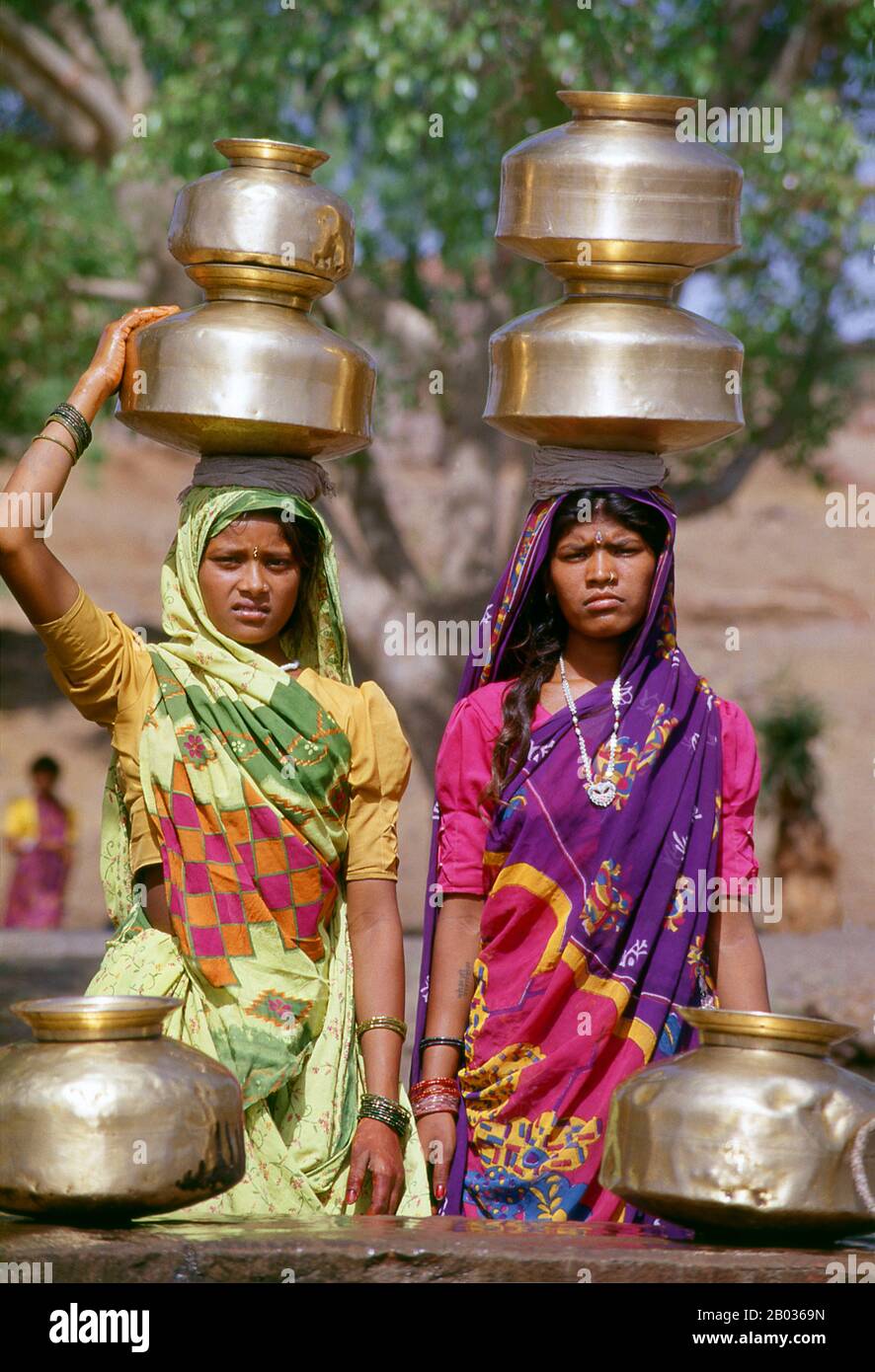 Madhya Pradesh (meaning Central Province) is a state in central India. Its capital is Bhopal and the largest city is Indore. Nicknamed the 'heart of India' due to its geographical location in India, Madhya Pradesh is the second-largest state in the country by area. With over 75 million inhabitants, it is the fifth-largest state in India by population. Stock Photohttps://www.alamy.com/image-license-details/?v=1https://www.alamy.com/madhya-pradesh-meaning-central-province-is-a-state-in-central-india-its-capital-is-bhopal-and-the-largest-city-is-indore-nicknamed-the-heart-of-india-due-to-its-geographical-location-in-india-madhya-pradesh-is-the-second-largest-state-in-the-country-by-area-with-over-75-million-inhabitants-it-is-the-fifth-largest-state-in-india-by-population-image344278193.html
Madhya Pradesh (meaning Central Province) is a state in central India. Its capital is Bhopal and the largest city is Indore. Nicknamed the 'heart of India' due to its geographical location in India, Madhya Pradesh is the second-largest state in the country by area. With over 75 million inhabitants, it is the fifth-largest state in India by population. Stock Photohttps://www.alamy.com/image-license-details/?v=1https://www.alamy.com/madhya-pradesh-meaning-central-province-is-a-state-in-central-india-its-capital-is-bhopal-and-the-largest-city-is-indore-nicknamed-the-heart-of-india-due-to-its-geographical-location-in-india-madhya-pradesh-is-the-second-largest-state-in-the-country-by-area-with-over-75-million-inhabitants-it-is-the-fifth-largest-state-in-india-by-population-image344278193.htmlRM2B0369N–Madhya Pradesh (meaning Central Province) is a state in central India. Its capital is Bhopal and the largest city is Indore. Nicknamed the 'heart of India' due to its geographical location in India, Madhya Pradesh is the second-largest state in the country by area. With over 75 million inhabitants, it is the fifth-largest state in India by population.
 Kutch (often spelled Kachch) is the northwestern part of the Indian state of Gujarat, divided from the main part of the state by the Arabian Sea and a stretch of salt marshes. To its north lies the Pakistani province of Sind. The name Kutch is said to be derived from the Kachelas, a sub-caste of the lohar (blacksmiths’) or soni (goldsmiths’) castes. Stock Photohttps://www.alamy.com/image-license-details/?v=1https://www.alamy.com/kutch-often-spelled-kachch-is-the-northwestern-part-of-the-indian-state-of-gujarat-divided-from-the-main-part-of-the-state-by-the-arabian-sea-and-a-stretch-of-salt-marshes-to-its-north-lies-the-pakistani-province-of-sind-the-name-kutch-is-said-to-be-derived-from-the-kachelas-a-sub-caste-of-the-lohar-blacksmiths-or-soni-goldsmiths-castes-image344281303.html
Kutch (often spelled Kachch) is the northwestern part of the Indian state of Gujarat, divided from the main part of the state by the Arabian Sea and a stretch of salt marshes. To its north lies the Pakistani province of Sind. The name Kutch is said to be derived from the Kachelas, a sub-caste of the lohar (blacksmiths’) or soni (goldsmiths’) castes. Stock Photohttps://www.alamy.com/image-license-details/?v=1https://www.alamy.com/kutch-often-spelled-kachch-is-the-northwestern-part-of-the-indian-state-of-gujarat-divided-from-the-main-part-of-the-state-by-the-arabian-sea-and-a-stretch-of-salt-marshes-to-its-north-lies-the-pakistani-province-of-sind-the-name-kutch-is-said-to-be-derived-from-the-kachelas-a-sub-caste-of-the-lohar-blacksmiths-or-soni-goldsmiths-castes-image344281303.htmlRM2B03A8R–Kutch (often spelled Kachch) is the northwestern part of the Indian state of Gujarat, divided from the main part of the state by the Arabian Sea and a stretch of salt marshes. To its north lies the Pakistani province of Sind. The name Kutch is said to be derived from the Kachelas, a sub-caste of the lohar (blacksmiths’) or soni (goldsmiths’) castes.
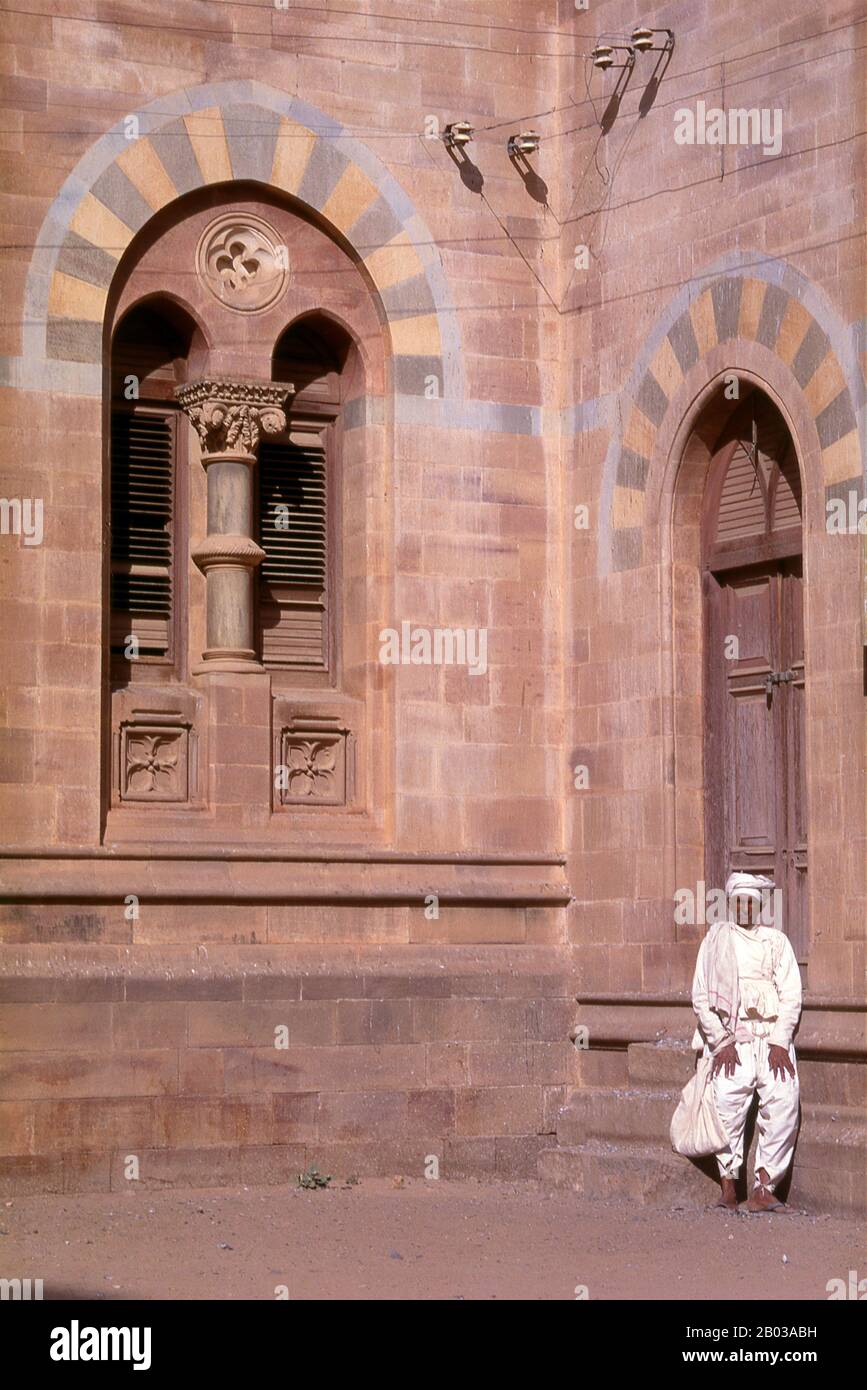 Vijaya Vilas Palace is the one time summer palace of the Jadeja Rajas of Kutch. The palace was built during the reign of Maharao Shri Khengarji III, the Maharao of Kutch, as a summer resort for the use of his son and heir to the kingdom, the Yuvraj Shri Vijayaraji. The construction of the palace started in 1920 and was completed in 1929. Kutch (often spelled Kachch) is the northwestern part of the Indian state of Gujarat, divided from the main part of the state by the Arabian Sea and a stretch of salt marshes. To its north lies the Pakistani province of Sind. The name Kutch is said to be deri Stock Photohttps://www.alamy.com/image-license-details/?v=1https://www.alamy.com/vijaya-vilas-palace-is-the-one-time-summer-palace-of-the-jadeja-rajas-of-kutch-the-palace-was-built-during-the-reign-of-maharao-shri-khengarji-iii-the-maharao-of-kutch-as-a-summer-resort-for-the-use-of-his-son-and-heir-to-the-kingdom-the-yuvraj-shri-vijayaraji-the-construction-of-the-palace-started-in-1920-and-was-completed-in-1929-kutch-often-spelled-kachch-is-the-northwestern-part-of-the-indian-state-of-gujarat-divided-from-the-main-part-of-the-state-by-the-arabian-sea-and-a-stretch-of-salt-marshes-to-its-north-lies-the-pakistani-province-of-sind-the-name-kutch-is-said-to-be-deri-image344281381.html
Vijaya Vilas Palace is the one time summer palace of the Jadeja Rajas of Kutch. The palace was built during the reign of Maharao Shri Khengarji III, the Maharao of Kutch, as a summer resort for the use of his son and heir to the kingdom, the Yuvraj Shri Vijayaraji. The construction of the palace started in 1920 and was completed in 1929. Kutch (often spelled Kachch) is the northwestern part of the Indian state of Gujarat, divided from the main part of the state by the Arabian Sea and a stretch of salt marshes. To its north lies the Pakistani province of Sind. The name Kutch is said to be deri Stock Photohttps://www.alamy.com/image-license-details/?v=1https://www.alamy.com/vijaya-vilas-palace-is-the-one-time-summer-palace-of-the-jadeja-rajas-of-kutch-the-palace-was-built-during-the-reign-of-maharao-shri-khengarji-iii-the-maharao-of-kutch-as-a-summer-resort-for-the-use-of-his-son-and-heir-to-the-kingdom-the-yuvraj-shri-vijayaraji-the-construction-of-the-palace-started-in-1920-and-was-completed-in-1929-kutch-often-spelled-kachch-is-the-northwestern-part-of-the-indian-state-of-gujarat-divided-from-the-main-part-of-the-state-by-the-arabian-sea-and-a-stretch-of-salt-marshes-to-its-north-lies-the-pakistani-province-of-sind-the-name-kutch-is-said-to-be-deri-image344281381.htmlRM2B03ABH–Vijaya Vilas Palace is the one time summer palace of the Jadeja Rajas of Kutch. The palace was built during the reign of Maharao Shri Khengarji III, the Maharao of Kutch, as a summer resort for the use of his son and heir to the kingdom, the Yuvraj Shri Vijayaraji. The construction of the palace started in 1920 and was completed in 1929. Kutch (often spelled Kachch) is the northwestern part of the Indian state of Gujarat, divided from the main part of the state by the Arabian Sea and a stretch of salt marshes. To its north lies the Pakistani province of Sind. The name Kutch is said to be deri
 Vijaya Vilas Palace is the one time summer palace of the Jadeja Rajas of Kutch. The palace was built during the reign of Maharao Shri Khengarji III, the Maharao of Kutch, as a summer resort for the use of his son and heir to the kingdom, the Yuvraj Shri Vijayaraji. The construction of the palace started in 1920 and was completed in 1929. Kutch (often spelled Kachch) is the northwestern part of the Indian state of Gujarat, divided from the main part of the state by the Arabian Sea and a stretch of salt marshes. To its north lies the Pakistani province of Sind. The name Kutch is said to be deri Stock Photohttps://www.alamy.com/image-license-details/?v=1https://www.alamy.com/vijaya-vilas-palace-is-the-one-time-summer-palace-of-the-jadeja-rajas-of-kutch-the-palace-was-built-during-the-reign-of-maharao-shri-khengarji-iii-the-maharao-of-kutch-as-a-summer-resort-for-the-use-of-his-son-and-heir-to-the-kingdom-the-yuvraj-shri-vijayaraji-the-construction-of-the-palace-started-in-1920-and-was-completed-in-1929-kutch-often-spelled-kachch-is-the-northwestern-part-of-the-indian-state-of-gujarat-divided-from-the-main-part-of-the-state-by-the-arabian-sea-and-a-stretch-of-salt-marshes-to-its-north-lies-the-pakistani-province-of-sind-the-name-kutch-is-said-to-be-deri-image344279973.html
Vijaya Vilas Palace is the one time summer palace of the Jadeja Rajas of Kutch. The palace was built during the reign of Maharao Shri Khengarji III, the Maharao of Kutch, as a summer resort for the use of his son and heir to the kingdom, the Yuvraj Shri Vijayaraji. The construction of the palace started in 1920 and was completed in 1929. Kutch (often spelled Kachch) is the northwestern part of the Indian state of Gujarat, divided from the main part of the state by the Arabian Sea and a stretch of salt marshes. To its north lies the Pakistani province of Sind. The name Kutch is said to be deri Stock Photohttps://www.alamy.com/image-license-details/?v=1https://www.alamy.com/vijaya-vilas-palace-is-the-one-time-summer-palace-of-the-jadeja-rajas-of-kutch-the-palace-was-built-during-the-reign-of-maharao-shri-khengarji-iii-the-maharao-of-kutch-as-a-summer-resort-for-the-use-of-his-son-and-heir-to-the-kingdom-the-yuvraj-shri-vijayaraji-the-construction-of-the-palace-started-in-1920-and-was-completed-in-1929-kutch-often-spelled-kachch-is-the-northwestern-part-of-the-indian-state-of-gujarat-divided-from-the-main-part-of-the-state-by-the-arabian-sea-and-a-stretch-of-salt-marshes-to-its-north-lies-the-pakistani-province-of-sind-the-name-kutch-is-said-to-be-deri-image344279973.htmlRM2B038H9–Vijaya Vilas Palace is the one time summer palace of the Jadeja Rajas of Kutch. The palace was built during the reign of Maharao Shri Khengarji III, the Maharao of Kutch, as a summer resort for the use of his son and heir to the kingdom, the Yuvraj Shri Vijayaraji. The construction of the palace started in 1920 and was completed in 1929. Kutch (often spelled Kachch) is the northwestern part of the Indian state of Gujarat, divided from the main part of the state by the Arabian Sea and a stretch of salt marshes. To its north lies the Pakistani province of Sind. The name Kutch is said to be deri
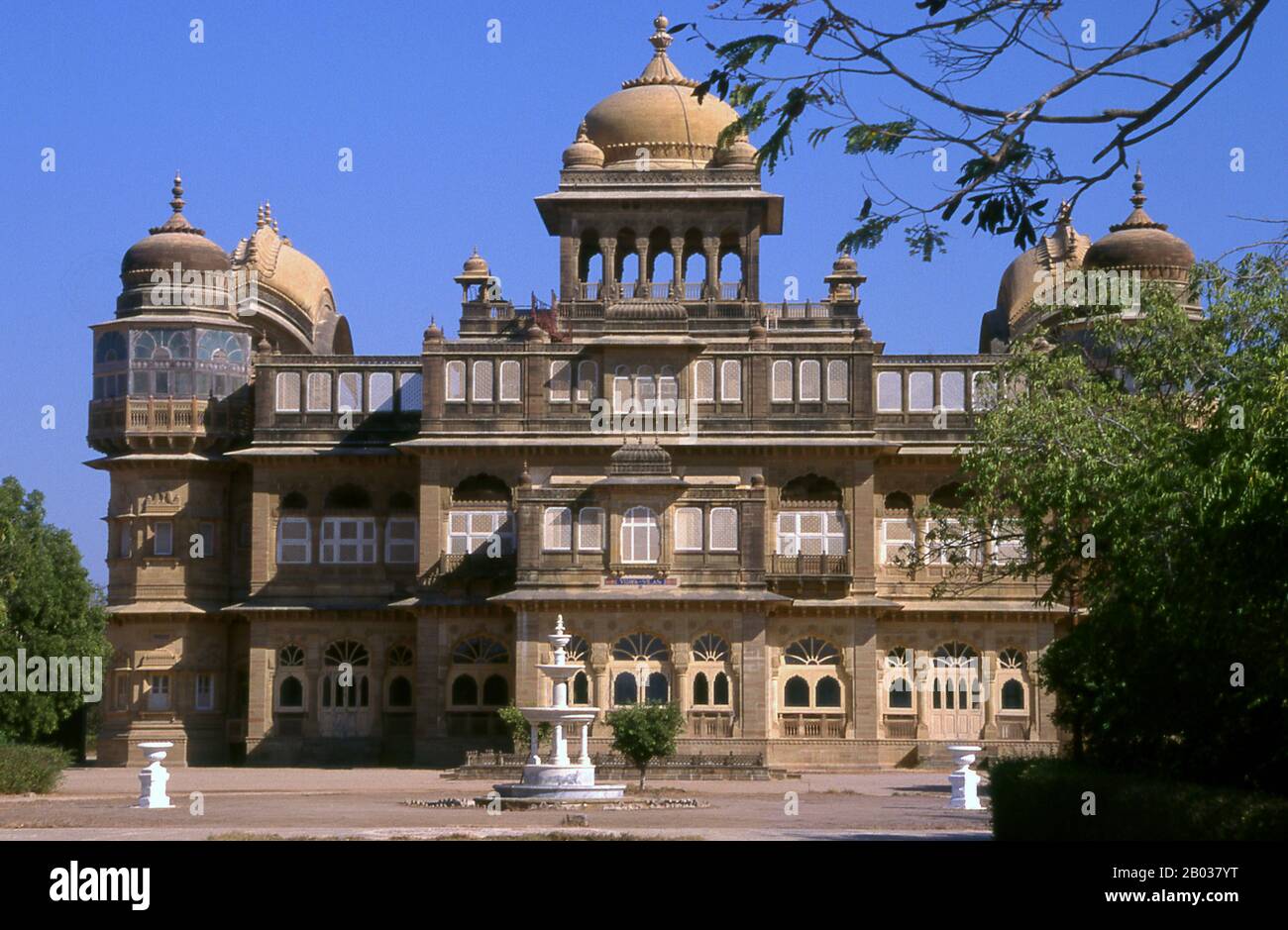 Vijaya Vilas Palace is the one time summer palace of the Jadeja Rajas of Kutch. The palace was built during the reign of Maharao Shri Khengarji III, the Maharao of Kutch, as a summer resort for the use of his son and heir to the kingdom, the Yuvraj Shri Vijayaraji. The construction of the palace started in 1920 and was completed in 1929. Kutch (often spelled Kachch) is the northwestern part of the Indian state of Gujarat, divided from the main part of the state by the Arabian Sea and a stretch of salt marshes. To its north lies the Pakistani province of Sind. The name Kutch is said to be deri Stock Photohttps://www.alamy.com/image-license-details/?v=1https://www.alamy.com/vijaya-vilas-palace-is-the-one-time-summer-palace-of-the-jadeja-rajas-of-kutch-the-palace-was-built-during-the-reign-of-maharao-shri-khengarji-iii-the-maharao-of-kutch-as-a-summer-resort-for-the-use-of-his-son-and-heir-to-the-kingdom-the-yuvraj-shri-vijayaraji-the-construction-of-the-palace-started-in-1920-and-was-completed-in-1929-kutch-often-spelled-kachch-is-the-northwestern-part-of-the-indian-state-of-gujarat-divided-from-the-main-part-of-the-state-by-the-arabian-sea-and-a-stretch-of-salt-marshes-to-its-north-lies-the-pakistani-province-of-sind-the-name-kutch-is-said-to-be-deri-image344279484.html
Vijaya Vilas Palace is the one time summer palace of the Jadeja Rajas of Kutch. The palace was built during the reign of Maharao Shri Khengarji III, the Maharao of Kutch, as a summer resort for the use of his son and heir to the kingdom, the Yuvraj Shri Vijayaraji. The construction of the palace started in 1920 and was completed in 1929. Kutch (often spelled Kachch) is the northwestern part of the Indian state of Gujarat, divided from the main part of the state by the Arabian Sea and a stretch of salt marshes. To its north lies the Pakistani province of Sind. The name Kutch is said to be deri Stock Photohttps://www.alamy.com/image-license-details/?v=1https://www.alamy.com/vijaya-vilas-palace-is-the-one-time-summer-palace-of-the-jadeja-rajas-of-kutch-the-palace-was-built-during-the-reign-of-maharao-shri-khengarji-iii-the-maharao-of-kutch-as-a-summer-resort-for-the-use-of-his-son-and-heir-to-the-kingdom-the-yuvraj-shri-vijayaraji-the-construction-of-the-palace-started-in-1920-and-was-completed-in-1929-kutch-often-spelled-kachch-is-the-northwestern-part-of-the-indian-state-of-gujarat-divided-from-the-main-part-of-the-state-by-the-arabian-sea-and-a-stretch-of-salt-marshes-to-its-north-lies-the-pakistani-province-of-sind-the-name-kutch-is-said-to-be-deri-image344279484.htmlRM2B037YT–Vijaya Vilas Palace is the one time summer palace of the Jadeja Rajas of Kutch. The palace was built during the reign of Maharao Shri Khengarji III, the Maharao of Kutch, as a summer resort for the use of his son and heir to the kingdom, the Yuvraj Shri Vijayaraji. The construction of the palace started in 1920 and was completed in 1929. Kutch (often spelled Kachch) is the northwestern part of the Indian state of Gujarat, divided from the main part of the state by the Arabian Sea and a stretch of salt marshes. To its north lies the Pakistani province of Sind. The name Kutch is said to be deri
 Vijaya Vilas Palace is the one time summer palace of the Jadeja Rajas of Kutch. The palace was built during the reign of Maharao Shri Khengarji III, the Maharao of Kutch, as a summer resort for the use of his son and heir to the kingdom, the Yuvraj Shri Vijayaraji. The construction of the palace started in 1920 and was completed in 1929. Kutch (often spelled Kachch) is the northwestern part of the Indian state of Gujarat, divided from the main part of the state by the Arabian Sea and a stretch of salt marshes. To its north lies the Pakistani province of Sind. The name Kutch is said to be deri Stock Photohttps://www.alamy.com/image-license-details/?v=1https://www.alamy.com/vijaya-vilas-palace-is-the-one-time-summer-palace-of-the-jadeja-rajas-of-kutch-the-palace-was-built-during-the-reign-of-maharao-shri-khengarji-iii-the-maharao-of-kutch-as-a-summer-resort-for-the-use-of-his-son-and-heir-to-the-kingdom-the-yuvraj-shri-vijayaraji-the-construction-of-the-palace-started-in-1920-and-was-completed-in-1929-kutch-often-spelled-kachch-is-the-northwestern-part-of-the-indian-state-of-gujarat-divided-from-the-main-part-of-the-state-by-the-arabian-sea-and-a-stretch-of-salt-marshes-to-its-north-lies-the-pakistani-province-of-sind-the-name-kutch-is-said-to-be-deri-image344279486.html
Vijaya Vilas Palace is the one time summer palace of the Jadeja Rajas of Kutch. The palace was built during the reign of Maharao Shri Khengarji III, the Maharao of Kutch, as a summer resort for the use of his son and heir to the kingdom, the Yuvraj Shri Vijayaraji. The construction of the palace started in 1920 and was completed in 1929. Kutch (often spelled Kachch) is the northwestern part of the Indian state of Gujarat, divided from the main part of the state by the Arabian Sea and a stretch of salt marshes. To its north lies the Pakistani province of Sind. The name Kutch is said to be deri Stock Photohttps://www.alamy.com/image-license-details/?v=1https://www.alamy.com/vijaya-vilas-palace-is-the-one-time-summer-palace-of-the-jadeja-rajas-of-kutch-the-palace-was-built-during-the-reign-of-maharao-shri-khengarji-iii-the-maharao-of-kutch-as-a-summer-resort-for-the-use-of-his-son-and-heir-to-the-kingdom-the-yuvraj-shri-vijayaraji-the-construction-of-the-palace-started-in-1920-and-was-completed-in-1929-kutch-often-spelled-kachch-is-the-northwestern-part-of-the-indian-state-of-gujarat-divided-from-the-main-part-of-the-state-by-the-arabian-sea-and-a-stretch-of-salt-marshes-to-its-north-lies-the-pakistani-province-of-sind-the-name-kutch-is-said-to-be-deri-image344279486.htmlRM2B037YX–Vijaya Vilas Palace is the one time summer palace of the Jadeja Rajas of Kutch. The palace was built during the reign of Maharao Shri Khengarji III, the Maharao of Kutch, as a summer resort for the use of his son and heir to the kingdom, the Yuvraj Shri Vijayaraji. The construction of the palace started in 1920 and was completed in 1929. Kutch (often spelled Kachch) is the northwestern part of the Indian state of Gujarat, divided from the main part of the state by the Arabian Sea and a stretch of salt marshes. To its north lies the Pakistani province of Sind. The name Kutch is said to be deri
 Vijaya Vilas Palace is the one time summer palace of the Jadeja Rajas of Kutch. The palace was built during the reign of Maharao Shri Khengarji III, the Maharao of Kutch, as a summer resort for the use of his son and heir to the kingdom, the Yuvraj Shri Vijayaraji. The construction of the palace started in 1920 and was completed in 1929. Kutch (often spelled Kachch) is the northwestern part of the Indian state of Gujarat, divided from the main part of the state by the Arabian Sea and a stretch of salt marshes. To its north lies the Pakistani province of Sind. The name Kutch is said to be deri Stock Photohttps://www.alamy.com/image-license-details/?v=1https://www.alamy.com/vijaya-vilas-palace-is-the-one-time-summer-palace-of-the-jadeja-rajas-of-kutch-the-palace-was-built-during-the-reign-of-maharao-shri-khengarji-iii-the-maharao-of-kutch-as-a-summer-resort-for-the-use-of-his-son-and-heir-to-the-kingdom-the-yuvraj-shri-vijayaraji-the-construction-of-the-palace-started-in-1920-and-was-completed-in-1929-kutch-often-spelled-kachch-is-the-northwestern-part-of-the-indian-state-of-gujarat-divided-from-the-main-part-of-the-state-by-the-arabian-sea-and-a-stretch-of-salt-marshes-to-its-north-lies-the-pakistani-province-of-sind-the-name-kutch-is-said-to-be-deri-image344279488.html
Vijaya Vilas Palace is the one time summer palace of the Jadeja Rajas of Kutch. The palace was built during the reign of Maharao Shri Khengarji III, the Maharao of Kutch, as a summer resort for the use of his son and heir to the kingdom, the Yuvraj Shri Vijayaraji. The construction of the palace started in 1920 and was completed in 1929. Kutch (often spelled Kachch) is the northwestern part of the Indian state of Gujarat, divided from the main part of the state by the Arabian Sea and a stretch of salt marshes. To its north lies the Pakistani province of Sind. The name Kutch is said to be deri Stock Photohttps://www.alamy.com/image-license-details/?v=1https://www.alamy.com/vijaya-vilas-palace-is-the-one-time-summer-palace-of-the-jadeja-rajas-of-kutch-the-palace-was-built-during-the-reign-of-maharao-shri-khengarji-iii-the-maharao-of-kutch-as-a-summer-resort-for-the-use-of-his-son-and-heir-to-the-kingdom-the-yuvraj-shri-vijayaraji-the-construction-of-the-palace-started-in-1920-and-was-completed-in-1929-kutch-often-spelled-kachch-is-the-northwestern-part-of-the-indian-state-of-gujarat-divided-from-the-main-part-of-the-state-by-the-arabian-sea-and-a-stretch-of-salt-marshes-to-its-north-lies-the-pakistani-province-of-sind-the-name-kutch-is-said-to-be-deri-image344279488.htmlRM2B03800–Vijaya Vilas Palace is the one time summer palace of the Jadeja Rajas of Kutch. The palace was built during the reign of Maharao Shri Khengarji III, the Maharao of Kutch, as a summer resort for the use of his son and heir to the kingdom, the Yuvraj Shri Vijayaraji. The construction of the palace started in 1920 and was completed in 1929. Kutch (often spelled Kachch) is the northwestern part of the Indian state of Gujarat, divided from the main part of the state by the Arabian Sea and a stretch of salt marshes. To its north lies the Pakistani province of Sind. The name Kutch is said to be deri
 The Jain's sacred site of Shatrunjaya contains hundreds of Palitana temples built mostly between the 11th Century and 16th Century CE. The Shatrunjaya Hills were sanctified when Rishabha, the first tirthankara (omniscient Teaching God) of Jainism, gave his first sermon in the temple on the hill top. The ancient history of the hills is also traced to Pundarika Swami, a chief Ganadhara and grandson of Rishabha, who attained salvation here. His shrine located opposite to the main Adinath temple, built by his son Bharata, is also worshiped by pilgrims. Stock Photohttps://www.alamy.com/image-license-details/?v=1https://www.alamy.com/the-jains-sacred-site-of-shatrunjaya-contains-hundreds-of-palitana-temples-built-mostly-between-the-11th-century-and-16th-century-ce-the-shatrunjaya-hills-were-sanctified-when-rishabha-the-first-tirthankara-omniscient-teaching-god-of-jainism-gave-his-first-sermon-in-the-temple-on-the-hill-top-the-ancient-history-of-the-hills-is-also-traced-to-pundarika-swami-a-chief-ganadhara-and-grandson-of-rishabha-who-attained-salvation-here-his-shrine-located-opposite-to-the-main-adinath-temple-built-by-his-son-bharata-is-also-worshiped-by-pilgrims-image344277526.html
The Jain's sacred site of Shatrunjaya contains hundreds of Palitana temples built mostly between the 11th Century and 16th Century CE. The Shatrunjaya Hills were sanctified when Rishabha, the first tirthankara (omniscient Teaching God) of Jainism, gave his first sermon in the temple on the hill top. The ancient history of the hills is also traced to Pundarika Swami, a chief Ganadhara and grandson of Rishabha, who attained salvation here. His shrine located opposite to the main Adinath temple, built by his son Bharata, is also worshiped by pilgrims. Stock Photohttps://www.alamy.com/image-license-details/?v=1https://www.alamy.com/the-jains-sacred-site-of-shatrunjaya-contains-hundreds-of-palitana-temples-built-mostly-between-the-11th-century-and-16th-century-ce-the-shatrunjaya-hills-were-sanctified-when-rishabha-the-first-tirthankara-omniscient-teaching-god-of-jainism-gave-his-first-sermon-in-the-temple-on-the-hill-top-the-ancient-history-of-the-hills-is-also-traced-to-pundarika-swami-a-chief-ganadhara-and-grandson-of-rishabha-who-attained-salvation-here-his-shrine-located-opposite-to-the-main-adinath-temple-built-by-his-son-bharata-is-also-worshiped-by-pilgrims-image344277526.htmlRM2B035DX–The Jain's sacred site of Shatrunjaya contains hundreds of Palitana temples built mostly between the 11th Century and 16th Century CE. The Shatrunjaya Hills were sanctified when Rishabha, the first tirthankara (omniscient Teaching God) of Jainism, gave his first sermon in the temple on the hill top. The ancient history of the hills is also traced to Pundarika Swami, a chief Ganadhara and grandson of Rishabha, who attained salvation here. His shrine located opposite to the main Adinath temple, built by his son Bharata, is also worshiped by pilgrims.
 The Jain's sacred site of Shatrunjaya contains hundreds of Palitana temples built mostly between the 11th Century and 16th Century CE. The Shatrunjaya Hills were sanctified when Rishabha, the first tirthankara (omniscient Teaching God) of Jainism, gave his first sermon in the temple on the hill top. The ancient history of the hills is also traced to Pundarika Swami, a chief Ganadhara and grandson of Rishabha, who attained salvation here. His shrine located opposite to the main Adinath temple, built by his son Bharata, is also worshiped by pilgrims. Stock Photohttps://www.alamy.com/image-license-details/?v=1https://www.alamy.com/the-jains-sacred-site-of-shatrunjaya-contains-hundreds-of-palitana-temples-built-mostly-between-the-11th-century-and-16th-century-ce-the-shatrunjaya-hills-were-sanctified-when-rishabha-the-first-tirthankara-omniscient-teaching-god-of-jainism-gave-his-first-sermon-in-the-temple-on-the-hill-top-the-ancient-history-of-the-hills-is-also-traced-to-pundarika-swami-a-chief-ganadhara-and-grandson-of-rishabha-who-attained-salvation-here-his-shrine-located-opposite-to-the-main-adinath-temple-built-by-his-son-bharata-is-also-worshiped-by-pilgrims-image344281038.html
The Jain's sacred site of Shatrunjaya contains hundreds of Palitana temples built mostly between the 11th Century and 16th Century CE. The Shatrunjaya Hills were sanctified when Rishabha, the first tirthankara (omniscient Teaching God) of Jainism, gave his first sermon in the temple on the hill top. The ancient history of the hills is also traced to Pundarika Swami, a chief Ganadhara and grandson of Rishabha, who attained salvation here. His shrine located opposite to the main Adinath temple, built by his son Bharata, is also worshiped by pilgrims. Stock Photohttps://www.alamy.com/image-license-details/?v=1https://www.alamy.com/the-jains-sacred-site-of-shatrunjaya-contains-hundreds-of-palitana-temples-built-mostly-between-the-11th-century-and-16th-century-ce-the-shatrunjaya-hills-were-sanctified-when-rishabha-the-first-tirthankara-omniscient-teaching-god-of-jainism-gave-his-first-sermon-in-the-temple-on-the-hill-top-the-ancient-history-of-the-hills-is-also-traced-to-pundarika-swami-a-chief-ganadhara-and-grandson-of-rishabha-who-attained-salvation-here-his-shrine-located-opposite-to-the-main-adinath-temple-built-by-his-son-bharata-is-also-worshiped-by-pilgrims-image344281038.htmlRM2B039YA–The Jain's sacred site of Shatrunjaya contains hundreds of Palitana temples built mostly between the 11th Century and 16th Century CE. The Shatrunjaya Hills were sanctified when Rishabha, the first tirthankara (omniscient Teaching God) of Jainism, gave his first sermon in the temple on the hill top. The ancient history of the hills is also traced to Pundarika Swami, a chief Ganadhara and grandson of Rishabha, who attained salvation here. His shrine located opposite to the main Adinath temple, built by his son Bharata, is also worshiped by pilgrims.
 The Jain's sacred site of Shatrunjaya contains hundreds of Palitana temples built mostly between the 11th Century and 16th Century CE. The Shatrunjaya Hills were sanctified when Rishabha, the first tirthankara (omniscient Teaching God) of Jainism, gave his first sermon in the temple on the hill top. The ancient history of the hills is also traced to Pundarika Swami, a chief Ganadhara and grandson of Rishabha, who attained salvation here. His shrine located opposite to the main Adinath temple, built by his son Bharata, is also worshiped by pilgrims. Stock Photohttps://www.alamy.com/image-license-details/?v=1https://www.alamy.com/the-jains-sacred-site-of-shatrunjaya-contains-hundreds-of-palitana-temples-built-mostly-between-the-11th-century-and-16th-century-ce-the-shatrunjaya-hills-were-sanctified-when-rishabha-the-first-tirthankara-omniscient-teaching-god-of-jainism-gave-his-first-sermon-in-the-temple-on-the-hill-top-the-ancient-history-of-the-hills-is-also-traced-to-pundarika-swami-a-chief-ganadhara-and-grandson-of-rishabha-who-attained-salvation-here-his-shrine-located-opposite-to-the-main-adinath-temple-built-by-his-son-bharata-is-also-worshiped-by-pilgrims-image344277224.html
The Jain's sacred site of Shatrunjaya contains hundreds of Palitana temples built mostly between the 11th Century and 16th Century CE. The Shatrunjaya Hills were sanctified when Rishabha, the first tirthankara (omniscient Teaching God) of Jainism, gave his first sermon in the temple on the hill top. The ancient history of the hills is also traced to Pundarika Swami, a chief Ganadhara and grandson of Rishabha, who attained salvation here. His shrine located opposite to the main Adinath temple, built by his son Bharata, is also worshiped by pilgrims. Stock Photohttps://www.alamy.com/image-license-details/?v=1https://www.alamy.com/the-jains-sacred-site-of-shatrunjaya-contains-hundreds-of-palitana-temples-built-mostly-between-the-11th-century-and-16th-century-ce-the-shatrunjaya-hills-were-sanctified-when-rishabha-the-first-tirthankara-omniscient-teaching-god-of-jainism-gave-his-first-sermon-in-the-temple-on-the-hill-top-the-ancient-history-of-the-hills-is-also-traced-to-pundarika-swami-a-chief-ganadhara-and-grandson-of-rishabha-who-attained-salvation-here-his-shrine-located-opposite-to-the-main-adinath-temple-built-by-his-son-bharata-is-also-worshiped-by-pilgrims-image344277224.htmlRM2B03534–The Jain's sacred site of Shatrunjaya contains hundreds of Palitana temples built mostly between the 11th Century and 16th Century CE. The Shatrunjaya Hills were sanctified when Rishabha, the first tirthankara (omniscient Teaching God) of Jainism, gave his first sermon in the temple on the hill top. The ancient history of the hills is also traced to Pundarika Swami, a chief Ganadhara and grandson of Rishabha, who attained salvation here. His shrine located opposite to the main Adinath temple, built by his son Bharata, is also worshiped by pilgrims.
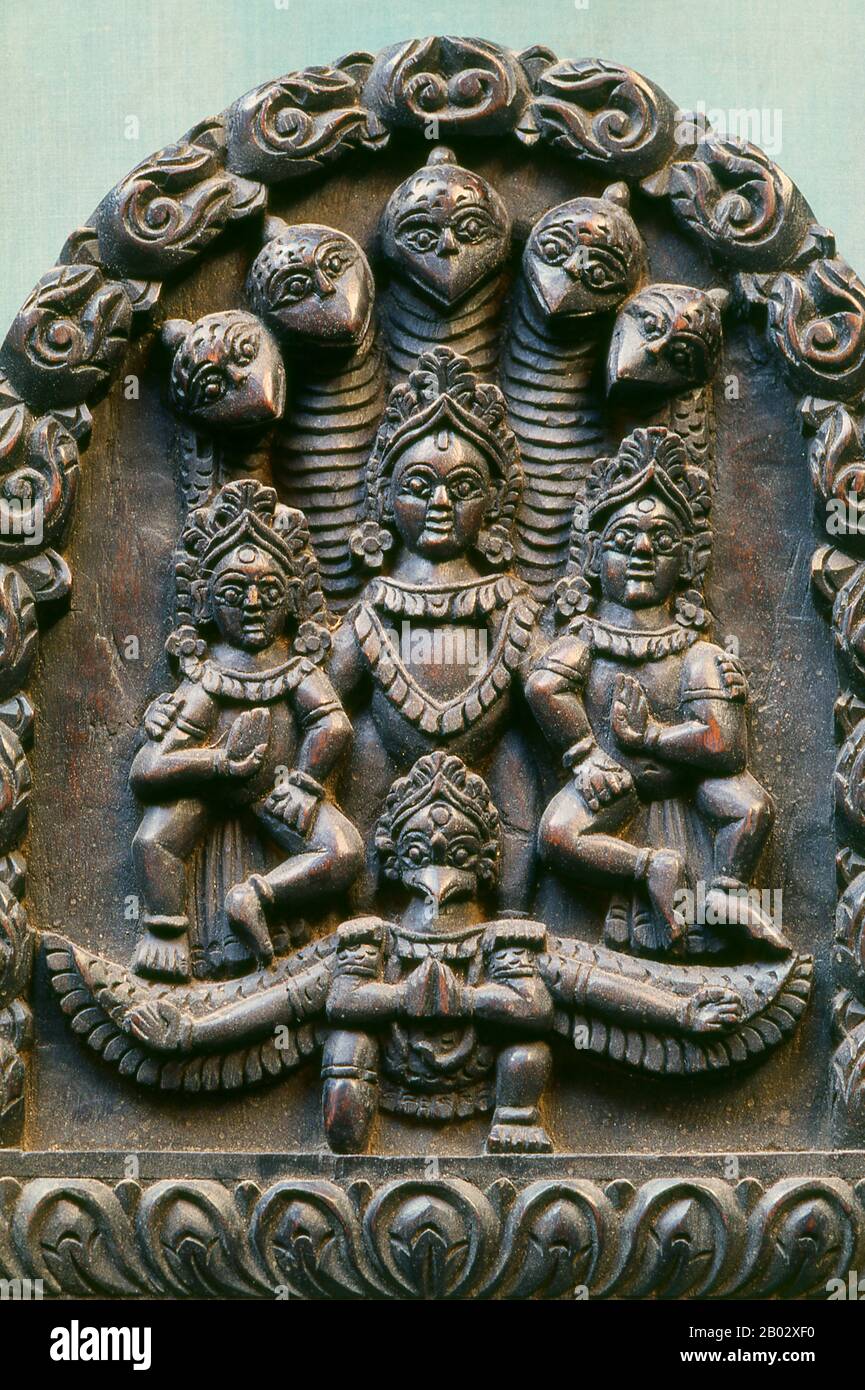 Vishnu (Sanskrit विष्णु Viṣṇu) is the Supreme god in the Vaishnavite tradition of Hinduism. Smarta followers of Adi Shankara, among others, venerate Vishnu as one of the five primary forms of God. The Vishnu Sahasranama declares Vishnu as Paramatma (supreme soul) and Parameshwara (supreme God). It describes Vishnu as the All-Pervading essence of all beings, the master of - and beyond - the past, present and future, one who supports, sustains and governs the Universe and originates and develops all elements within. Vishnu governs the aspect of preservation and sustenance of the universe, so he Stock Photohttps://www.alamy.com/image-license-details/?v=1https://www.alamy.com/vishnu-sanskrit-viu-is-the-supreme-god-in-the-vaishnavite-tradition-of-hinduism-smarta-followers-of-adi-shankara-among-others-venerate-vishnu-as-one-of-the-five-primary-forms-of-god-the-vishnu-sahasranama-declares-vishnu-as-paramatma-supreme-soul-and-parameshwara-supreme-god-it-describes-vishnu-as-the-all-pervading-essence-of-all-beings-the-master-of-and-beyond-the-past-present-and-future-one-who-supports-sustains-and-governs-the-universe-and-originates-and-develops-all-elements-within-vishnu-governs-the-aspect-of-preservation-and-sustenance-of-the-universe-so-he-image344272068.html
Vishnu (Sanskrit विष्णु Viṣṇu) is the Supreme god in the Vaishnavite tradition of Hinduism. Smarta followers of Adi Shankara, among others, venerate Vishnu as one of the five primary forms of God. The Vishnu Sahasranama declares Vishnu as Paramatma (supreme soul) and Parameshwara (supreme God). It describes Vishnu as the All-Pervading essence of all beings, the master of - and beyond - the past, present and future, one who supports, sustains and governs the Universe and originates and develops all elements within. Vishnu governs the aspect of preservation and sustenance of the universe, so he Stock Photohttps://www.alamy.com/image-license-details/?v=1https://www.alamy.com/vishnu-sanskrit-viu-is-the-supreme-god-in-the-vaishnavite-tradition-of-hinduism-smarta-followers-of-adi-shankara-among-others-venerate-vishnu-as-one-of-the-five-primary-forms-of-god-the-vishnu-sahasranama-declares-vishnu-as-paramatma-supreme-soul-and-parameshwara-supreme-god-it-describes-vishnu-as-the-all-pervading-essence-of-all-beings-the-master-of-and-beyond-the-past-present-and-future-one-who-supports-sustains-and-governs-the-universe-and-originates-and-develops-all-elements-within-vishnu-governs-the-aspect-of-preservation-and-sustenance-of-the-universe-so-he-image344272068.htmlRM2B02XF0–Vishnu (Sanskrit विष्णु Viṣṇu) is the Supreme god in the Vaishnavite tradition of Hinduism. Smarta followers of Adi Shankara, among others, venerate Vishnu as one of the five primary forms of God. The Vishnu Sahasranama declares Vishnu as Paramatma (supreme soul) and Parameshwara (supreme God). It describes Vishnu as the All-Pervading essence of all beings, the master of - and beyond - the past, present and future, one who supports, sustains and governs the Universe and originates and develops all elements within. Vishnu governs the aspect of preservation and sustenance of the universe, so he
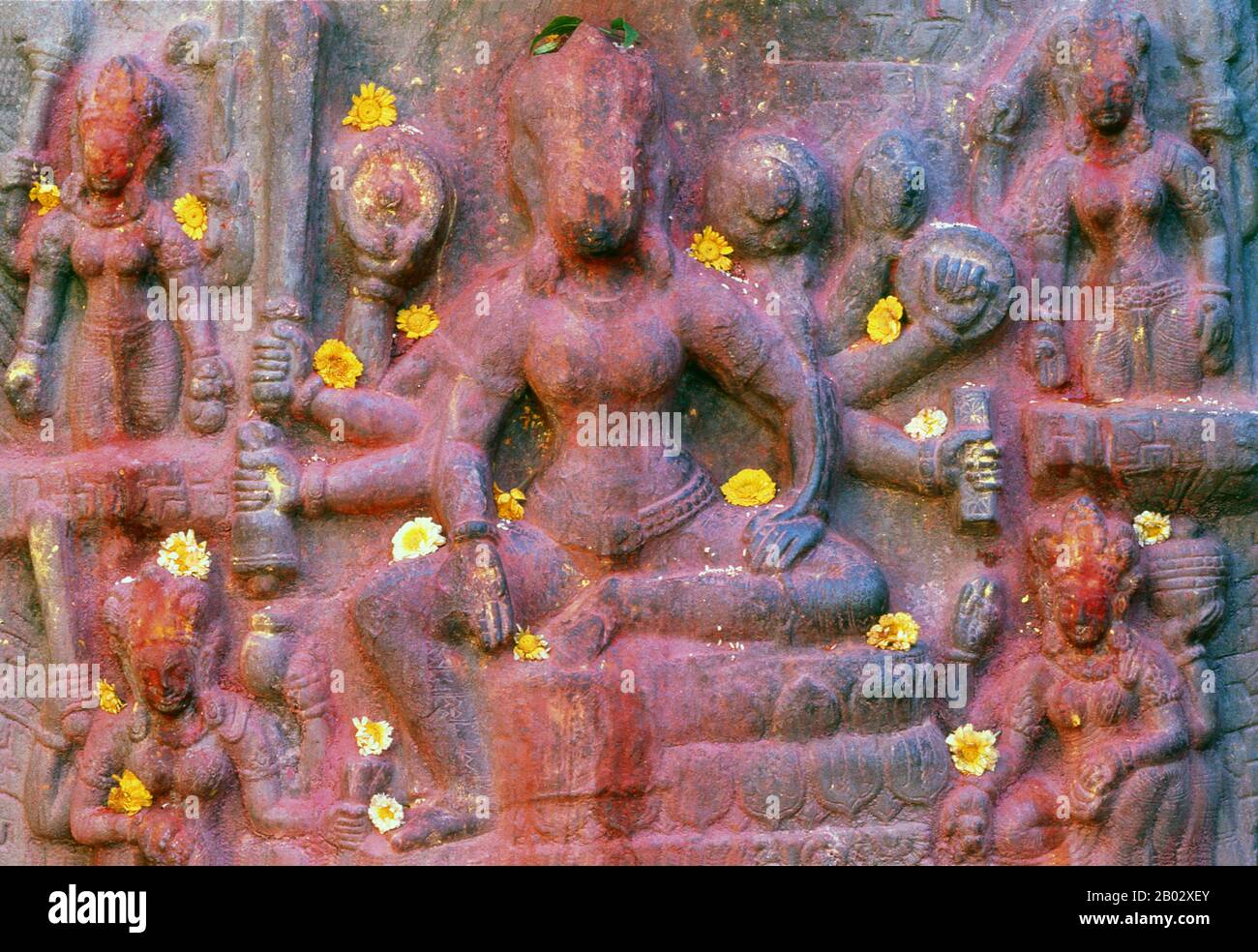 Vishnu (Sanskrit विष्णु Viṣṇu) is the Supreme god in the Vaishnavite tradition of Hinduism. Smarta followers of Adi Shankara, among others, venerate Vishnu as one of the five primary forms of God. The Vishnu Sahasranama declares Vishnu as Paramatma (supreme soul) and Parameshwara (supreme God). It describes Vishnu as the All-Pervading essence of all beings, the master of - and beyond - the past, present and future, one who supports, sustains and governs the Universe and originates and develops all elements within. Vishnu governs the aspect of preservation and sustenance of the universe, so he Stock Photohttps://www.alamy.com/image-license-details/?v=1https://www.alamy.com/vishnu-sanskrit-viu-is-the-supreme-god-in-the-vaishnavite-tradition-of-hinduism-smarta-followers-of-adi-shankara-among-others-venerate-vishnu-as-one-of-the-five-primary-forms-of-god-the-vishnu-sahasranama-declares-vishnu-as-paramatma-supreme-soul-and-parameshwara-supreme-god-it-describes-vishnu-as-the-all-pervading-essence-of-all-beings-the-master-of-and-beyond-the-past-present-and-future-one-who-supports-sustains-and-governs-the-universe-and-originates-and-develops-all-elements-within-vishnu-governs-the-aspect-of-preservation-and-sustenance-of-the-universe-so-he-image344272067.html
Vishnu (Sanskrit विष्णु Viṣṇu) is the Supreme god in the Vaishnavite tradition of Hinduism. Smarta followers of Adi Shankara, among others, venerate Vishnu as one of the five primary forms of God. The Vishnu Sahasranama declares Vishnu as Paramatma (supreme soul) and Parameshwara (supreme God). It describes Vishnu as the All-Pervading essence of all beings, the master of - and beyond - the past, present and future, one who supports, sustains and governs the Universe and originates and develops all elements within. Vishnu governs the aspect of preservation and sustenance of the universe, so he Stock Photohttps://www.alamy.com/image-license-details/?v=1https://www.alamy.com/vishnu-sanskrit-viu-is-the-supreme-god-in-the-vaishnavite-tradition-of-hinduism-smarta-followers-of-adi-shankara-among-others-venerate-vishnu-as-one-of-the-five-primary-forms-of-god-the-vishnu-sahasranama-declares-vishnu-as-paramatma-supreme-soul-and-parameshwara-supreme-god-it-describes-vishnu-as-the-all-pervading-essence-of-all-beings-the-master-of-and-beyond-the-past-present-and-future-one-who-supports-sustains-and-governs-the-universe-and-originates-and-develops-all-elements-within-vishnu-governs-the-aspect-of-preservation-and-sustenance-of-the-universe-so-he-image344272067.htmlRM2B02XEY–Vishnu (Sanskrit विष्णु Viṣṇu) is the Supreme god in the Vaishnavite tradition of Hinduism. Smarta followers of Adi Shankara, among others, venerate Vishnu as one of the five primary forms of God. The Vishnu Sahasranama declares Vishnu as Paramatma (supreme soul) and Parameshwara (supreme God). It describes Vishnu as the All-Pervading essence of all beings, the master of - and beyond - the past, present and future, one who supports, sustains and governs the Universe and originates and develops all elements within. Vishnu governs the aspect of preservation and sustenance of the universe, so he
 Kutch (often spelled Kachch) is the northwestern part of the Indian state of Gujarat, divided from the main part of the state by the Arabian Sea and a stretch of salt marshes. To its north lies the Pakistani province of Sind. The name Kutch is said to be derived from the Kachelas, a sub-caste of the lohar (blacksmiths’) or soni (goldsmiths’) castes. Stock Photohttps://www.alamy.com/image-license-details/?v=1https://www.alamy.com/kutch-often-spelled-kachch-is-the-northwestern-part-of-the-indian-state-of-gujarat-divided-from-the-main-part-of-the-state-by-the-arabian-sea-and-a-stretch-of-salt-marshes-to-its-north-lies-the-pakistani-province-of-sind-the-name-kutch-is-said-to-be-derived-from-the-kachelas-a-sub-caste-of-the-lohar-blacksmiths-or-soni-goldsmiths-castes-image344279230.html
Kutch (often spelled Kachch) is the northwestern part of the Indian state of Gujarat, divided from the main part of the state by the Arabian Sea and a stretch of salt marshes. To its north lies the Pakistani province of Sind. The name Kutch is said to be derived from the Kachelas, a sub-caste of the lohar (blacksmiths’) or soni (goldsmiths’) castes. Stock Photohttps://www.alamy.com/image-license-details/?v=1https://www.alamy.com/kutch-often-spelled-kachch-is-the-northwestern-part-of-the-indian-state-of-gujarat-divided-from-the-main-part-of-the-state-by-the-arabian-sea-and-a-stretch-of-salt-marshes-to-its-north-lies-the-pakistani-province-of-sind-the-name-kutch-is-said-to-be-derived-from-the-kachelas-a-sub-caste-of-the-lohar-blacksmiths-or-soni-goldsmiths-castes-image344279230.htmlRM2B037JP–Kutch (often spelled Kachch) is the northwestern part of the Indian state of Gujarat, divided from the main part of the state by the Arabian Sea and a stretch of salt marshes. To its north lies the Pakistani province of Sind. The name Kutch is said to be derived from the Kachelas, a sub-caste of the lohar (blacksmiths’) or soni (goldsmiths’) castes.
 The Jain's sacred site of Shatrunjaya contains hundreds of Palitana temples built mostly between the 11th Century and 16th Century CE. The Shatrunjaya Hills were sanctified when Rishabha, the first tirthankara (omniscient Teaching God) of Jainism, gave his first sermon in the temple on the hill top. The ancient history of the hills is also traced to Pundarika Swami, a chief Ganadhara and grandson of Rishabha, who attained salvation here. His shrine located opposite to the main Adinath temple, built by his son Bharata, is also worshiped by pilgrims. Stock Photohttps://www.alamy.com/image-license-details/?v=1https://www.alamy.com/the-jains-sacred-site-of-shatrunjaya-contains-hundreds-of-palitana-temples-built-mostly-between-the-11th-century-and-16th-century-ce-the-shatrunjaya-hills-were-sanctified-when-rishabha-the-first-tirthankara-omniscient-teaching-god-of-jainism-gave-his-first-sermon-in-the-temple-on-the-hill-top-the-ancient-history-of-the-hills-is-also-traced-to-pundarika-swami-a-chief-ganadhara-and-grandson-of-rishabha-who-attained-salvation-here-his-shrine-located-opposite-to-the-main-adinath-temple-built-by-his-son-bharata-is-also-worshiped-by-pilgrims-image344277476.html
The Jain's sacred site of Shatrunjaya contains hundreds of Palitana temples built mostly between the 11th Century and 16th Century CE. The Shatrunjaya Hills were sanctified when Rishabha, the first tirthankara (omniscient Teaching God) of Jainism, gave his first sermon in the temple on the hill top. The ancient history of the hills is also traced to Pundarika Swami, a chief Ganadhara and grandson of Rishabha, who attained salvation here. His shrine located opposite to the main Adinath temple, built by his son Bharata, is also worshiped by pilgrims. Stock Photohttps://www.alamy.com/image-license-details/?v=1https://www.alamy.com/the-jains-sacred-site-of-shatrunjaya-contains-hundreds-of-palitana-temples-built-mostly-between-the-11th-century-and-16th-century-ce-the-shatrunjaya-hills-were-sanctified-when-rishabha-the-first-tirthankara-omniscient-teaching-god-of-jainism-gave-his-first-sermon-in-the-temple-on-the-hill-top-the-ancient-history-of-the-hills-is-also-traced-to-pundarika-swami-a-chief-ganadhara-and-grandson-of-rishabha-who-attained-salvation-here-his-shrine-located-opposite-to-the-main-adinath-temple-built-by-his-son-bharata-is-also-worshiped-by-pilgrims-image344277476.htmlRM2B035C4–The Jain's sacred site of Shatrunjaya contains hundreds of Palitana temples built mostly between the 11th Century and 16th Century CE. The Shatrunjaya Hills were sanctified when Rishabha, the first tirthankara (omniscient Teaching God) of Jainism, gave his first sermon in the temple on the hill top. The ancient history of the hills is also traced to Pundarika Swami, a chief Ganadhara and grandson of Rishabha, who attained salvation here. His shrine located opposite to the main Adinath temple, built by his son Bharata, is also worshiped by pilgrims.
 The Jain's sacred site of Shatrunjaya contains hundreds of Palitana temples built mostly between the 11th Century and 16th Century CE. The Shatrunjaya Hills were sanctified when Rishabha, the first tirthankara (omniscient Teaching God) of Jainism, gave his first sermon in the temple on the hill top. The ancient history of the hills is also traced to Pundarika Swami, a chief Ganadhara and grandson of Rishabha, who attained salvation here. His shrine located opposite to the main Adinath temple, built by his son Bharata, is also worshiped by pilgrims. Stock Photohttps://www.alamy.com/image-license-details/?v=1https://www.alamy.com/the-jains-sacred-site-of-shatrunjaya-contains-hundreds-of-palitana-temples-built-mostly-between-the-11th-century-and-16th-century-ce-the-shatrunjaya-hills-were-sanctified-when-rishabha-the-first-tirthankara-omniscient-teaching-god-of-jainism-gave-his-first-sermon-in-the-temple-on-the-hill-top-the-ancient-history-of-the-hills-is-also-traced-to-pundarika-swami-a-chief-ganadhara-and-grandson-of-rishabha-who-attained-salvation-here-his-shrine-located-opposite-to-the-main-adinath-temple-built-by-his-son-bharata-is-also-worshiped-by-pilgrims-image344277473.html
The Jain's sacred site of Shatrunjaya contains hundreds of Palitana temples built mostly between the 11th Century and 16th Century CE. The Shatrunjaya Hills were sanctified when Rishabha, the first tirthankara (omniscient Teaching God) of Jainism, gave his first sermon in the temple on the hill top. The ancient history of the hills is also traced to Pundarika Swami, a chief Ganadhara and grandson of Rishabha, who attained salvation here. His shrine located opposite to the main Adinath temple, built by his son Bharata, is also worshiped by pilgrims. Stock Photohttps://www.alamy.com/image-license-details/?v=1https://www.alamy.com/the-jains-sacred-site-of-shatrunjaya-contains-hundreds-of-palitana-temples-built-mostly-between-the-11th-century-and-16th-century-ce-the-shatrunjaya-hills-were-sanctified-when-rishabha-the-first-tirthankara-omniscient-teaching-god-of-jainism-gave-his-first-sermon-in-the-temple-on-the-hill-top-the-ancient-history-of-the-hills-is-also-traced-to-pundarika-swami-a-chief-ganadhara-and-grandson-of-rishabha-who-attained-salvation-here-his-shrine-located-opposite-to-the-main-adinath-temple-built-by-his-son-bharata-is-also-worshiped-by-pilgrims-image344277473.htmlRM2B035C1–The Jain's sacred site of Shatrunjaya contains hundreds of Palitana temples built mostly between the 11th Century and 16th Century CE. The Shatrunjaya Hills were sanctified when Rishabha, the first tirthankara (omniscient Teaching God) of Jainism, gave his first sermon in the temple on the hill top. The ancient history of the hills is also traced to Pundarika Swami, a chief Ganadhara and grandson of Rishabha, who attained salvation here. His shrine located opposite to the main Adinath temple, built by his son Bharata, is also worshiped by pilgrims.
 In the 15th century, the Portuguese explored the sea route to India and Pope Nicholas V enacted the Papal bull Romanus Pontifex. This bull granted the patronage of the propagation of the Christian faith in Asia to the Portuguese and rewarded them with a trade monopoly for newly discovered areas. After Vasco da Gama arrived at Calicut on the coast of Kerala in India in 1498, the trade became prosperous. In 1510, the Portuguese wrested Goa from the Sultan of Bijapur and finally established themselves in Goa. By 1544, they conquered the districts of Bardez and Salcette in Goa. In 1534, the Arch Stock Photohttps://www.alamy.com/image-license-details/?v=1https://www.alamy.com/in-the-15th-century-the-portuguese-explored-the-sea-route-to-india-and-pope-nicholas-v-enacted-the-papal-bull-romanus-pontifex-this-bull-granted-the-patronage-of-the-propagation-of-the-christian-faith-in-asia-to-the-portuguese-and-rewarded-them-with-a-trade-monopoly-for-newly-discovered-areas-after-vasco-da-gama-arrived-at-calicut-on-the-coast-of-kerala-in-india-in-1498-the-trade-became-prosperous-in-1510-the-portuguese-wrested-goa-from-the-sultan-of-bijapur-and-finally-established-themselves-in-goa-by-1544-they-conquered-the-districts-of-bardez-and-salcette-in-goa-in-1534-the-arch-image344275708.html
In the 15th century, the Portuguese explored the sea route to India and Pope Nicholas V enacted the Papal bull Romanus Pontifex. This bull granted the patronage of the propagation of the Christian faith in Asia to the Portuguese and rewarded them with a trade monopoly for newly discovered areas. After Vasco da Gama arrived at Calicut on the coast of Kerala in India in 1498, the trade became prosperous. In 1510, the Portuguese wrested Goa from the Sultan of Bijapur and finally established themselves in Goa. By 1544, they conquered the districts of Bardez and Salcette in Goa. In 1534, the Arch Stock Photohttps://www.alamy.com/image-license-details/?v=1https://www.alamy.com/in-the-15th-century-the-portuguese-explored-the-sea-route-to-india-and-pope-nicholas-v-enacted-the-papal-bull-romanus-pontifex-this-bull-granted-the-patronage-of-the-propagation-of-the-christian-faith-in-asia-to-the-portuguese-and-rewarded-them-with-a-trade-monopoly-for-newly-discovered-areas-after-vasco-da-gama-arrived-at-calicut-on-the-coast-of-kerala-in-india-in-1498-the-trade-became-prosperous-in-1510-the-portuguese-wrested-goa-from-the-sultan-of-bijapur-and-finally-established-themselves-in-goa-by-1544-they-conquered-the-districts-of-bardez-and-salcette-in-goa-in-1534-the-arch-image344275708.htmlRM2B03350–In the 15th century, the Portuguese explored the sea route to India and Pope Nicholas V enacted the Papal bull Romanus Pontifex. This bull granted the patronage of the propagation of the Christian faith in Asia to the Portuguese and rewarded them with a trade monopoly for newly discovered areas. After Vasco da Gama arrived at Calicut on the coast of Kerala in India in 1498, the trade became prosperous. In 1510, the Portuguese wrested Goa from the Sultan of Bijapur and finally established themselves in Goa. By 1544, they conquered the districts of Bardez and Salcette in Goa. In 1534, the Arch
 The construction of the Mahabuddha Temple, located in a claustrophobic narrow courtyard, was begun in 1585 during the reign of King Mahendra Malla by a Newari Brahman called Abhayaraja Shakya. Abhayaraja had spent three years on a pilgrimage to Bodh Gaya in India, the place where Buddha is said to have attained enlightenment. On his return, Abhayaraja brought with him a Buddha statue for which he endeavored to build a temple similar to the famous Mahabodhi Temple in Bodh Gaya. Stock Photohttps://www.alamy.com/image-license-details/?v=1https://www.alamy.com/the-construction-of-the-mahabuddha-temple-located-in-a-claustrophobic-narrow-courtyard-was-begun-in-1585-during-the-reign-of-king-mahendra-malla-by-a-newari-brahman-called-abhayaraja-shakya-abhayaraja-had-spent-three-years-on-a-pilgrimage-to-bodh-gaya-in-india-the-place-where-buddha-is-said-to-have-attained-enlightenment-on-his-return-abhayaraja-brought-with-him-a-buddha-statue-for-which-he-endeavored-to-build-a-temple-similar-to-the-famous-mahabodhi-temple-in-bodh-gaya-image344272395.html
The construction of the Mahabuddha Temple, located in a claustrophobic narrow courtyard, was begun in 1585 during the reign of King Mahendra Malla by a Newari Brahman called Abhayaraja Shakya. Abhayaraja had spent three years on a pilgrimage to Bodh Gaya in India, the place where Buddha is said to have attained enlightenment. On his return, Abhayaraja brought with him a Buddha statue for which he endeavored to build a temple similar to the famous Mahabodhi Temple in Bodh Gaya. Stock Photohttps://www.alamy.com/image-license-details/?v=1https://www.alamy.com/the-construction-of-the-mahabuddha-temple-located-in-a-claustrophobic-narrow-courtyard-was-begun-in-1585-during-the-reign-of-king-mahendra-malla-by-a-newari-brahman-called-abhayaraja-shakya-abhayaraja-had-spent-three-years-on-a-pilgrimage-to-bodh-gaya-in-india-the-place-where-buddha-is-said-to-have-attained-enlightenment-on-his-return-abhayaraja-brought-with-him-a-buddha-statue-for-which-he-endeavored-to-build-a-temple-similar-to-the-famous-mahabodhi-temple-in-bodh-gaya-image344272395.htmlRM2B02XXK–The construction of the Mahabuddha Temple, located in a claustrophobic narrow courtyard, was begun in 1585 during the reign of King Mahendra Malla by a Newari Brahman called Abhayaraja Shakya. Abhayaraja had spent three years on a pilgrimage to Bodh Gaya in India, the place where Buddha is said to have attained enlightenment. On his return, Abhayaraja brought with him a Buddha statue for which he endeavored to build a temple similar to the famous Mahabodhi Temple in Bodh Gaya.
 The construction of the Mahabuddha Temple, located in a claustrophobic narrow courtyard, was begun in 1585 during the reign of King Mahendra Malla by a Newari Brahman called Abhayaraja Shakya. Abhayaraja had spent three years on a pilgrimage to Bodh Gaya in India, the place where Buddha is said to have attained enlightenment. On his return, Abhayaraja brought with him a Buddha statue for which he endeavored to build a temple similar to the famous Mahabodhi Temple in Bodh Gaya. Stock Photohttps://www.alamy.com/image-license-details/?v=1https://www.alamy.com/the-construction-of-the-mahabuddha-temple-located-in-a-claustrophobic-narrow-courtyard-was-begun-in-1585-during-the-reign-of-king-mahendra-malla-by-a-newari-brahman-called-abhayaraja-shakya-abhayaraja-had-spent-three-years-on-a-pilgrimage-to-bodh-gaya-in-india-the-place-where-buddha-is-said-to-have-attained-enlightenment-on-his-return-abhayaraja-brought-with-him-a-buddha-statue-for-which-he-endeavored-to-build-a-temple-similar-to-the-famous-mahabodhi-temple-in-bodh-gaya-image344272551.html
The construction of the Mahabuddha Temple, located in a claustrophobic narrow courtyard, was begun in 1585 during the reign of King Mahendra Malla by a Newari Brahman called Abhayaraja Shakya. Abhayaraja had spent three years on a pilgrimage to Bodh Gaya in India, the place where Buddha is said to have attained enlightenment. On his return, Abhayaraja brought with him a Buddha statue for which he endeavored to build a temple similar to the famous Mahabodhi Temple in Bodh Gaya. Stock Photohttps://www.alamy.com/image-license-details/?v=1https://www.alamy.com/the-construction-of-the-mahabuddha-temple-located-in-a-claustrophobic-narrow-courtyard-was-begun-in-1585-during-the-reign-of-king-mahendra-malla-by-a-newari-brahman-called-abhayaraja-shakya-abhayaraja-had-spent-three-years-on-a-pilgrimage-to-bodh-gaya-in-india-the-place-where-buddha-is-said-to-have-attained-enlightenment-on-his-return-abhayaraja-brought-with-him-a-buddha-statue-for-which-he-endeavored-to-build-a-temple-similar-to-the-famous-mahabodhi-temple-in-bodh-gaya-image344272551.htmlRM2B02Y47–The construction of the Mahabuddha Temple, located in a claustrophobic narrow courtyard, was begun in 1585 during the reign of King Mahendra Malla by a Newari Brahman called Abhayaraja Shakya. Abhayaraja had spent three years on a pilgrimage to Bodh Gaya in India, the place where Buddha is said to have attained enlightenment. On his return, Abhayaraja brought with him a Buddha statue for which he endeavored to build a temple similar to the famous Mahabodhi Temple in Bodh Gaya.
 The Jain's sacred site of Shatrunjaya contains hundreds of Palitana temples built mostly between the 11th Century and 16th Century CE. The Shatrunjaya Hills were sanctified when Rishabha, the first tirthankara (omniscient Teaching God) of Jainism, gave his first sermon in the temple on the hill top. The ancient history of the hills is also traced to Pundarika Swami, a chief Ganadhara and grandson of Rishabha, who attained salvation here. His shrine located opposite to the main Adinath temple, built by his son Bharata, is also worshiped by pilgrims. Stock Photohttps://www.alamy.com/image-license-details/?v=1https://www.alamy.com/the-jains-sacred-site-of-shatrunjaya-contains-hundreds-of-palitana-temples-built-mostly-between-the-11th-century-and-16th-century-ce-the-shatrunjaya-hills-were-sanctified-when-rishabha-the-first-tirthankara-omniscient-teaching-god-of-jainism-gave-his-first-sermon-in-the-temple-on-the-hill-top-the-ancient-history-of-the-hills-is-also-traced-to-pundarika-swami-a-chief-ganadhara-and-grandson-of-rishabha-who-attained-salvation-here-his-shrine-located-opposite-to-the-main-adinath-temple-built-by-his-son-bharata-is-also-worshiped-by-pilgrims-image344277245.html
The Jain's sacred site of Shatrunjaya contains hundreds of Palitana temples built mostly between the 11th Century and 16th Century CE. The Shatrunjaya Hills were sanctified when Rishabha, the first tirthankara (omniscient Teaching God) of Jainism, gave his first sermon in the temple on the hill top. The ancient history of the hills is also traced to Pundarika Swami, a chief Ganadhara and grandson of Rishabha, who attained salvation here. His shrine located opposite to the main Adinath temple, built by his son Bharata, is also worshiped by pilgrims. Stock Photohttps://www.alamy.com/image-license-details/?v=1https://www.alamy.com/the-jains-sacred-site-of-shatrunjaya-contains-hundreds-of-palitana-temples-built-mostly-between-the-11th-century-and-16th-century-ce-the-shatrunjaya-hills-were-sanctified-when-rishabha-the-first-tirthankara-omniscient-teaching-god-of-jainism-gave-his-first-sermon-in-the-temple-on-the-hill-top-the-ancient-history-of-the-hills-is-also-traced-to-pundarika-swami-a-chief-ganadhara-and-grandson-of-rishabha-who-attained-salvation-here-his-shrine-located-opposite-to-the-main-adinath-temple-built-by-his-son-bharata-is-also-worshiped-by-pilgrims-image344277245.htmlRM2B0353W–The Jain's sacred site of Shatrunjaya contains hundreds of Palitana temples built mostly between the 11th Century and 16th Century CE. The Shatrunjaya Hills were sanctified when Rishabha, the first tirthankara (omniscient Teaching God) of Jainism, gave his first sermon in the temple on the hill top. The ancient history of the hills is also traced to Pundarika Swami, a chief Ganadhara and grandson of Rishabha, who attained salvation here. His shrine located opposite to the main Adinath temple, built by his son Bharata, is also worshiped by pilgrims.
 The Jain's sacred site of Shatrunjaya contains hundreds of Palitana temples built mostly between the 11th Century and 16th Century CE. The Shatrunjaya Hills were sanctified when Rishabha, the first tirthankara (omniscient Teaching God) of Jainism, gave his first sermon in the temple on the hill top. The ancient history of the hills is also traced to Pundarika Swami, a chief Ganadhara and grandson of Rishabha, who attained salvation here. His shrine located opposite to the main Adinath temple, built by his son Bharata, is also worshiped by pilgrims. Stock Photohttps://www.alamy.com/image-license-details/?v=1https://www.alamy.com/the-jains-sacred-site-of-shatrunjaya-contains-hundreds-of-palitana-temples-built-mostly-between-the-11th-century-and-16th-century-ce-the-shatrunjaya-hills-were-sanctified-when-rishabha-the-first-tirthankara-omniscient-teaching-god-of-jainism-gave-his-first-sermon-in-the-temple-on-the-hill-top-the-ancient-history-of-the-hills-is-also-traced-to-pundarika-swami-a-chief-ganadhara-and-grandson-of-rishabha-who-attained-salvation-here-his-shrine-located-opposite-to-the-main-adinath-temple-built-by-his-son-bharata-is-also-worshiped-by-pilgrims-image344277294.html
The Jain's sacred site of Shatrunjaya contains hundreds of Palitana temples built mostly between the 11th Century and 16th Century CE. The Shatrunjaya Hills were sanctified when Rishabha, the first tirthankara (omniscient Teaching God) of Jainism, gave his first sermon in the temple on the hill top. The ancient history of the hills is also traced to Pundarika Swami, a chief Ganadhara and grandson of Rishabha, who attained salvation here. His shrine located opposite to the main Adinath temple, built by his son Bharata, is also worshiped by pilgrims. Stock Photohttps://www.alamy.com/image-license-details/?v=1https://www.alamy.com/the-jains-sacred-site-of-shatrunjaya-contains-hundreds-of-palitana-temples-built-mostly-between-the-11th-century-and-16th-century-ce-the-shatrunjaya-hills-were-sanctified-when-rishabha-the-first-tirthankara-omniscient-teaching-god-of-jainism-gave-his-first-sermon-in-the-temple-on-the-hill-top-the-ancient-history-of-the-hills-is-also-traced-to-pundarika-swami-a-chief-ganadhara-and-grandson-of-rishabha-who-attained-salvation-here-his-shrine-located-opposite-to-the-main-adinath-temple-built-by-his-son-bharata-is-also-worshiped-by-pilgrims-image344277294.htmlRM2B0355J–The Jain's sacred site of Shatrunjaya contains hundreds of Palitana temples built mostly between the 11th Century and 16th Century CE. The Shatrunjaya Hills were sanctified when Rishabha, the first tirthankara (omniscient Teaching God) of Jainism, gave his first sermon in the temple on the hill top. The ancient history of the hills is also traced to Pundarika Swami, a chief Ganadhara and grandson of Rishabha, who attained salvation here. His shrine located opposite to the main Adinath temple, built by his son Bharata, is also worshiped by pilgrims.
 The Jain's sacred site of Shatrunjaya contains hundreds of Palitana temples built mostly between the 11th Century and 16th Century CE. The Shatrunjaya Hills were sanctified when Rishabha, the first tirthankara (omniscient Teaching God) of Jainism, gave his first sermon in the temple on the hill top. The ancient history of the hills is also traced to Pundarika Swami, a chief Ganadhara and grandson of Rishabha, who attained salvation here. His shrine located opposite to the main Adinath temple, built by his son Bharata, is also worshiped by pilgrims. Stock Photohttps://www.alamy.com/image-license-details/?v=1https://www.alamy.com/the-jains-sacred-site-of-shatrunjaya-contains-hundreds-of-palitana-temples-built-mostly-between-the-11th-century-and-16th-century-ce-the-shatrunjaya-hills-were-sanctified-when-rishabha-the-first-tirthankara-omniscient-teaching-god-of-jainism-gave-his-first-sermon-in-the-temple-on-the-hill-top-the-ancient-history-of-the-hills-is-also-traced-to-pundarika-swami-a-chief-ganadhara-and-grandson-of-rishabha-who-attained-salvation-here-his-shrine-located-opposite-to-the-main-adinath-temple-built-by-his-son-bharata-is-also-worshiped-by-pilgrims-image344277267.html
The Jain's sacred site of Shatrunjaya contains hundreds of Palitana temples built mostly between the 11th Century and 16th Century CE. The Shatrunjaya Hills were sanctified when Rishabha, the first tirthankara (omniscient Teaching God) of Jainism, gave his first sermon in the temple on the hill top. The ancient history of the hills is also traced to Pundarika Swami, a chief Ganadhara and grandson of Rishabha, who attained salvation here. His shrine located opposite to the main Adinath temple, built by his son Bharata, is also worshiped by pilgrims. Stock Photohttps://www.alamy.com/image-license-details/?v=1https://www.alamy.com/the-jains-sacred-site-of-shatrunjaya-contains-hundreds-of-palitana-temples-built-mostly-between-the-11th-century-and-16th-century-ce-the-shatrunjaya-hills-were-sanctified-when-rishabha-the-first-tirthankara-omniscient-teaching-god-of-jainism-gave-his-first-sermon-in-the-temple-on-the-hill-top-the-ancient-history-of-the-hills-is-also-traced-to-pundarika-swami-a-chief-ganadhara-and-grandson-of-rishabha-who-attained-salvation-here-his-shrine-located-opposite-to-the-main-adinath-temple-built-by-his-son-bharata-is-also-worshiped-by-pilgrims-image344277267.htmlRM2B0354K–The Jain's sacred site of Shatrunjaya contains hundreds of Palitana temples built mostly between the 11th Century and 16th Century CE. The Shatrunjaya Hills were sanctified when Rishabha, the first tirthankara (omniscient Teaching God) of Jainism, gave his first sermon in the temple on the hill top. The ancient history of the hills is also traced to Pundarika Swami, a chief Ganadhara and grandson of Rishabha, who attained salvation here. His shrine located opposite to the main Adinath temple, built by his son Bharata, is also worshiped by pilgrims.
 The Jain's sacred site of Shatrunjaya contains hundreds of Palitana temples built mostly between the 11th Century and 16th Century CE. The Shatrunjaya Hills were sanctified when Rishabha, the first tirthankara (omniscient Teaching God) of Jainism, gave his first sermon in the temple on the hill top. The ancient history of the hills is also traced to Pundarika Swami, a chief Ganadhara and grandson of Rishabha, who attained salvation here. His shrine located opposite to the main Adinath temple, built by his son Bharata, is also worshiped by pilgrims. Stock Photohttps://www.alamy.com/image-license-details/?v=1https://www.alamy.com/the-jains-sacred-site-of-shatrunjaya-contains-hundreds-of-palitana-temples-built-mostly-between-the-11th-century-and-16th-century-ce-the-shatrunjaya-hills-were-sanctified-when-rishabha-the-first-tirthankara-omniscient-teaching-god-of-jainism-gave-his-first-sermon-in-the-temple-on-the-hill-top-the-ancient-history-of-the-hills-is-also-traced-to-pundarika-swami-a-chief-ganadhara-and-grandson-of-rishabha-who-attained-salvation-here-his-shrine-located-opposite-to-the-main-adinath-temple-built-by-his-son-bharata-is-also-worshiped-by-pilgrims-image344277235.html
The Jain's sacred site of Shatrunjaya contains hundreds of Palitana temples built mostly between the 11th Century and 16th Century CE. The Shatrunjaya Hills were sanctified when Rishabha, the first tirthankara (omniscient Teaching God) of Jainism, gave his first sermon in the temple on the hill top. The ancient history of the hills is also traced to Pundarika Swami, a chief Ganadhara and grandson of Rishabha, who attained salvation here. His shrine located opposite to the main Adinath temple, built by his son Bharata, is also worshiped by pilgrims. Stock Photohttps://www.alamy.com/image-license-details/?v=1https://www.alamy.com/the-jains-sacred-site-of-shatrunjaya-contains-hundreds-of-palitana-temples-built-mostly-between-the-11th-century-and-16th-century-ce-the-shatrunjaya-hills-were-sanctified-when-rishabha-the-first-tirthankara-omniscient-teaching-god-of-jainism-gave-his-first-sermon-in-the-temple-on-the-hill-top-the-ancient-history-of-the-hills-is-also-traced-to-pundarika-swami-a-chief-ganadhara-and-grandson-of-rishabha-who-attained-salvation-here-his-shrine-located-opposite-to-the-main-adinath-temple-built-by-his-son-bharata-is-also-worshiped-by-pilgrims-image344277235.htmlRM2B0353F–The Jain's sacred site of Shatrunjaya contains hundreds of Palitana temples built mostly between the 11th Century and 16th Century CE. The Shatrunjaya Hills were sanctified when Rishabha, the first tirthankara (omniscient Teaching God) of Jainism, gave his first sermon in the temple on the hill top. The ancient history of the hills is also traced to Pundarika Swami, a chief Ganadhara and grandson of Rishabha, who attained salvation here. His shrine located opposite to the main Adinath temple, built by his son Bharata, is also worshiped by pilgrims.
 The Jain's sacred site of Shatrunjaya contains hundreds of Palitana temples built mostly between the 11th Century and 16th Century CE. The Shatrunjaya Hills were sanctified when Rishabha, the first tirthankara (omniscient Teaching God) of Jainism, gave his first sermon in the temple on the hill top. The ancient history of the hills is also traced to Pundarika Swami, a chief Ganadhara and grandson of Rishabha, who attained salvation here. His shrine located opposite to the main Adinath temple, built by his son Bharata, is also worshiped by pilgrims. Stock Photohttps://www.alamy.com/image-license-details/?v=1https://www.alamy.com/the-jains-sacred-site-of-shatrunjaya-contains-hundreds-of-palitana-temples-built-mostly-between-the-11th-century-and-16th-century-ce-the-shatrunjaya-hills-were-sanctified-when-rishabha-the-first-tirthankara-omniscient-teaching-god-of-jainism-gave-his-first-sermon-in-the-temple-on-the-hill-top-the-ancient-history-of-the-hills-is-also-traced-to-pundarika-swami-a-chief-ganadhara-and-grandson-of-rishabha-who-attained-salvation-here-his-shrine-located-opposite-to-the-main-adinath-temple-built-by-his-son-bharata-is-also-worshiped-by-pilgrims-image344277268.html
The Jain's sacred site of Shatrunjaya contains hundreds of Palitana temples built mostly between the 11th Century and 16th Century CE. The Shatrunjaya Hills were sanctified when Rishabha, the first tirthankara (omniscient Teaching God) of Jainism, gave his first sermon in the temple on the hill top. The ancient history of the hills is also traced to Pundarika Swami, a chief Ganadhara and grandson of Rishabha, who attained salvation here. His shrine located opposite to the main Adinath temple, built by his son Bharata, is also worshiped by pilgrims. Stock Photohttps://www.alamy.com/image-license-details/?v=1https://www.alamy.com/the-jains-sacred-site-of-shatrunjaya-contains-hundreds-of-palitana-temples-built-mostly-between-the-11th-century-and-16th-century-ce-the-shatrunjaya-hills-were-sanctified-when-rishabha-the-first-tirthankara-omniscient-teaching-god-of-jainism-gave-his-first-sermon-in-the-temple-on-the-hill-top-the-ancient-history-of-the-hills-is-also-traced-to-pundarika-swami-a-chief-ganadhara-and-grandson-of-rishabha-who-attained-salvation-here-his-shrine-located-opposite-to-the-main-adinath-temple-built-by-his-son-bharata-is-also-worshiped-by-pilgrims-image344277268.htmlRM2B0354M–The Jain's sacred site of Shatrunjaya contains hundreds of Palitana temples built mostly between the 11th Century and 16th Century CE. The Shatrunjaya Hills were sanctified when Rishabha, the first tirthankara (omniscient Teaching God) of Jainism, gave his first sermon in the temple on the hill top. The ancient history of the hills is also traced to Pundarika Swami, a chief Ganadhara and grandson of Rishabha, who attained salvation here. His shrine located opposite to the main Adinath temple, built by his son Bharata, is also worshiped by pilgrims.
 The Jain's sacred site of Shatrunjaya contains hundreds of Palitana temples built mostly between the 11th Century and 16th Century CE. The Shatrunjaya Hills were sanctified when Rishabha, the first tirthankara (omniscient Teaching God) of Jainism, gave his first sermon in the temple on the hill top. The ancient history of the hills is also traced to Pundarika Swami, a chief Ganadhara and grandson of Rishabha, who attained salvation here. His shrine located opposite to the main Adinath temple, built by his son Bharata, is also worshiped by pilgrims. Stock Photohttps://www.alamy.com/image-license-details/?v=1https://www.alamy.com/the-jains-sacred-site-of-shatrunjaya-contains-hundreds-of-palitana-temples-built-mostly-between-the-11th-century-and-16th-century-ce-the-shatrunjaya-hills-were-sanctified-when-rishabha-the-first-tirthankara-omniscient-teaching-god-of-jainism-gave-his-first-sermon-in-the-temple-on-the-hill-top-the-ancient-history-of-the-hills-is-also-traced-to-pundarika-swami-a-chief-ganadhara-and-grandson-of-rishabha-who-attained-salvation-here-his-shrine-located-opposite-to-the-main-adinath-temple-built-by-his-son-bharata-is-also-worshiped-by-pilgrims-image344277236.html
The Jain's sacred site of Shatrunjaya contains hundreds of Palitana temples built mostly between the 11th Century and 16th Century CE. The Shatrunjaya Hills were sanctified when Rishabha, the first tirthankara (omniscient Teaching God) of Jainism, gave his first sermon in the temple on the hill top. The ancient history of the hills is also traced to Pundarika Swami, a chief Ganadhara and grandson of Rishabha, who attained salvation here. His shrine located opposite to the main Adinath temple, built by his son Bharata, is also worshiped by pilgrims. Stock Photohttps://www.alamy.com/image-license-details/?v=1https://www.alamy.com/the-jains-sacred-site-of-shatrunjaya-contains-hundreds-of-palitana-temples-built-mostly-between-the-11th-century-and-16th-century-ce-the-shatrunjaya-hills-were-sanctified-when-rishabha-the-first-tirthankara-omniscient-teaching-god-of-jainism-gave-his-first-sermon-in-the-temple-on-the-hill-top-the-ancient-history-of-the-hills-is-also-traced-to-pundarika-swami-a-chief-ganadhara-and-grandson-of-rishabha-who-attained-salvation-here-his-shrine-located-opposite-to-the-main-adinath-temple-built-by-his-son-bharata-is-also-worshiped-by-pilgrims-image344277236.htmlRM2B0353G–The Jain's sacred site of Shatrunjaya contains hundreds of Palitana temples built mostly between the 11th Century and 16th Century CE. The Shatrunjaya Hills were sanctified when Rishabha, the first tirthankara (omniscient Teaching God) of Jainism, gave his first sermon in the temple on the hill top. The ancient history of the hills is also traced to Pundarika Swami, a chief Ganadhara and grandson of Rishabha, who attained salvation here. His shrine located opposite to the main Adinath temple, built by his son Bharata, is also worshiped by pilgrims.
 The Jain's sacred site of Shatrunjaya contains hundreds of Palitana temples built mostly between the 11th Century and 16th Century CE. The Shatrunjaya Hills were sanctified when Rishabha, the first tirthankara (omniscient Teaching God) of Jainism, gave his first sermon in the temple on the hill top. The ancient history of the hills is also traced to Pundarika Swami, a chief Ganadhara and grandson of Rishabha, who attained salvation here. His shrine located opposite to the main Adinath temple, built by his son Bharata, is also worshiped by pilgrims. Stock Photohttps://www.alamy.com/image-license-details/?v=1https://www.alamy.com/the-jains-sacred-site-of-shatrunjaya-contains-hundreds-of-palitana-temples-built-mostly-between-the-11th-century-and-16th-century-ce-the-shatrunjaya-hills-were-sanctified-when-rishabha-the-first-tirthankara-omniscient-teaching-god-of-jainism-gave-his-first-sermon-in-the-temple-on-the-hill-top-the-ancient-history-of-the-hills-is-also-traced-to-pundarika-swami-a-chief-ganadhara-and-grandson-of-rishabha-who-attained-salvation-here-his-shrine-located-opposite-to-the-main-adinath-temple-built-by-his-son-bharata-is-also-worshiped-by-pilgrims-image344277521.html
The Jain's sacred site of Shatrunjaya contains hundreds of Palitana temples built mostly between the 11th Century and 16th Century CE. The Shatrunjaya Hills were sanctified when Rishabha, the first tirthankara (omniscient Teaching God) of Jainism, gave his first sermon in the temple on the hill top. The ancient history of the hills is also traced to Pundarika Swami, a chief Ganadhara and grandson of Rishabha, who attained salvation here. His shrine located opposite to the main Adinath temple, built by his son Bharata, is also worshiped by pilgrims. Stock Photohttps://www.alamy.com/image-license-details/?v=1https://www.alamy.com/the-jains-sacred-site-of-shatrunjaya-contains-hundreds-of-palitana-temples-built-mostly-between-the-11th-century-and-16th-century-ce-the-shatrunjaya-hills-were-sanctified-when-rishabha-the-first-tirthankara-omniscient-teaching-god-of-jainism-gave-his-first-sermon-in-the-temple-on-the-hill-top-the-ancient-history-of-the-hills-is-also-traced-to-pundarika-swami-a-chief-ganadhara-and-grandson-of-rishabha-who-attained-salvation-here-his-shrine-located-opposite-to-the-main-adinath-temple-built-by-his-son-bharata-is-also-worshiped-by-pilgrims-image344277521.htmlRM2B035DN–The Jain's sacred site of Shatrunjaya contains hundreds of Palitana temples built mostly between the 11th Century and 16th Century CE. The Shatrunjaya Hills were sanctified when Rishabha, the first tirthankara (omniscient Teaching God) of Jainism, gave his first sermon in the temple on the hill top. The ancient history of the hills is also traced to Pundarika Swami, a chief Ganadhara and grandson of Rishabha, who attained salvation here. His shrine located opposite to the main Adinath temple, built by his son Bharata, is also worshiped by pilgrims.
 The Jain's sacred site of Shatrunjaya contains hundreds of Palitana temples built mostly between the 11th Century and 16th Century CE. The Shatrunjaya Hills were sanctified when Rishabha, the first tirthankara (omniscient Teaching God) of Jainism, gave his first sermon in the temple on the hill top. The ancient history of the hills is also traced to Pundarika Swami, a chief Ganadhara and grandson of Rishabha, who attained salvation here. His shrine located opposite to the main Adinath temple, built by his son Bharata, is also worshiped by pilgrims. Stock Photohttps://www.alamy.com/image-license-details/?v=1https://www.alamy.com/the-jains-sacred-site-of-shatrunjaya-contains-hundreds-of-palitana-temples-built-mostly-between-the-11th-century-and-16th-century-ce-the-shatrunjaya-hills-were-sanctified-when-rishabha-the-first-tirthankara-omniscient-teaching-god-of-jainism-gave-his-first-sermon-in-the-temple-on-the-hill-top-the-ancient-history-of-the-hills-is-also-traced-to-pundarika-swami-a-chief-ganadhara-and-grandson-of-rishabha-who-attained-salvation-here-his-shrine-located-opposite-to-the-main-adinath-temple-built-by-his-son-bharata-is-also-worshiped-by-pilgrims-image344277244.html
The Jain's sacred site of Shatrunjaya contains hundreds of Palitana temples built mostly between the 11th Century and 16th Century CE. The Shatrunjaya Hills were sanctified when Rishabha, the first tirthankara (omniscient Teaching God) of Jainism, gave his first sermon in the temple on the hill top. The ancient history of the hills is also traced to Pundarika Swami, a chief Ganadhara and grandson of Rishabha, who attained salvation here. His shrine located opposite to the main Adinath temple, built by his son Bharata, is also worshiped by pilgrims. Stock Photohttps://www.alamy.com/image-license-details/?v=1https://www.alamy.com/the-jains-sacred-site-of-shatrunjaya-contains-hundreds-of-palitana-temples-built-mostly-between-the-11th-century-and-16th-century-ce-the-shatrunjaya-hills-were-sanctified-when-rishabha-the-first-tirthankara-omniscient-teaching-god-of-jainism-gave-his-first-sermon-in-the-temple-on-the-hill-top-the-ancient-history-of-the-hills-is-also-traced-to-pundarika-swami-a-chief-ganadhara-and-grandson-of-rishabha-who-attained-salvation-here-his-shrine-located-opposite-to-the-main-adinath-temple-built-by-his-son-bharata-is-also-worshiped-by-pilgrims-image344277244.htmlRM2B0353T–The Jain's sacred site of Shatrunjaya contains hundreds of Palitana temples built mostly between the 11th Century and 16th Century CE. The Shatrunjaya Hills were sanctified when Rishabha, the first tirthankara (omniscient Teaching God) of Jainism, gave his first sermon in the temple on the hill top. The ancient history of the hills is also traced to Pundarika Swami, a chief Ganadhara and grandson of Rishabha, who attained salvation here. His shrine located opposite to the main Adinath temple, built by his son Bharata, is also worshiped by pilgrims.
 The Jain's sacred site of Shatrunjaya contains hundreds of Palitana temples built mostly between the 11th Century and 16th Century CE. The Shatrunjaya Hills were sanctified when Rishabha, the first tirthankara (omniscient Teaching God) of Jainism, gave his first sermon in the temple on the hill top. The ancient history of the hills is also traced to Pundarika Swami, a chief Ganadhara and grandson of Rishabha, who attained salvation here. His shrine located opposite to the main Adinath temple, built by his son Bharata, is also worshiped by pilgrims. Stock Photohttps://www.alamy.com/image-license-details/?v=1https://www.alamy.com/the-jains-sacred-site-of-shatrunjaya-contains-hundreds-of-palitana-temples-built-mostly-between-the-11th-century-and-16th-century-ce-the-shatrunjaya-hills-were-sanctified-when-rishabha-the-first-tirthankara-omniscient-teaching-god-of-jainism-gave-his-first-sermon-in-the-temple-on-the-hill-top-the-ancient-history-of-the-hills-is-also-traced-to-pundarika-swami-a-chief-ganadhara-and-grandson-of-rishabha-who-attained-salvation-here-his-shrine-located-opposite-to-the-main-adinath-temple-built-by-his-son-bharata-is-also-worshiped-by-pilgrims-image344277270.html
The Jain's sacred site of Shatrunjaya contains hundreds of Palitana temples built mostly between the 11th Century and 16th Century CE. The Shatrunjaya Hills were sanctified when Rishabha, the first tirthankara (omniscient Teaching God) of Jainism, gave his first sermon in the temple on the hill top. The ancient history of the hills is also traced to Pundarika Swami, a chief Ganadhara and grandson of Rishabha, who attained salvation here. His shrine located opposite to the main Adinath temple, built by his son Bharata, is also worshiped by pilgrims. Stock Photohttps://www.alamy.com/image-license-details/?v=1https://www.alamy.com/the-jains-sacred-site-of-shatrunjaya-contains-hundreds-of-palitana-temples-built-mostly-between-the-11th-century-and-16th-century-ce-the-shatrunjaya-hills-were-sanctified-when-rishabha-the-first-tirthankara-omniscient-teaching-god-of-jainism-gave-his-first-sermon-in-the-temple-on-the-hill-top-the-ancient-history-of-the-hills-is-also-traced-to-pundarika-swami-a-chief-ganadhara-and-grandson-of-rishabha-who-attained-salvation-here-his-shrine-located-opposite-to-the-main-adinath-temple-built-by-his-son-bharata-is-also-worshiped-by-pilgrims-image344277270.htmlRM2B0354P–The Jain's sacred site of Shatrunjaya contains hundreds of Palitana temples built mostly between the 11th Century and 16th Century CE. The Shatrunjaya Hills were sanctified when Rishabha, the first tirthankara (omniscient Teaching God) of Jainism, gave his first sermon in the temple on the hill top. The ancient history of the hills is also traced to Pundarika Swami, a chief Ganadhara and grandson of Rishabha, who attained salvation here. His shrine located opposite to the main Adinath temple, built by his son Bharata, is also worshiped by pilgrims.
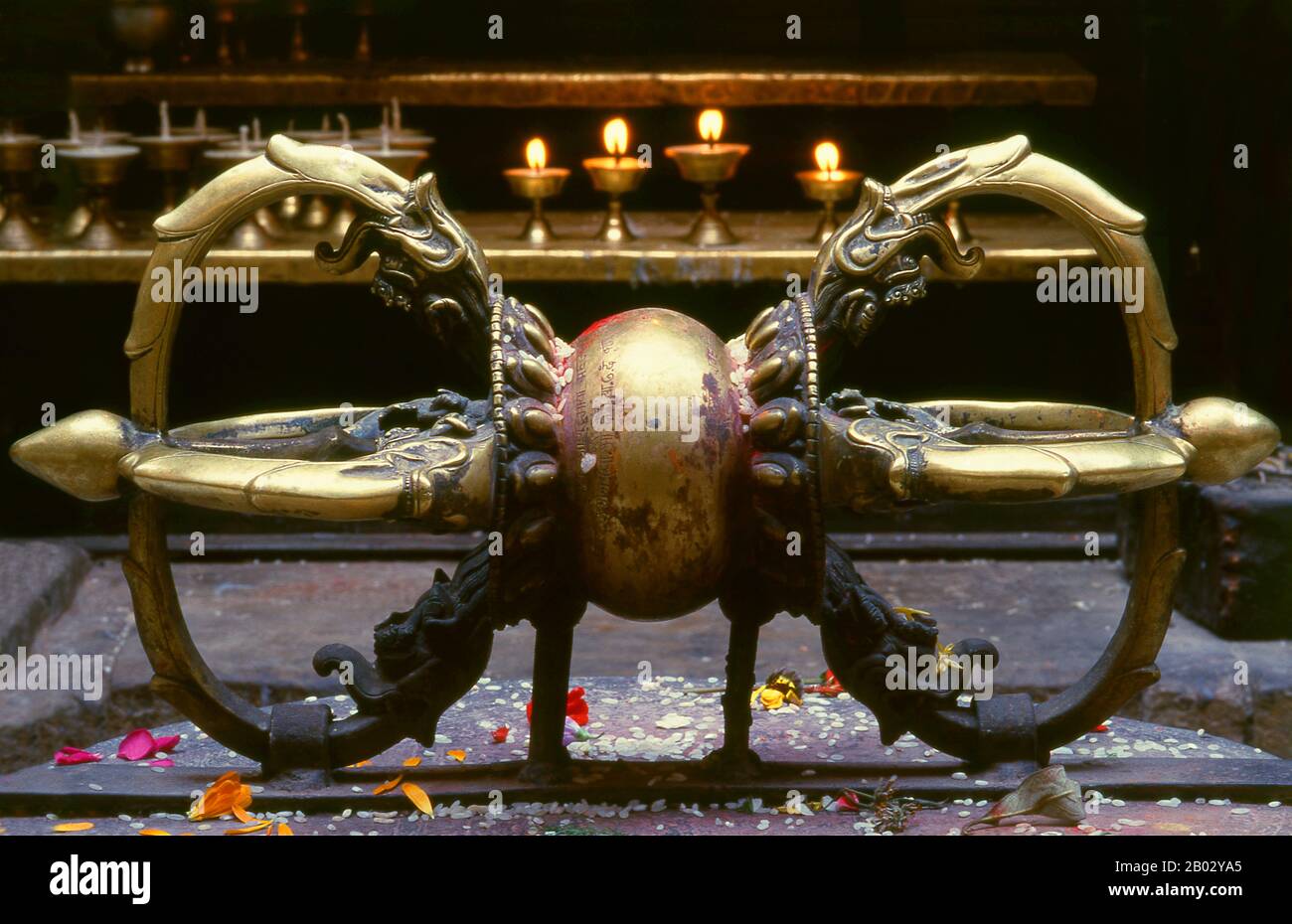 The construction of the Mahabuddha Temple, located in a claustrophobically narrow courtyard, was begun in 1585 during the reign of King Mahendra Malla by a Newari Brahman called Abhayaraja Shakya. Abhayaraja had spent three years on a pilgrimage to Bodh Gaya in India, the place where Buddha is said to have attained enlightenment. On his return, Abhayaraja brought with him a Buddha statue for which he endeavoured to build a temple similar to the famous Mahabodhi Temple in Bodh Gaya. Well-prepared for the task, Abhayaraja carried with him a model of the original temple in India, which was to be Stock Photohttps://www.alamy.com/image-license-details/?v=1https://www.alamy.com/the-construction-of-the-mahabuddha-temple-located-in-a-claustrophobically-narrow-courtyard-was-begun-in-1585-during-the-reign-of-king-mahendra-malla-by-a-newari-brahman-called-abhayaraja-shakya-abhayaraja-had-spent-three-years-on-a-pilgrimage-to-bodh-gaya-in-india-the-place-where-buddha-is-said-to-have-attained-enlightenment-on-his-return-abhayaraja-brought-with-him-a-buddha-statue-for-which-he-endeavoured-to-build-a-temple-similar-to-the-famous-mahabodhi-temple-in-bodh-gaya-well-prepared-for-the-task-abhayaraja-carried-with-him-a-model-of-the-original-temple-in-india-which-was-to-be-image344272717.html
The construction of the Mahabuddha Temple, located in a claustrophobically narrow courtyard, was begun in 1585 during the reign of King Mahendra Malla by a Newari Brahman called Abhayaraja Shakya. Abhayaraja had spent three years on a pilgrimage to Bodh Gaya in India, the place where Buddha is said to have attained enlightenment. On his return, Abhayaraja brought with him a Buddha statue for which he endeavoured to build a temple similar to the famous Mahabodhi Temple in Bodh Gaya. Well-prepared for the task, Abhayaraja carried with him a model of the original temple in India, which was to be Stock Photohttps://www.alamy.com/image-license-details/?v=1https://www.alamy.com/the-construction-of-the-mahabuddha-temple-located-in-a-claustrophobically-narrow-courtyard-was-begun-in-1585-during-the-reign-of-king-mahendra-malla-by-a-newari-brahman-called-abhayaraja-shakya-abhayaraja-had-spent-three-years-on-a-pilgrimage-to-bodh-gaya-in-india-the-place-where-buddha-is-said-to-have-attained-enlightenment-on-his-return-abhayaraja-brought-with-him-a-buddha-statue-for-which-he-endeavoured-to-build-a-temple-similar-to-the-famous-mahabodhi-temple-in-bodh-gaya-well-prepared-for-the-task-abhayaraja-carried-with-him-a-model-of-the-original-temple-in-india-which-was-to-be-image344272717.htmlRM2B02YA5–The construction of the Mahabuddha Temple, located in a claustrophobically narrow courtyard, was begun in 1585 during the reign of King Mahendra Malla by a Newari Brahman called Abhayaraja Shakya. Abhayaraja had spent three years on a pilgrimage to Bodh Gaya in India, the place where Buddha is said to have attained enlightenment. On his return, Abhayaraja brought with him a Buddha statue for which he endeavoured to build a temple similar to the famous Mahabodhi Temple in Bodh Gaya. Well-prepared for the task, Abhayaraja carried with him a model of the original temple in India, which was to be
 Mahishasura's father Rambha was king of the asuras, and he once fell in love with Princess Mahishi, who was cursed to be a water buffalo; Mahishasura was born out of this union. He is, therefore, able to change between human and buffalo form at will (mahisha is Sanskrit word for buffalo). Stock Photohttps://www.alamy.com/image-license-details/?v=1https://www.alamy.com/mahishasuras-father-rambha-was-king-of-the-asuras-and-he-once-fell-in-love-with-princess-mahishi-who-was-cursed-to-be-a-water-buffalo-mahishasura-was-born-out-of-this-union-he-is-therefore-able-to-change-between-human-and-buffalo-form-at-will-mahisha-is-sanskrit-word-for-buffalo-image344272052.html
Mahishasura's father Rambha was king of the asuras, and he once fell in love with Princess Mahishi, who was cursed to be a water buffalo; Mahishasura was born out of this union. He is, therefore, able to change between human and buffalo form at will (mahisha is Sanskrit word for buffalo). Stock Photohttps://www.alamy.com/image-license-details/?v=1https://www.alamy.com/mahishasuras-father-rambha-was-king-of-the-asuras-and-he-once-fell-in-love-with-princess-mahishi-who-was-cursed-to-be-a-water-buffalo-mahishasura-was-born-out-of-this-union-he-is-therefore-able-to-change-between-human-and-buffalo-form-at-will-mahisha-is-sanskrit-word-for-buffalo-image344272052.htmlRM2B02XEC–Mahishasura's father Rambha was king of the asuras, and he once fell in love with Princess Mahishi, who was cursed to be a water buffalo; Mahishasura was born out of this union. He is, therefore, able to change between human and buffalo form at will (mahisha is Sanskrit word for buffalo).
 Kandy is Sri Lanka's second biggest city with a population of around 170,000 and is the cultural centre of the whole island. For about two centuries (until 1815) it was the capital of Sri Lanka. Stock Photohttps://www.alamy.com/image-license-details/?v=1https://www.alamy.com/kandy-is-sri-lankas-second-biggest-city-with-a-population-of-around-170000-and-is-the-cultural-centre-of-the-whole-island-for-about-two-centuries-until-1815-it-was-the-capital-of-sri-lanka-image344280419.html
Kandy is Sri Lanka's second biggest city with a population of around 170,000 and is the cultural centre of the whole island. For about two centuries (until 1815) it was the capital of Sri Lanka. Stock Photohttps://www.alamy.com/image-license-details/?v=1https://www.alamy.com/kandy-is-sri-lankas-second-biggest-city-with-a-population-of-around-170000-and-is-the-cultural-centre-of-the-whole-island-for-about-two-centuries-until-1815-it-was-the-capital-of-sri-lanka-image344280419.htmlRM2B03957–Kandy is Sri Lanka's second biggest city with a population of around 170,000 and is the cultural centre of the whole island. For about two centuries (until 1815) it was the capital of Sri Lanka.
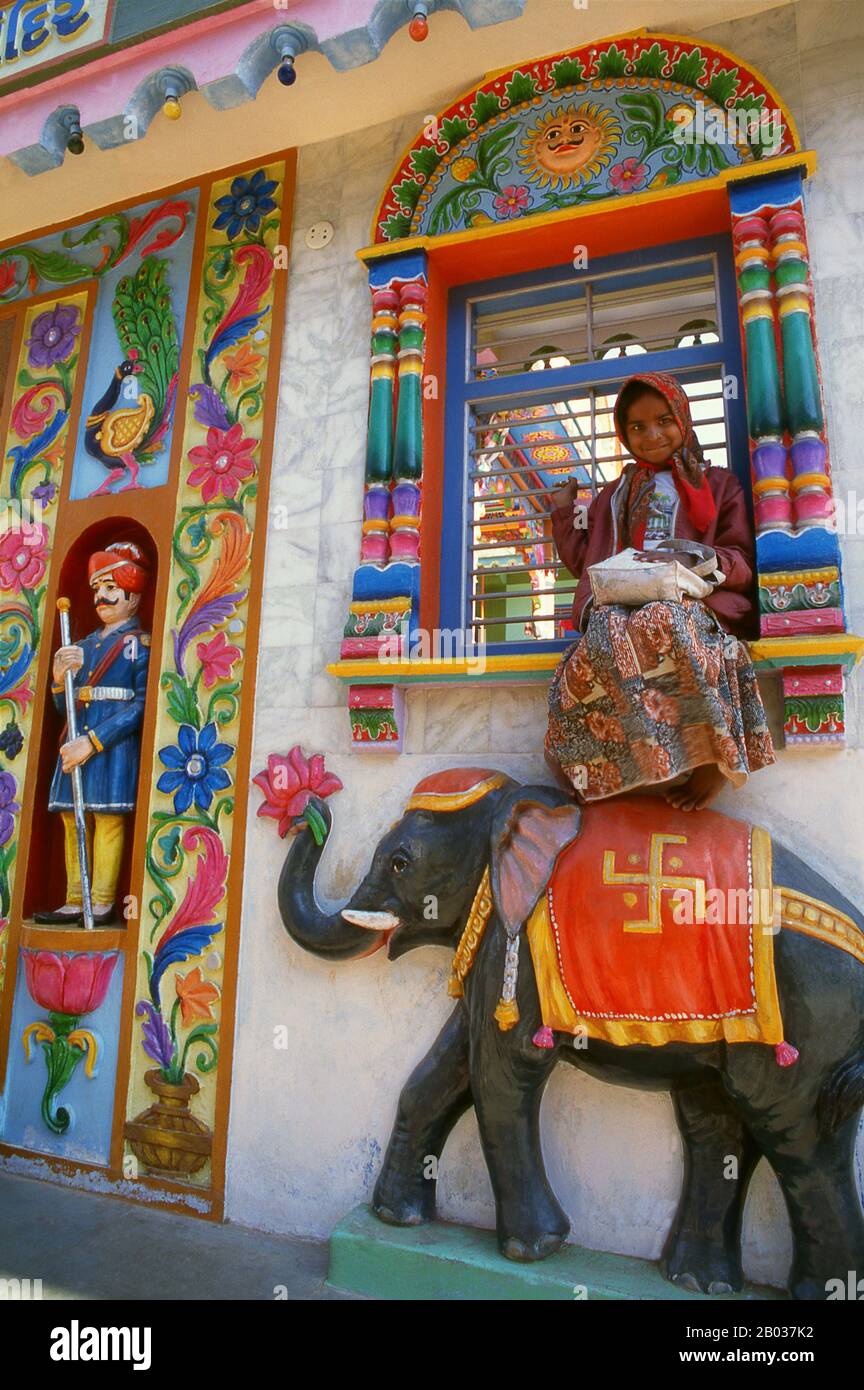 Kutch (often spelled Kachch) is the northwestern part of the Indian state of Gujarat, divided from the main part of the state by the Arabian Sea and a stretch of salt marshes. To its north lies the Pakistani province of Sind. The name Kutch is said to be derived from the Kachelas, a sub-caste of the lohar (blacksmiths’) or soni (goldsmiths’) castes. Stock Photohttps://www.alamy.com/image-license-details/?v=1https://www.alamy.com/kutch-often-spelled-kachch-is-the-northwestern-part-of-the-indian-state-of-gujarat-divided-from-the-main-part-of-the-state-by-the-arabian-sea-and-a-stretch-of-salt-marshes-to-its-north-lies-the-pakistani-province-of-sind-the-name-kutch-is-said-to-be-derived-from-the-kachelas-a-sub-caste-of-the-lohar-blacksmiths-or-soni-goldsmiths-castes-image344279238.html
Kutch (often spelled Kachch) is the northwestern part of the Indian state of Gujarat, divided from the main part of the state by the Arabian Sea and a stretch of salt marshes. To its north lies the Pakistani province of Sind. The name Kutch is said to be derived from the Kachelas, a sub-caste of the lohar (blacksmiths’) or soni (goldsmiths’) castes. Stock Photohttps://www.alamy.com/image-license-details/?v=1https://www.alamy.com/kutch-often-spelled-kachch-is-the-northwestern-part-of-the-indian-state-of-gujarat-divided-from-the-main-part-of-the-state-by-the-arabian-sea-and-a-stretch-of-salt-marshes-to-its-north-lies-the-pakistani-province-of-sind-the-name-kutch-is-said-to-be-derived-from-the-kachelas-a-sub-caste-of-the-lohar-blacksmiths-or-soni-goldsmiths-castes-image344279238.htmlRM2B037K2–Kutch (often spelled Kachch) is the northwestern part of the Indian state of Gujarat, divided from the main part of the state by the Arabian Sea and a stretch of salt marshes. To its north lies the Pakistani province of Sind. The name Kutch is said to be derived from the Kachelas, a sub-caste of the lohar (blacksmiths’) or soni (goldsmiths’) castes.
 In the 15th century, the Portuguese explored the sea route to India and Pope Nicholas V enacted the Papal bull Romanus Pontifex. This bull granted the patronage of the propagation of the Christian faith in Asia to the Portuguese and rewarded them with a trade monopoly for newly discovered areas. After Vasco da Gama arrived at Calicut on the coast of Kerala in India in 1498, the trade became prosperous. In 1510, the Portuguese wrested Goa from the Sultan of Bijapur and finally established themselves in Goa. By 1544, they conquered the districts of Bardez and Salcette in Goa. In 1534, the Arch Stock Photohttps://www.alamy.com/image-license-details/?v=1https://www.alamy.com/in-the-15th-century-the-portuguese-explored-the-sea-route-to-india-and-pope-nicholas-v-enacted-the-papal-bull-romanus-pontifex-this-bull-granted-the-patronage-of-the-propagation-of-the-christian-faith-in-asia-to-the-portuguese-and-rewarded-them-with-a-trade-monopoly-for-newly-discovered-areas-after-vasco-da-gama-arrived-at-calicut-on-the-coast-of-kerala-in-india-in-1498-the-trade-became-prosperous-in-1510-the-portuguese-wrested-goa-from-the-sultan-of-bijapur-and-finally-established-themselves-in-goa-by-1544-they-conquered-the-districts-of-bardez-and-salcette-in-goa-in-1534-the-arch-image344275696.html
In the 15th century, the Portuguese explored the sea route to India and Pope Nicholas V enacted the Papal bull Romanus Pontifex. This bull granted the patronage of the propagation of the Christian faith in Asia to the Portuguese and rewarded them with a trade monopoly for newly discovered areas. After Vasco da Gama arrived at Calicut on the coast of Kerala in India in 1498, the trade became prosperous. In 1510, the Portuguese wrested Goa from the Sultan of Bijapur and finally established themselves in Goa. By 1544, they conquered the districts of Bardez and Salcette in Goa. In 1534, the Arch Stock Photohttps://www.alamy.com/image-license-details/?v=1https://www.alamy.com/in-the-15th-century-the-portuguese-explored-the-sea-route-to-india-and-pope-nicholas-v-enacted-the-papal-bull-romanus-pontifex-this-bull-granted-the-patronage-of-the-propagation-of-the-christian-faith-in-asia-to-the-portuguese-and-rewarded-them-with-a-trade-monopoly-for-newly-discovered-areas-after-vasco-da-gama-arrived-at-calicut-on-the-coast-of-kerala-in-india-in-1498-the-trade-became-prosperous-in-1510-the-portuguese-wrested-goa-from-the-sultan-of-bijapur-and-finally-established-themselves-in-goa-by-1544-they-conquered-the-districts-of-bardez-and-salcette-in-goa-in-1534-the-arch-image344275696.htmlRM2B0334G–In the 15th century, the Portuguese explored the sea route to India and Pope Nicholas V enacted the Papal bull Romanus Pontifex. This bull granted the patronage of the propagation of the Christian faith in Asia to the Portuguese and rewarded them with a trade monopoly for newly discovered areas. After Vasco da Gama arrived at Calicut on the coast of Kerala in India in 1498, the trade became prosperous. In 1510, the Portuguese wrested Goa from the Sultan of Bijapur and finally established themselves in Goa. By 1544, they conquered the districts of Bardez and Salcette in Goa. In 1534, the Arch
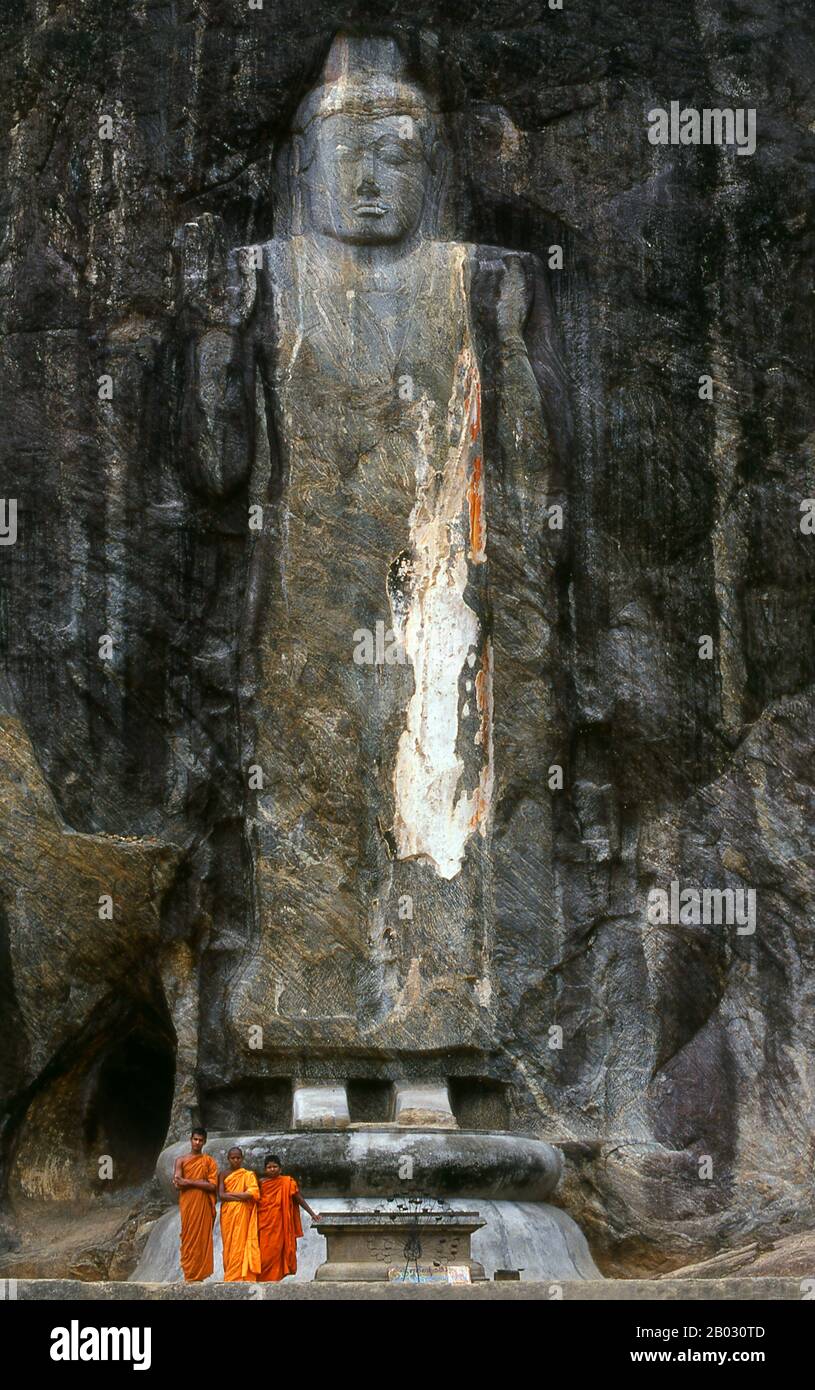 The remote ancient Buddhist site of Buduruvagala (which means ‘stone Buddha images’ in Sinhalese) is thought to date from the 10th century, when Mahayana Buddhism dominated parts of Sri Lanka. Carved into the rock face is a huge 16m-high Buddha figure, with three smaller figures on either side. These are thought to represent the Maitreya Buddha, Avalokitesvara and his consort Tara, as well as the Hindu god Vishnu. Stock Photohttps://www.alamy.com/image-license-details/?v=1https://www.alamy.com/the-remote-ancient-buddhist-site-of-buduruvagala-which-means-stone-buddha-images-in-sinhalese-is-thought-to-date-from-the-10th-century-when-mahayana-buddhism-dominated-parts-of-sri-lanka-carved-into-the-rock-face-is-a-huge-16m-high-buddha-figure-with-three-smaller-figures-on-either-side-these-are-thought-to-represent-the-maitreya-buddha-avalokitesvara-and-his-consort-tara-as-well-as-the-hindu-god-vishnu-image344273901.html
The remote ancient Buddhist site of Buduruvagala (which means ‘stone Buddha images’ in Sinhalese) is thought to date from the 10th century, when Mahayana Buddhism dominated parts of Sri Lanka. Carved into the rock face is a huge 16m-high Buddha figure, with three smaller figures on either side. These are thought to represent the Maitreya Buddha, Avalokitesvara and his consort Tara, as well as the Hindu god Vishnu. Stock Photohttps://www.alamy.com/image-license-details/?v=1https://www.alamy.com/the-remote-ancient-buddhist-site-of-buduruvagala-which-means-stone-buddha-images-in-sinhalese-is-thought-to-date-from-the-10th-century-when-mahayana-buddhism-dominated-parts-of-sri-lanka-carved-into-the-rock-face-is-a-huge-16m-high-buddha-figure-with-three-smaller-figures-on-either-side-these-are-thought-to-represent-the-maitreya-buddha-avalokitesvara-and-his-consort-tara-as-well-as-the-hindu-god-vishnu-image344273901.htmlRM2B030TD–The remote ancient Buddhist site of Buduruvagala (which means ‘stone Buddha images’ in Sinhalese) is thought to date from the 10th century, when Mahayana Buddhism dominated parts of Sri Lanka. Carved into the rock face is a huge 16m-high Buddha figure, with three smaller figures on either side. These are thought to represent the Maitreya Buddha, Avalokitesvara and his consort Tara, as well as the Hindu god Vishnu.
 The remote ancient Buddhist site of Bururuvagala (which means ‘stone Buddha images’ in Sinhalese) is thought to date from the 10th century, when Mahayana Buddhism dominated parts of Sri Lanka. Carved into the rock face is a huge 16m-high Buddha figure, with three smaller figures on either side. These are thought to represent the Maitreya Buddha, Avalokitesvara and his consort Tara, as well as the Hindu god Vishnu. Stock Photohttps://www.alamy.com/image-license-details/?v=1https://www.alamy.com/the-remote-ancient-buddhist-site-of-bururuvagala-which-means-stone-buddha-images-in-sinhalese-is-thought-to-date-from-the-10th-century-when-mahayana-buddhism-dominated-parts-of-sri-lanka-carved-into-the-rock-face-is-a-huge-16m-high-buddha-figure-with-three-smaller-figures-on-either-side-these-are-thought-to-represent-the-maitreya-buddha-avalokitesvara-and-his-consort-tara-as-well-as-the-hindu-god-vishnu-image344273630.html
The remote ancient Buddhist site of Bururuvagala (which means ‘stone Buddha images’ in Sinhalese) is thought to date from the 10th century, when Mahayana Buddhism dominated parts of Sri Lanka. Carved into the rock face is a huge 16m-high Buddha figure, with three smaller figures on either side. These are thought to represent the Maitreya Buddha, Avalokitesvara and his consort Tara, as well as the Hindu god Vishnu. Stock Photohttps://www.alamy.com/image-license-details/?v=1https://www.alamy.com/the-remote-ancient-buddhist-site-of-bururuvagala-which-means-stone-buddha-images-in-sinhalese-is-thought-to-date-from-the-10th-century-when-mahayana-buddhism-dominated-parts-of-sri-lanka-carved-into-the-rock-face-is-a-huge-16m-high-buddha-figure-with-three-smaller-figures-on-either-side-these-are-thought-to-represent-the-maitreya-buddha-avalokitesvara-and-his-consort-tara-as-well-as-the-hindu-god-vishnu-image344273630.htmlRM2B030EP–The remote ancient Buddhist site of Bururuvagala (which means ‘stone Buddha images’ in Sinhalese) is thought to date from the 10th century, when Mahayana Buddhism dominated parts of Sri Lanka. Carved into the rock face is a huge 16m-high Buddha figure, with three smaller figures on either side. These are thought to represent the Maitreya Buddha, Avalokitesvara and his consort Tara, as well as the Hindu god Vishnu.
 Diu town was historically part of the Saurashtra region of Gujarat and an important port on the trade routes of the Arabian sea and Indian Ocean. In 1535 Bahadur Shah, the Sultan of Gujarat, concluded a defensive alliance with the Portuguese against the Mughal emperor Humayun, and allowed the Portuguese to construct the Diu Fort and maintain a garrison on the island. The alliance quickly unraveled, and attempts by the Sultans to oust the Portuguese from Diu between 1537 and 1546 failed. Having repented of his generosity, Bahadur Shah sought to recover Diu, but was defeated and killed by the Stock Photohttps://www.alamy.com/image-license-details/?v=1https://www.alamy.com/diu-town-was-historically-part-of-the-saurashtra-region-of-gujarat-and-an-important-port-on-the-trade-routes-of-the-arabian-sea-and-indian-ocean-in-1535-bahadur-shah-the-sultan-of-gujarat-concluded-a-defensive-alliance-with-the-portuguese-against-the-mughal-emperor-humayun-and-allowed-the-portuguese-to-construct-the-diu-fort-and-maintain-a-garrison-on-the-island-the-alliance-quickly-unraveled-and-attempts-by-the-sultans-to-oust-the-portuguese-from-diu-between-1537-and-1546-failed-having-repented-of-his-generosity-bahadur-shah-sought-to-recover-diu-but-was-defeated-and-killed-by-the-image344279629.html
Diu town was historically part of the Saurashtra region of Gujarat and an important port on the trade routes of the Arabian sea and Indian Ocean. In 1535 Bahadur Shah, the Sultan of Gujarat, concluded a defensive alliance with the Portuguese against the Mughal emperor Humayun, and allowed the Portuguese to construct the Diu Fort and maintain a garrison on the island. The alliance quickly unraveled, and attempts by the Sultans to oust the Portuguese from Diu between 1537 and 1546 failed. Having repented of his generosity, Bahadur Shah sought to recover Diu, but was defeated and killed by the Stock Photohttps://www.alamy.com/image-license-details/?v=1https://www.alamy.com/diu-town-was-historically-part-of-the-saurashtra-region-of-gujarat-and-an-important-port-on-the-trade-routes-of-the-arabian-sea-and-indian-ocean-in-1535-bahadur-shah-the-sultan-of-gujarat-concluded-a-defensive-alliance-with-the-portuguese-against-the-mughal-emperor-humayun-and-allowed-the-portuguese-to-construct-the-diu-fort-and-maintain-a-garrison-on-the-island-the-alliance-quickly-unraveled-and-attempts-by-the-sultans-to-oust-the-portuguese-from-diu-between-1537-and-1546-failed-having-repented-of-his-generosity-bahadur-shah-sought-to-recover-diu-but-was-defeated-and-killed-by-the-image344279629.htmlRM2B03851–Diu town was historically part of the Saurashtra region of Gujarat and an important port on the trade routes of the Arabian sea and Indian Ocean. In 1535 Bahadur Shah, the Sultan of Gujarat, concluded a defensive alliance with the Portuguese against the Mughal emperor Humayun, and allowed the Portuguese to construct the Diu Fort and maintain a garrison on the island. The alliance quickly unraveled, and attempts by the Sultans to oust the Portuguese from Diu between 1537 and 1546 failed. Having repented of his generosity, Bahadur Shah sought to recover Diu, but was defeated and killed by the